Apple Business Strategy: Plans that made it a Multi-Trillion dollar Company

The study was first published on September 27, 2021, and then updated on September 18, 2023.
This strategy teardown compiles the ideas, innovations, technological research, partnerships, and, most importantly, the strategies responsible for Apple’s growth to such heights.
However, before we move forward, here is a small intro about Apple.
On Friday, June 30, 2023, Apple became the first company in history to reach a $3 trillion market valuation. It stays ahead by half a trillion dollars from the second most-valued company on the planet- Microsoft. Apple is now the most profitable technology corporation in the world.
Steve Jobs, Steve Wozniak, and Ronald Wayne founded Apple on the 1st of April 1976, bringing creativity to the table through their rendition of a personal computer. Apple is one of the world’s most popular and recognized labels. The company has experienced unparalleled revenue growth, from just $8 billion in 2004 to over $274B last year . This is more when compared to other technology giants out there today, such as Google ($181B) and Microsoft ($143B).
Apple’s growth could primarily be attributed to its business strategy. By combining its designing capabilities, hardware expertise, software prowess, and strategic acquisitions , the company has built an ecosystem that a user doesn’t want to leave.
Vertical integration is another main reason that distinguishes Apple from the competition. It has reaped enormous benefits from the vertical model. It has always built, controlled, and manufactured all of its hardware and software. This inherent benefit assists the corporation in achieving a higher degree of synergy between its hardware and applications. Even the apps are tightly controlled to follow Apple policies. The company also increased its spending on the cost of sales and product R&D to $26,251 billion, which was less than 18% of its total expenditure.
“We have fierce competition at the developer side and the customer side. It’s so competitive, I would describe it as a street fight for market share in the smartphone business.” – Tim Cook, CEO of Apple Inc.
Apple’s business strategy consists of the following four elements:
- Focus on product design and functionality
- Strengthening Apple’s ecosystem
- Improving consumer service experience
- Reducing the business’s reliance on iPhone sales
As for the product and service categories, Apple Inc. includes iPhone, Mac, iPad, Wearables, Home and Accessories, and Services like iMessage, FaceTime, Apple Maps, etc.
This study explores Apple’s business strategy that will help you acquire some basic principles that could be applied to any kind of business, even yours. So, if you’d like the entire analysis in PDF form that you can download and save for later reading (or sharing with your friends), just fill out the form below, and we’ll deliver it right to your inbox.
Now, let’s dive deep into the reasons behind Apple’s success.
Table of Contents

History of Apple
These products and strategies helped apple win before the launch of the iphone..
While the iMac sparked Apple’s rebirth in 1998, the introduction of the iPod in Oct 2001 sent the company to the top of the world’s most valuable companies list.
“With the iPod, Apple has invented a whole new category of digital music player that lets you put your entire music collection in your pocket and listen to it wherever you go,” said Steve Jobs, Apple’s CEO. “With iPod, listening to music will never be the same again.” We all know digital music players used to exist before the iPod, but as we know, Apple’s marketing is phenomenal at positioning its products.
The iPod was introduced as a part of Apple’s digital hub strategy . The iPod had unparalleled marketing and promotional exposure. Apple introduced a new kind of digital music player with the iPod, allowing users to carry their complete music library in their pocket and listen to it on the move.
The device’s original edition was released with 5GB and 10GB capacities , beginning at just under £300. The iPod was a spectacular success, increasing Apple’s overall revenue from $1.9 billion in Q1 of 2000 to $3.2 billion in the same quarter of 2001.
After dropping the price of the 5GB iPod to $299 in July 2002 and expanding compatibility to Windows, the iPod became the best-selling digital music player in history until smartphones came along.
By 2004, it had established a strong market leadership position in the worldwide digital music player sector. Apple spent a lot of money advertising the iPod . The advertising, which featured shadows dancing to the rhythms of their iPods, could be found in print, on television, and on billboards. In a relatively short period, Apple established an iconic image for the iPod that drew both young and old people. The iPod period, which began in 2001, ended in 2014.
With the introduction of iTunes in 2001, Apple opened up a vast new market sector in digital music, which it has now controlled for more than a decade. Customers worldwide flocked to iTunes because of the incredible value it provided, and music companies and artists benefited as well. Furthermore, Apple safeguarded recording companies by developing copyright protection that was not inconvenient for customers. While the company has dominated this blue ocean for more than a decade, as new online businesses entered the market, the issue for Apple has been to maintain its sights on the expanding mainstream market rather than competitive benchmarking or high-end niche marketing.
As iTunes’ success developed, so did its content offerings – one of the most important aspects of Apple’s digital domination was how it adapted what it learned from selling music to TV shows, movies, and, eventually, applications. The company created and employed a distribution strategy as well as a usage model to continue adding media to the three prongs of its ecosystem.
Steve Jobs introduced the initial 15-inch MacBook Pro , Apple’s thinnest, quickest, and lightest notebook to date, in 2006. The MacBook was a tremendous hit with buyers, and it was one of the reasons that Mac sales were rising three times faster than PC sales.
The Apple TV , which debuted in March 2007, was praised for its attractive interface, painless setup, and overall ease of use – all of which marked a significant shift from prior network-based home entertainment systems. Almost a year later, the hardware remained the same, but a free software upgrade essentially gave the device a makeover. Apple subsequently reduced the price of the 40GB model to $229, while the 160GB model was reduced to $329.
Apple’s award-winning computers, OS X operating system, and iLife, and professional apps continued to set the industry standard for innovation. It was also at the forefront of the digital media revolution with its iPod portable music and video players and iTunes online store, as well as its innovative iPhone entry into the mobile phone industry.
In 2007, Apple entered the mobile market with the iPhone , which was widely praised for its unique design, touch-screen capabilities, and lack of a conventional keyboard.
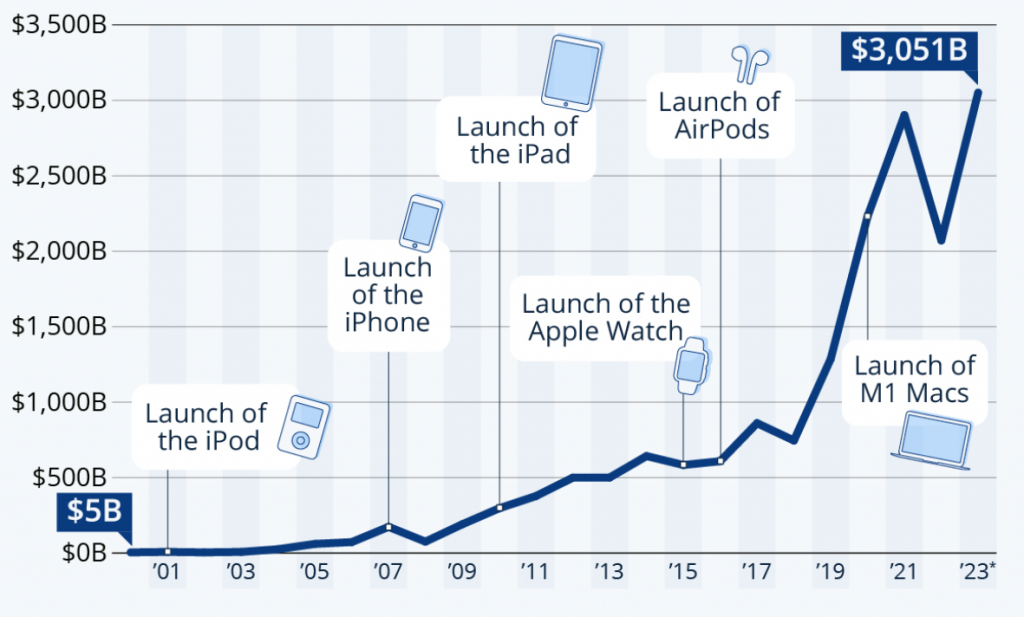
Apple Market Cap as of June 2023 – source
Apple’s Product Strategies After the Launch of the iPhone
After the launch of the first-generation iPhone, the company’s product strategy was very clear, i.e., ‘ Design a high-end smartphone in which the user experience is more important than making a slew of features available.’
The iPhone was not the first smartphone to have a mobile Web, email, and touch-screen user interface, but it was intended to have a better experience than most smartphones. Another strategy was to have superior technology, which included the mobile operating system and the thousands of mobile applications available via the App Store.
Before the launch of the iPhone, the annual revenue of Apple — in the year 2006 — was $19.3 billion, which increased to $24.4 billion in 2007 and $37.4 billion in 2008. And since 2008, iPhones have been Apple’s main source of revenue.
The launch became one of the most anticipated technological product launches in Apple’s history, owing to the company’s masterful media build-up. After the launch of the iPhone on January 9, 2007, the share price of Apple’s stock boosted and doubled to a value of $179.40 on January 9, 2008. The iPhone was described as a mix between its iconic iPod music player and a mobile phone programmed to browse the Internet.
Apple Inc. used the strong reputation of the Apple brand and the success of the iPod to penetrate the competitive cell phone market, a move that may have posed a possible challenge to the company as other firms launched smartphones with strong music storage and playback capabilities.
During the iPhone’s two-year growth phase, Jobs launched a campaign to secure a wireless company as the iPhone’s exclusive carrier. Customers who purchased an iPhone were forced to sign a two-year wireless deal with AT&T Inc. to make calls or access the phone’s other capabilities. Apple had even struck agreements with Viacom, Disney, Google, and Yahoo, all of which were carefully chosen to add internet applications to the iPhone.
Apple chose a promotion and delivery policy in European countries that were similar to its strategy in the United States. In France, it offered France Telecom’s smartphone affiliate, Orange, to be the sole carrier. Even in the United Kingdom, Telefonica’s telecom division, O2, was chosen as the sole cellular provider for iPhone customers with a two-year contract.
Apple developed a clear overall marketing strategy for the iPhone and successfully managed every aspect of the iPhone’s launch. Despite some shortcomings and pitfalls, the company was able to create a one-of-a-kind package for tech-savvy buyers interested in a hybrid mobile phone-music player and make those customers aware of the device through well-managed marketing campaigns and positive advertising. Both of these efforts significantly increased Apple’s stock price and solidified its status as a pioneer in consumer electronic gadgetry.
After the launch of the iPhone, the company adopted the strategy of patenting everything it does. The vigorous patenting helped shield Apple from competitors working on related technologies. It also provided Apple with a legal arm for the future.
One of Apple’s attorneys explained, “We basically tried to patent everything … And we tried to patent it as many different ways as we could, even the stuff we weren’t 100% sure would go in a product.”
Apple, too, has been chasing and implementing its design patents, endangering the whole technology industry. It has adopted a policy of patenting any tiny recognizable bit of its merchandise, including design patents, which protect a product’s ornamental appearance rather than its usable components.
Presently, out of the total revenue of Apple Inc., the maximum revenue is generated from the sales of the iPhone. The iPhone sales continue to be the most significant contributor to their total revenue, routinely averaging over 50%! We’ll discuss their annual revenue breakdown further down in this article.
Now that we have covered the strategic aspects, let’s examine the company’s financial information, growth and revenue numbers for the last few years, and projected growth going forward.
What does Apple’s Financial Growth look like?
Growth projection and market-related factors.
Under a realistic growth profile, Apple’s revenue is expected to grow by 9.66% over 10 years. Capital expenditures are estimated to be valued at $11 billion from 2024 to 2026 and $9 billion from 2027 to 2031. Also, over the 10-year forecast period, Apple’s earnings per share (EPS) are expected to increase by 10.68% .
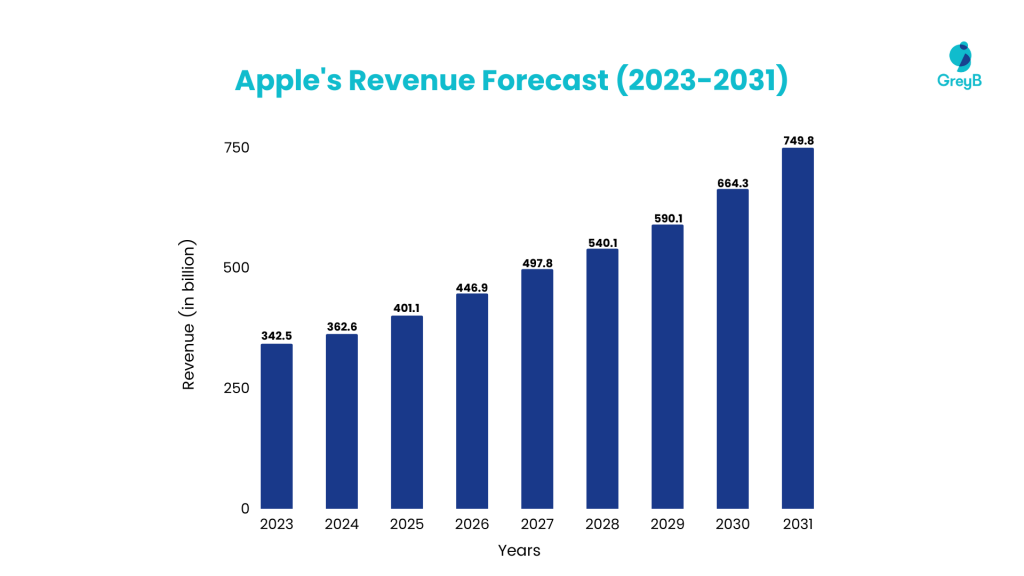
Apple’s growth would continue over the next 10 years, and while substantial risks do exist, early warnings and evaluations may efficiently monitor them.
The following are some of the market-related factors that influence Apple’s growth projections:
- Due to increased demand, the Mac and iPad will flourish in the coming decade.
- High customer satisfaction scores with Apple’s products, 82/100 (2020 survey by MBLM).
- The App Store gives several benefits to users, such as privacy, curated quality applications, protection from malware and malicious scams, etc.
- Home and Accessories, Wearables, and Services provide opportunities for several decades.
- The future launch of new products, namely the Apple Car, AR/VR headset, and AR smart glasses.
- Increased anticipation for future iPhone models.
Revenue of the Last 5 Years (in $ Billion)
Apple’s annual revenue in fiscal year 2022 was $394.32 Billion, an 8% growth over the previous year. It’s less impressive than the 33% jump from 2020 to 2021, but it’s a positive trend nonetheless. Here’s the breakdown of Apple’s revenue in the last five years across its most notable business lines.
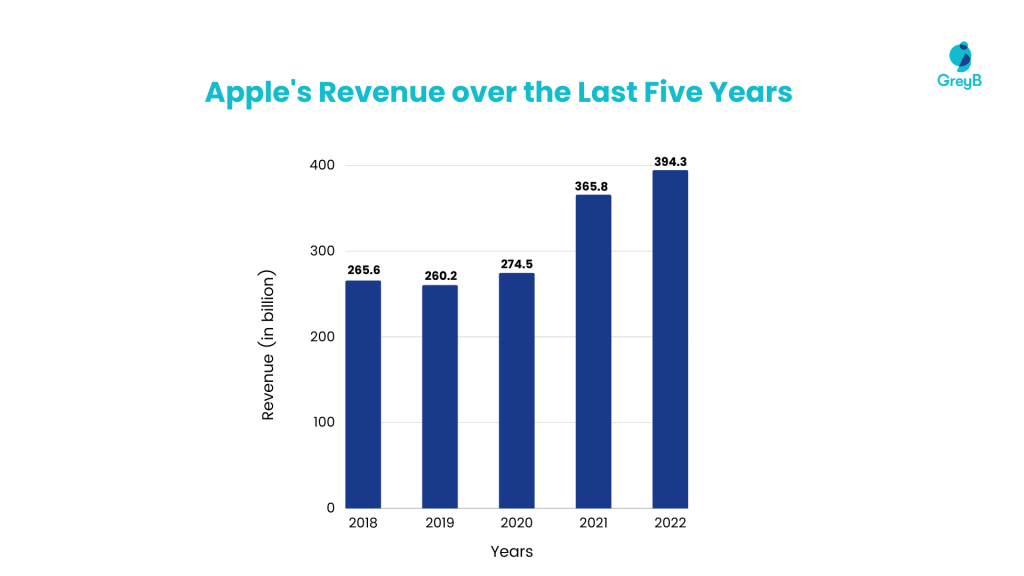
Apple’s iPhone sales revenue grew by 7% from 2021 and approximately 40% compared to 2020. Mac and services, like Apple Music and Apple TV, saw higher growth in 2021-2022, up nearly 14% year-over-year.
Between September 2021 and 2022, iPhone sales accounted for 52% of the company’s total revenue! The 3-year revenue breakdown below provides more details .
Revenue Breakdown (Section-Wise) of the Last 3 Years
The last three annual reports of Apple suggest that the iPhone category had the highest revenue amongst all the categories of Apple. The breakdown of revenue for the last 3 years is listed below:
- Apple currently has 2 billion active devices globally.
- Apple’s net expenditures in 2022 were $295.5 billion, leaving them a hefty $99.8 billion profit.
- The company’s new iPhone models released during the fourth quarter of 2021 were a massive success.
- Mac sales netted approximately $5 billion more than fiscal year 2021. Their new Mac Studio with the Apple M1 Max chip may have attracted people looking for powerful desk workstation upgrades.
- iPad Pro sales decreased from 2021 to 2022, leading to a relatively small reduction in revenue. This is likely because no other iPad lineup was noticeably refreshed during this period with notable features, except for integrating the M1 chip. In addition, Apple had said during this period that it had faced supply issues with the iPad, which may have impacted sales.
The corporation has been vigorously investing in research and development to ensure an increased revenue stream. Let’s now look at Apple’s R&D strategy and the tech areas in which the company is increasingly investing.
What does Apple’s R&D investment strategy look like?
The tech giant has vigorously invested in research and development to ensure an increased revenue stream. We observed that Apple continuously increases its R&D budget each year, with 2022 closing in at $26.2 billion, increasing by about $4 billion from 2021.
How much has Apple invested in R&D in the Past 3 Years (in $ Billion)?
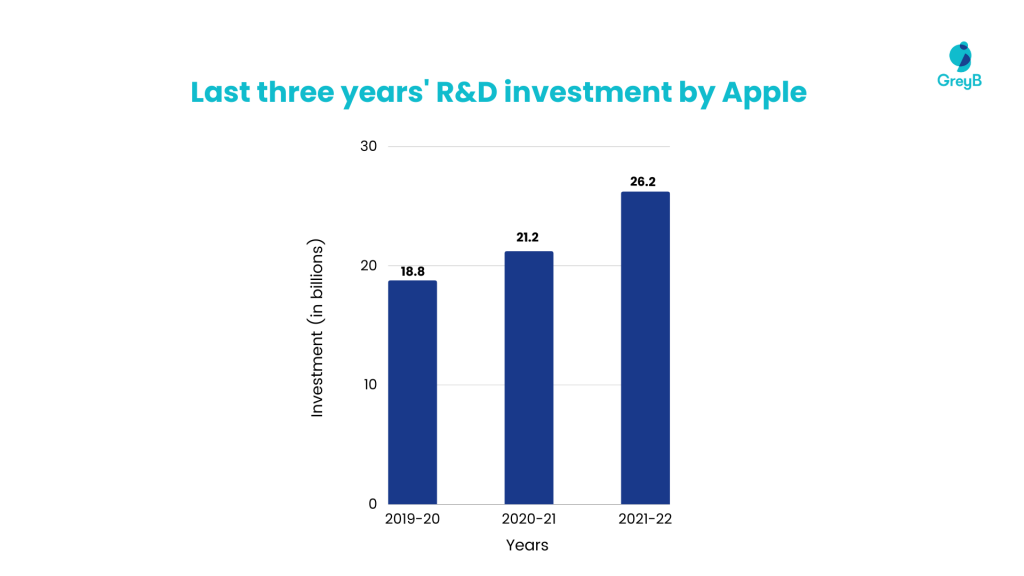
- In 2020, several patents revealed that Apple focuses on wearables, fitness, and health innovations. Various wearable patents indicated that the company could target AirPods with biometric sensors, Apple Watch with UV tracking, motion recognition for AR/VR applications, machine learning experiments to allow autonomous driving, and incorporation of various existing devices with a vehicle.
- In 2021, they launched several noteworthy products. Perhaps the most disruptive of them was AirTag. These item trackers have quickly become so popular that Apple sold 20 million units within eight months of launch! Now, analysts claim Apple is projected to sell 55 million AirTags by the end of this year.
- In 2022, they introduced the Apple Watch Ultra to their product line. It’s their flagship wearable device with several top-tier features like a titanium build, two times brighter display, and a dual-frequency GPS system, among other things. Driven by this model, the Apple Watch accounted for 34.1% of total smartwatch shipments in 2022 and 60% of the revenue for the global market.
Which Tech Areas is Apple focusing its R&D on?
Apple Inc. had invested in further expanding its research and development centers globally. The company had invested over half a billion dollars in research development centers in China alone. The company also concentrated on R&D centers in the United Kingdom, owing to their increasing emphasis on creating unique innovations to underpin its product designs, including A-series processors, W-series wireless chips, unique manufacturing, materials experience, speech recognition, machine intelligence, and many more.
These are the key areas where the company focuses its innovation efforts the most.
Apple invests heavily in developing new hardware for its products. Their most recent and notable advancement has been with their M-series processors for computers to supplement their excellent A-series mobile chips. These have smashed benchmarks worldwide, delivering chart-topping performance and power efficiencies never seen before. They make some of the best pro-grade displays , too.
Apple’s software development efforts include creating new operating systems for their products, new applications, and services. All their software products are designed and optimized for their ecosystem, allowing seamless inter-device connectivity. This interconnected approach to innovation can be seen throughout their designs, like on this expansive 358-page patent they filed for the first iPhone’s multi-touch capability .
Artificial Intelligence
Apple also invests in artificial intelligence and machine learning to improve its products and services. They’ve made numerous acquisitions to enhance their in-house AI capabilities, which we will discuss further in this article. Their advanced machine learning algorithms enable many features, ranging from FaceID’s fundamental security to fun AR Animojis on Facetime calls.
Healthcare Technology
Apple has been expanding its focus on healthcare , developing health-related features for its devices, such as the Apple Watch. Alongside regular customers, Apple wishes to be the go-to choice among doctors and healthcare professionals as well. They’ve partnered with healthcare providers like Geisinger and Ochsner to provide a seamless way for doctors and patients to connect. Their CEO, Tim Cook, has often made it clear that healthcare is one of Apple’s top priorities as a business sector.
Augmented/Virtual Reality
Spatial computing is one of Apple’s lesser-known yet rapidly developing departments. Our research suggests that Apple has been working on an AR and VR-capable wearable device for nearly 16 years!
“The products that are in R&D, there is quite a bit of investment in there for products and services that are not currently shipping or derivations of what is currently shipping…You can look at the growth rate and conclude that there’s a lot of stuff that we’re doing beyond the current products.” – Tim Cook, CEO of Apple Inc.
Which Core Innovation Areas Is Apple Majorly Focusing on?
For the tenth year in a row, Forbes magazine ranked the company as the most valuable brand in the world in 2020. Apple took second place in 2023, around $2 billion shy of Amazon in brand value. Nonetheless, Apple has risen to become the world’s largest company by market capitalization, not by attempting to become the largest smartphone provider but by becoming the most beloved. Apple, more than any other tech company, has always prioritized the end-user experience over anything else, not just the speed, storage capacity, or other technical specifications of its products.
Apple’s innovations are often incremental, with the company adapting its design expertise to the most recent consumer tech trends. Apple did not invent the MP3 player or the smartphone, but it went on to dominate both devices by emphasizing design, user experience, and brand cachet. The company has aggressively increased the domains where the Apple experience is part of daily life during the last ten years.
Apple guarantees that the universe of Apple-mediated behaviors continues to grow by encouraging app developers while strictly enforcing rules. By reinventing product form factor and function, from computing in a user’s pocket to managing home electronics to reminding the calorie count or parking spot — all of these experiences are connected, integrated, and packaged in a single accessible ecosystem of complimentary items.
Moreover, Apple has focused on innovation outside the core by developing the infrastructure required to support this ecosystem safely and frictionlessly (Apple Pay secure payments or biometric facial recognition since the iPhone X).
We have mentioned before that Apple vigorously patented everything it did. After looking at the wide array of domains on which Apple works, it becomes important to examine the kind of patent portfolio Apple has accumulated over the years.
What does Apple Patent Portfolio look like?
A company’s patent portfolio provides us with another set of lenses to find the core areas it has been focusing on for quite some time and what it plans to launch next. Let’s take a deep dive.
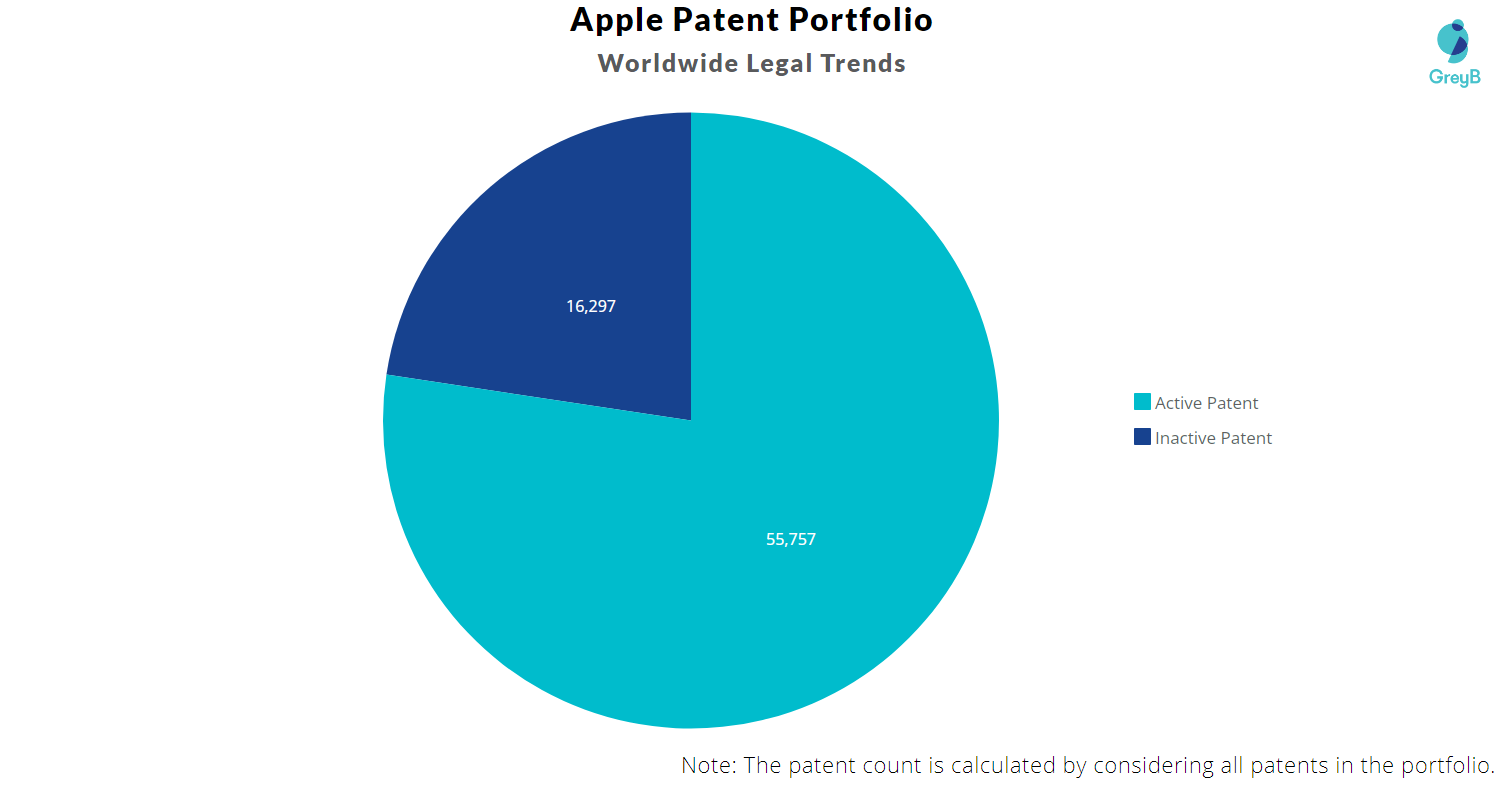
Source: Insights;Gate by GreyB
With 72000+ patents (24000+ patent families) in its entire portfolio, Apple is one of the top patent filing companies in the world. It has more than 55000 patents that are still active.
Looking at the filing trend, you can see the year 2007 saw a sharp increase. It was the same year they launched the iPhone. One can conclude that the iPhone is one of the reasons Apple invested heavily in securing its technologies.
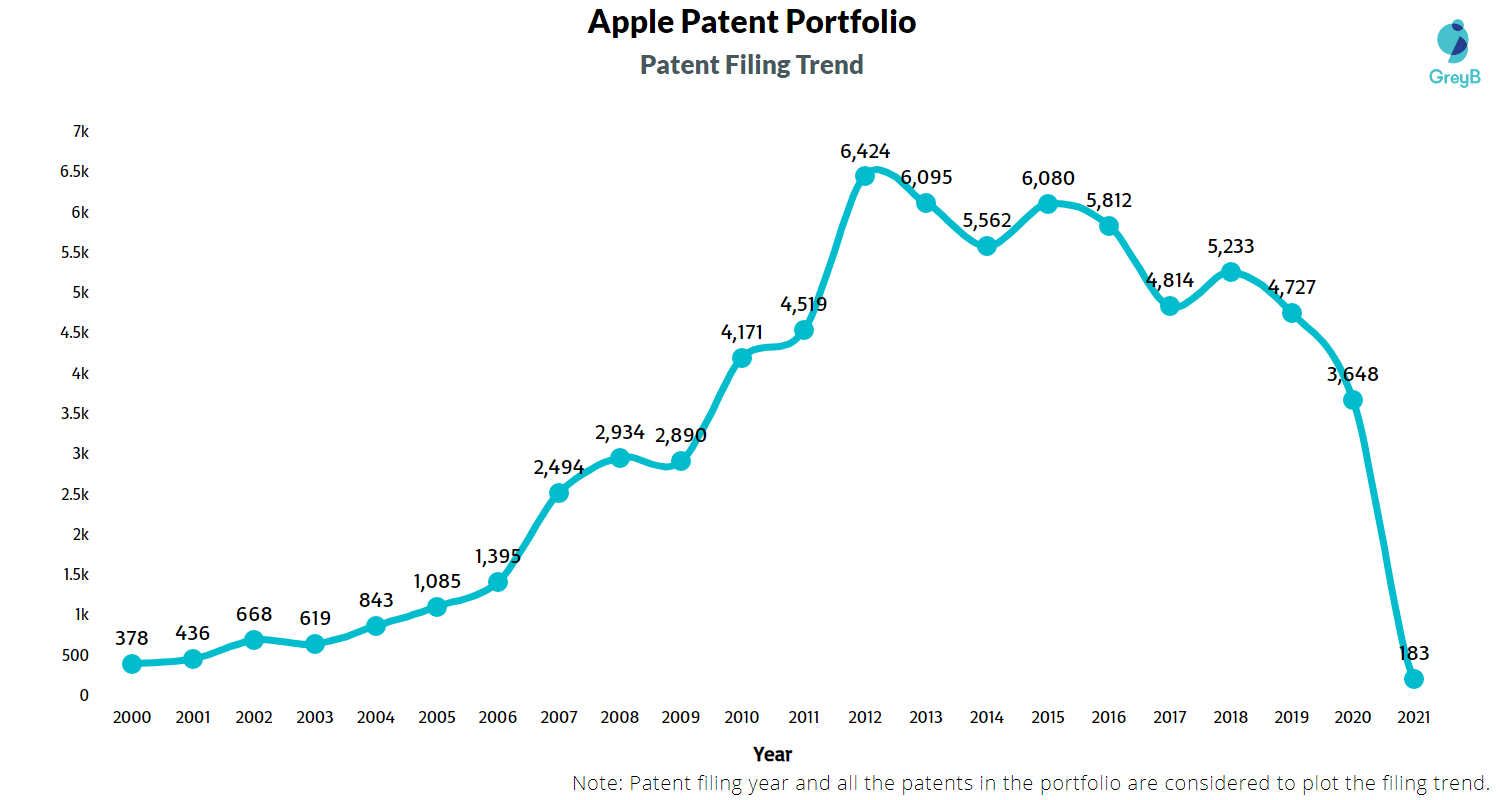
The Apple vs Samsung lawsuit is still one of the largest patent infringement lawsuits that happened in the tech industry. And that further pushed the consumer electronic gadgetry pioneer to invest more in patents. (See the growth in 2012)
One of the reasons for this growth is Apple’s consideration to secure its tech in more countries. As Apple is gaining more and more global markets, it is securing its patents in more and more jurisdictions.
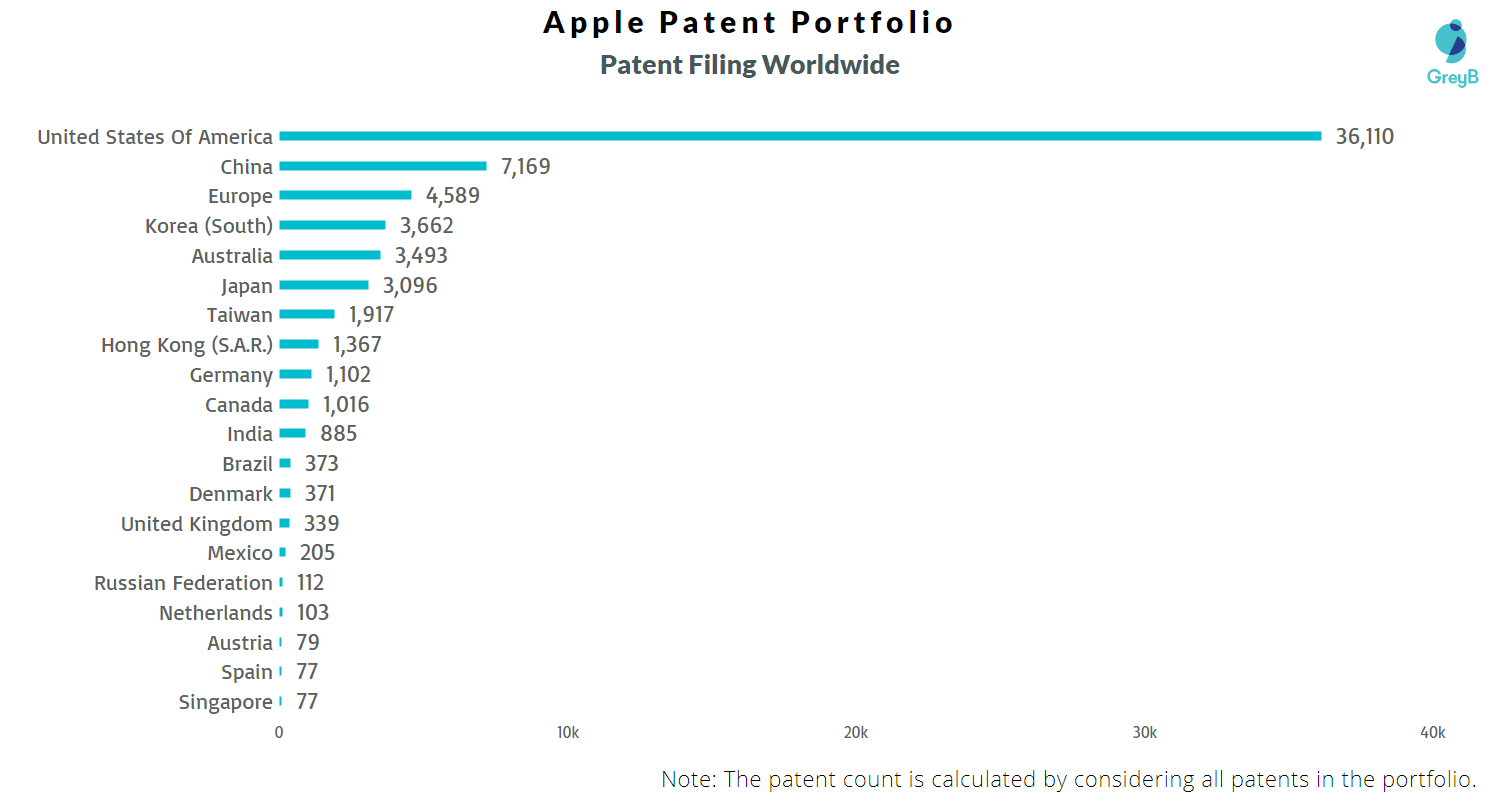
The US is the home market for Apple, so, naturally, the company has the most patents in the US. China is a crucial market for smartphone makers now more than ever. China has become more patent aware thus most of the big companies are trying to secure more and more technologies/patents in the country. Apple being one of the biggest technology companies, it makes sense that it has secured thousands of patents in China.
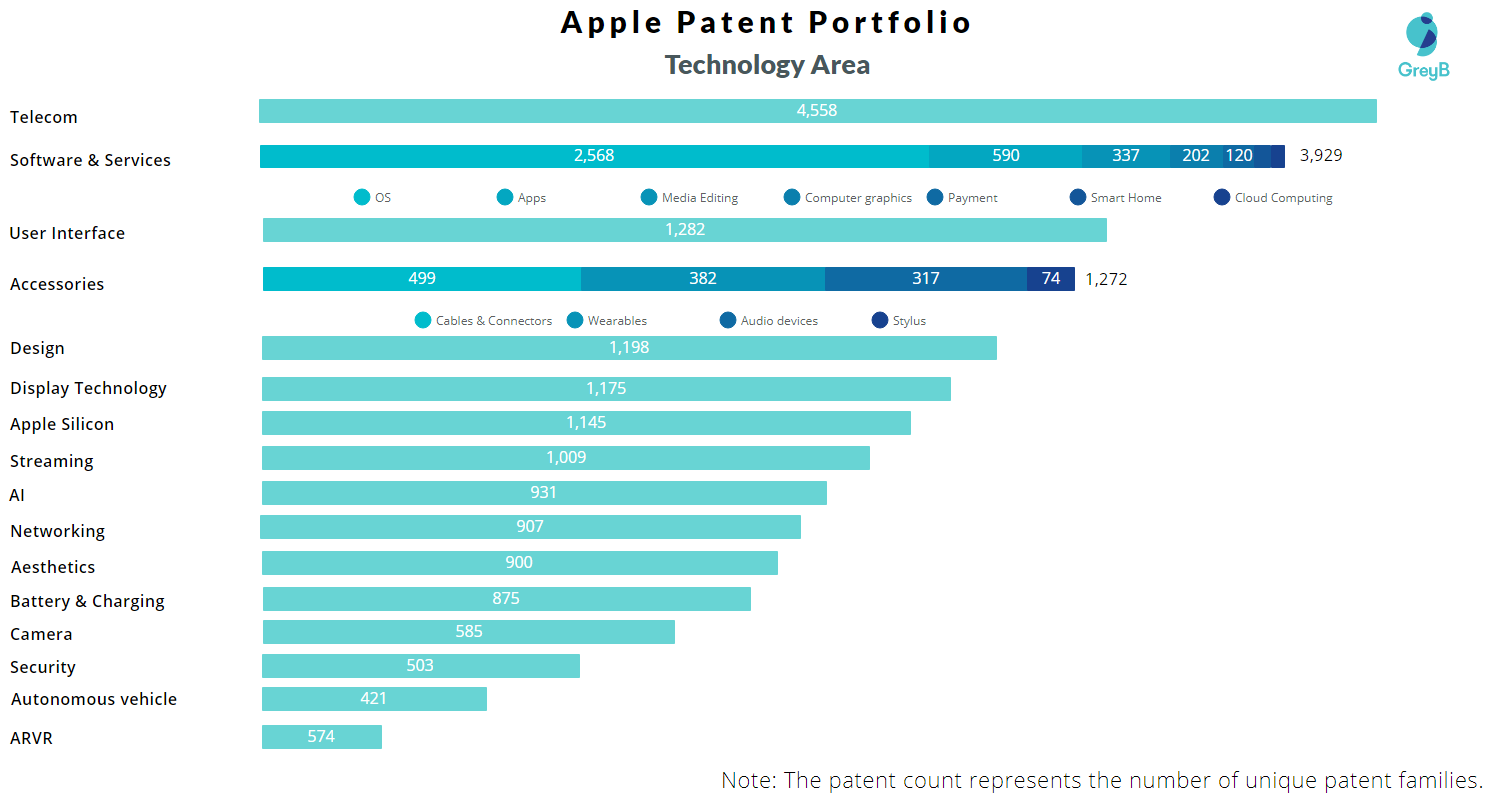
The huge portfolio of Apple is categorized into 16 different technologies that the company uses for its products/services or future products.
Being a smartphone manufacturer makes Apple research heavily in the Telecom sector, which is also crucial for companies, especially when 5G is on the doorstep.
Another interesting figure is of Apple’s design patents. The company focuses greatly on the design part, and the patent count is proof of how valuable product designs are for Apple.
Apple hasn’t made any public announcements yet on their Autonomous Vehicle front, but the AR/VR space is where we had a long-awaited announcement in June 2023 – their Vision Pro headset. We’ll discuss this in more detail in the upcoming sections.
Moving forward, let’s go through Apple’s expertise in various sections.
What are the products and services responsible for Apple’s growth?
Design and functionality.
Apple’s competitive advantages include software control, hardware control, retail strategy, product differentiation, and, most importantly, Steve Jobs’ strategic decision-making. Since its foundation, the company has introduced simple-to-use computers to the market so that people would not face any issues while using Apple goods. Apple used both horizontal and vertical integration. It depended on its designs and refused to let third-party access to its hardware. Apple employed superior software, which aided it in increasing its market share. The company also provided a comprehensive desktop solution with hardware, software, and other components. Apple has always used typical designs for its products.
Apple has over 4,000 design patents in its portfolio, which is a big number.
Consumer Electronics
Apple Inc., a computing and consumer electronics giant, is one of the world’s most recognizable and famous brands, with hundreds of its retail shops. A globally leading consumer electronics developer with key products including the iPhone, which runs Apple’s IOS operating system, personal computers (Macs), and tablet computers (iPads), all of which utilize Apple’s exclusive operating systems. Other notable products include the Apple Watch, AirPod, Homepod smart speakers, Apple TV streaming device, Beats headphones, and iPod Touch music player.
The company’s product strategy results in extremely high-quality products. It’s known as the “great product” strategy.
Apple refuses to join the bandwagon other gadget makers employ by maintaining high-quality standards. The “great product” strategy emphasizes quality over quantity as well.
While other manufacturers’ strategies include releasing items one after the other quickly and having such a diverse product mix, Apple opted to stick to what it does well.
Smartphones (iPhones)
Since 2008, the iPhone has been Apple’s most valuable product and its primary source of income. Although Apple has expanded its product range with the Watch, AirPods, and services, the iPhone still accounts for 50% of its income. The company’s extensive relations with China, particularly in the manufacturing sector, are one of the key bear arguments.
Most of Apple’s products are manufactured in China. While Apple has been expanding production into other countries, recent estimates suggest that 95% of the total iPhone supply still comes from China. Apple also has manufacturing facilities and assembly lines in other countries, such as the United States, Ireland, and Brazil.
Three of the company’s aforementioned contract partners, all of whom are situated in Taiwan, made relocation news in the summer of 2020:
- Foxconn began producing the iPhone 11 in India in July 2020 and had invested $1 billion in the nation.
- Pegatron established a subsidiary in India.
The demographic of iPhone users changes a little each year. Here are some of the latest statistics on iPhone users:
- 51% of iPhone users are female, while males make up the remaining 49%
- The 16 – 34 age group has the highest number of iPhone users
- 35% of iPhone owners also have an Apple Watch
- The average income of iPhone users in the US is 85,000 USD
Its main competitors in the worldwide smartphone industry are Samsung and Huawei, with the business following the other two with a share of 13.5 % in the most recent quarter.
In the second quarter of 2023, Apple’s global market share for the iPhone was 17%, while Samsung’s, Xiaomi’s, and Oppo’s market shares were 20%, 12%, and 10%, respectively. The company sold 845.3 million smartphones in the second quarter of 2023, while Samsung sold 53.5 million handsets. Xiaomi and Oppo, respectively, sold 33.2 million and 28 million units.
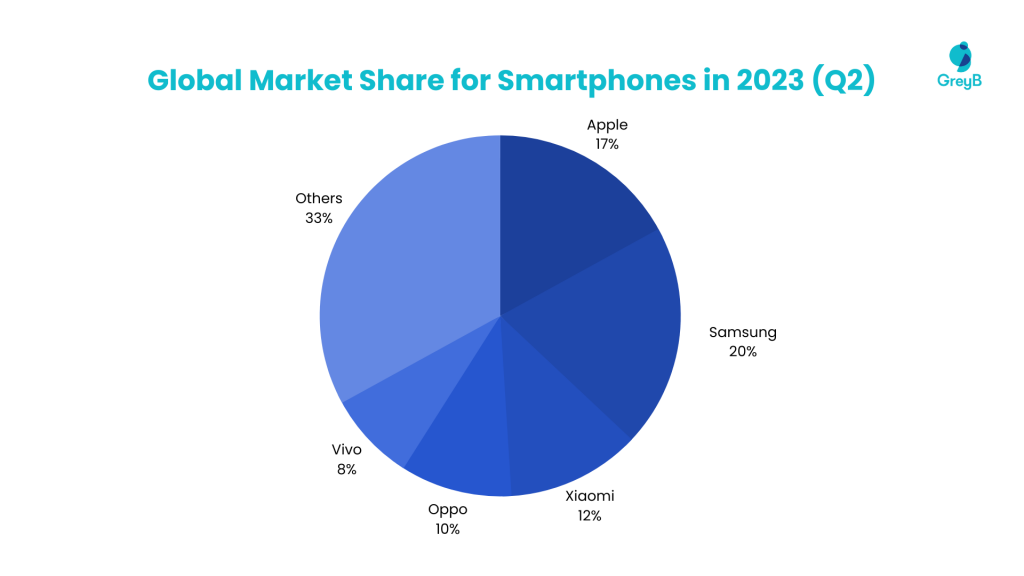
Apple’s iPhone is the market leader due to excellent hardware and software integration and control over both sides of the equation. Any Android app will lag in terms of speed and performance when compared to an iPhone app.
In 2021, Apple spent an additional $45 million on Corning, which manufactures the glass used in the iPhone, Apple Watch, and iPad. In May 2021, the company announced a $410 million grant to II-VI, which develops the technology for the iPhone’s Face ID and Portrait mode.
With over 1 billion iPhones in use, Apple is the doorway to the most valuable clients in the mobile industry. In 2021, Apple has updated its iPhone software and allows consumers to choose whether they want to be followed for targeted adverts.
Even though both iOS and Android have millions of apps in their app stores, developers still prefer the iPhone as the launch platform of choice for the latest new apps. Mario Run, for example, was released for iOS in December 2016 and Android in March 2017. Instagram for Android was released two years later for the iPhone.
The iPhone 15 lineup in 2023 builds upon the foundations set by the 14 series with additional features like USB-C replacing the lightning port, the dynamic island-inspired design on the 15 and 15 Plus, and the newer A17 Pro chip on the “Pro” models. Apple says the A17 Pro is the industry’s first chip to feature a 3-nanometer fabrication process.
And thankfully, the rumors about the USB ports being locked behind the MFi authentication layer were false.
Smart Speakers (HomePod)
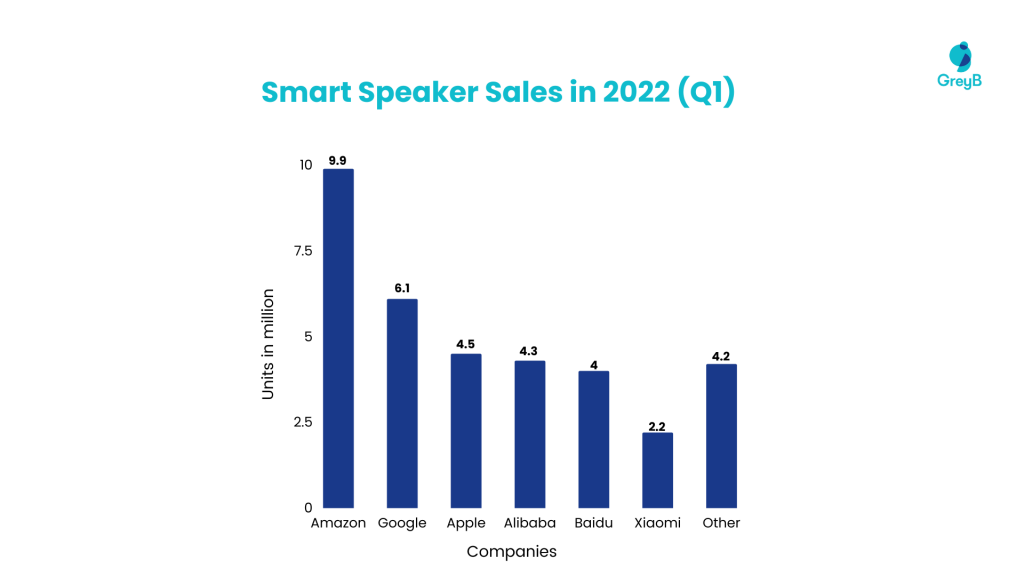
HomePod has experienced limited success in the Smart Speakers market. Apple trailed Amazon and Google in terms of unit sales . However , the release of the HomePod Mini has made significant advances, enabling Apple to double its share in the smart speaker market in 2021. According to survey results from Statista Consumer Insights, Amazon remains the clear market leader in the smart speaker segment in the United States. Apple took third place among the global smart speaker sellers as of Q1 2022.
Apple’s HomePod is the best-sounding wireless smart speaker today, and it can be operated by speech using the in-house virtual assistant, Siri. However, the HomePod is only worth considering if the owner possesses an iPhone and subscribes to Apple Music. In March 2021, Apple announced the discontinuation of the original Homepod after 4 years and indicated its focus on the mini Homepod it released last year.
Laptop & PC (MacBook and Mac)
Despite Apple’s shift in priority from PC to mobile, the Mac has remained a key component of the company’s product lineup. The company has maintained a core group of devices throughout the decade: the MacBook Air, MacBook Pro, Mac Pro, and iMac. Even after modifications and new models, its core has remained popular among many professional clients.

In 2022, Apple had a 9.8% market share, following market leaders Lenovo, which had a 24.1% market share, HP Inc., which had a 19.4% market share, and Dell, which had a 17.5% market share.
When a customer purchases a Mac, that purchase is a philosophy as much as it is a piece of computer technology. The hardware and software are produced by the same corporation, and the laptops share an aesthetic sensibility with Apple phones and tablets.
Macs are popular among music producers due to Apple’s high-end Logic Pro software and the user-friendly GarageBand program, both of which are free. Apple acquired Emagic, a music production software, on July 1, 2002, for $30 million as the foundation for these two apps.
In addition, other Apple-exclusive media software like Final Cut Pro and Pixelmator could convince photo and video editors to switch to Mac OS.
Apple Watch
Since its debut in 2015, Apple Watch has dominated the smartwatch industry, with a market share of 40% in Q4 2020 .
According to Counterpoint Research, Apple Watch shipments increased by 19% between 2019 and 2020, reaching 33.9 million units in 2020. In Q4 2020, Apple Watch Series 6 and SE delivered 12.9 million devices. Further, markets such as India saw strong demand for Apple Watch Series 3 and 6 in 2020, with a growth of 144.3% in overall Apple wearable devices shipments.
Apple dominated the market in 2022 with a 30% share, followed by Samsung at 10.1% and Huawei at 6.9%, among others.
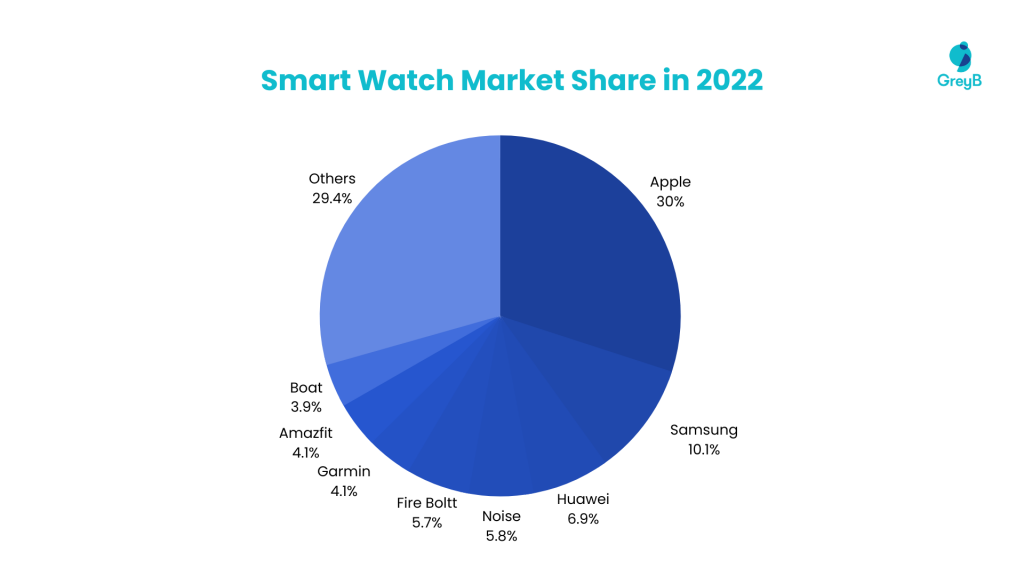
The same trends are also reflected in Q1 of 2023 , where Apple is leading the market with a 26% share and Samsung at 9%.
The Apple Watch is the greatest smartwatch on any platform in terms of appearance, message handling, activity tracking, app choices, and battery life. The Apple Watch is water resistant to 50 meters, making it ideal for swimming and surfing. The Sleep app monitors the user’s sleeping habits and assists in creating a plan and bedtime routine to accomplish sleep goals. Apple is, in fact, making strides in the Healthcare sector with its Apple watch.
Read Now: Apple in Healthcare: Top MedTech Acquisitions and How Can You Gain an Edge over it?
AirPod and AirPod Max
Apple’s AirPods have grown into a significant business for the company, with 114 million sold by 2020. A commodity that many saw as an expensive accessory has become common, with nearly every phone maker selling their own ‘hearable’ to compete with Apple. Apple was ahead of the pack in Q2 of 2022, holding 27.8% of the total market share. Samsung and Xiaomi followed up with 9.3% and 5.3% respectively.
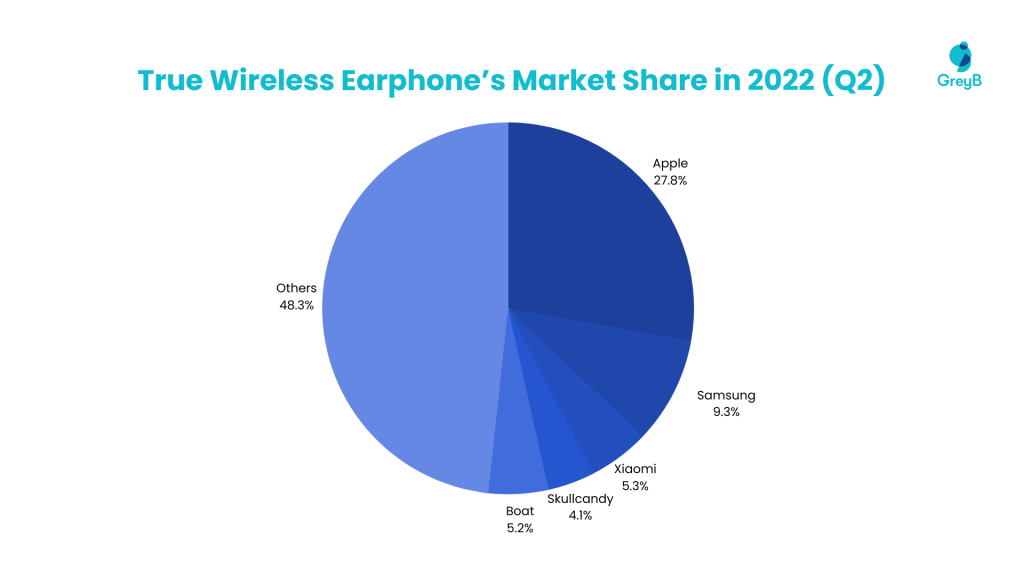
Further, Apple released AirPod Max, Bluetooth over-ear headphones, in Dec 2020 with a price tag of $549. While Analysts estimated that AirPod Max won’t boost Apple sales because of a niche market, some expect that it could boost AirPod sales because of Apple’s Goldilocks strategy.
Cybart forecasts that Apple’s wearables segment will generate $30 billion in revenue by 2021, including the Watch, AirPods, and select Beats headphones.
The five reasons why Apple built a strong wearables business are mentioned below:
- Early adopter: One of Apple’s guiding principles is to make technology more personal, and it began investing in wearables, including its silicon processors, in the early 2010s.
- Other corporations gambled on voice: Because few Large Tech businesses had Apple’s hardware competence, they bet big on voice (example: Amazon’s Echo) as the future computing paradigm. It appeared to be a bad gamble.
- Design expertise: People must desire to wear wearables, which requires design skills. Apple has a track record (and aptitude) for designing devices that consumers want to show off as much for its aesthetic as it does for its computational capabilities.
- Advantage of the supply chain: Wearable technology is built on top of smartphone components. Apple has been able to capitalize on lessons learned and partnerships formed through the iPhone production process.
- Advantage of the ecosystem: Apple’s entry-level AirPods and Watch were around $200. Because the wearables effectively share computational power with the iPhone, it achieved these pricing thresholds.
According to Cybart, Apple’s wearables segment will likely reach $50 billion in the following year if present trends continue.
Apple Silicon (Chipsets, Processors)
Apple announced that it would switch from Intel chipsets to its own Apple Silicon processors based on ARM in 2020. In keeping with this, the business released a new M1 processor as well as three products powered by it — the MacBook Air, MacBook Pro, and Mac Mini. A survey from market analysis firm TrendForce suggested that M1-powered Mac machines represented around 0.8% of overall laptop sales in 2020, months after the products became available for purchase.
In terms of operating systems, Windows was the global leader in the laptop industry. However, due to the strong expansion of Chromebooks in 2020, Windows’ market share would fall below 80% for the first time in history. Windows is unlikely to regain lost market share immediately since its fall is predicted to continue. TrendForce predicts that the market shares of Windows, Chrome OS, and macOS will each settle at around 70-75%, 20-15%, and less than 10%, respectively.
In 2020, Apple is anticipated to launch the first MacBook to utilize its silicon processor rather than Intel’s, allowing all its key product lines to run on the same architecture.
When considering Apple’s most notable purchases, two stand out:
- In 1997, NeXT Software was purchased for $404 million. The acquisition of Steve Jobs’ post-Apple venture, which featured the forerunner to iOS, returned Jobs to the firm he created.
- Beats for $3 billion in 2014: Apple’s largest acquisition was Dr. Dre and Jimmy Iovine’s headphone firm, which laid the framework for Apple Music.
- However, a third (and extremely significant) transaction set Apple’s mobile product roadmap: the $278 million acquisition of P.A. Semi in 2008.
According to tech analyst Ben Thompson, P.A., Semi gained the expertise and intellectual property (IP) “that would underpin (Apple’s) A-series of processors, which have powered every iPad and iPhone since 2010.”
Apple introduced the Apple TV in March 2007. And much to everyone’s surprise, it was not an actual TV set but rather a box to offer services using the software. It was praised for its attractive interface, painless setup, and overall ease of use – all of which marked a significant shift from prior network-based home entertainment systems.
The hardware remained the same almost a year later, but a free software upgrade essentially gave the device a makeover. Apple subsequently reduced the price of the 40GB model to $229, while the 160GB model was reduced to $329.
People still wonder why Apple never made an actual TV like Samsung or Sony. There are multiple reasons why Apple didn’t enter the TV manufacturing business even with enough expertise.
First, this industry’s margin is very thin, and Apple always focuses on making profits. Second, unlike smartphones or other consumer electronics, there isn’t much design to make it unique. You can find many identical TV designs from different companies. Third, Apple can provide a good user experience through its software, so it went for a box to provide better UX in any TV.
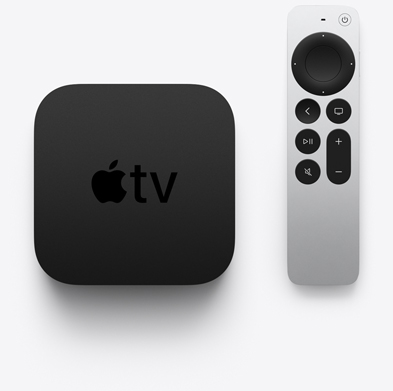
Source: Apple
The box design remained the same throughout the years, but they made multiple changes to its remote.
The iPod was one of the most successful products ever created by Apple. It was a little device that let users listen to music on the go. However, it is now 2021, and despite having Apple Music on iPhones and even being accessible on Android and even smart TVs, Apple continues to offer the iPod Touch . One of the main reasons is that it is not an iPhone and is suitable for children.
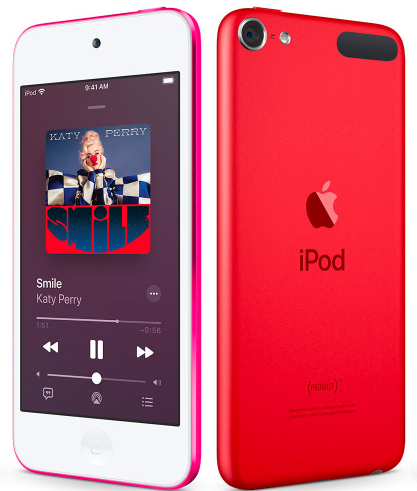
Further, iPod Touch uses iOS with the same inbuilt software. It’s basically an iPhone without cellular network connectivity. The user can play games, surf the internet using Wi-Fi, and can send messages using a web browser.
It is Apple’s tactic to prime the iPod users to turn into iPhone users when they choose to buy a smartphone. By using the iPod for 2 or 3 years, most users would want to choose an iPhone over other smartphone brands.
As the iPod is a part of the Apple ecosystem, it helps users remain in it even when they want to upgrade a device.
AirTag, a compact and elegantly designed device that helps keep track of and find the stuff that matters most with Apple’s Find My app, was announced in April 2021 . AirTag, whether connected to a handbag, keys, backpack, or other objects, connects to the enormous, worldwide Find My network and can assist in recovering a misplaced item, keeping location data private and anonymous using end-to-end encryption.
“We’re excited to bring this incredible new capability to iPhone users with the introduction of AirTag, leveraging the vast Find My network, to help them keep track of and find the important items in their lives.” – Kaiann Drance, Vice President of Worldwide iPhone Product Marketing of Apple
Dongles link headphones to charging connections, computers to TVs or card readers, etc. Dongles are a major business nowadays since it’s difficult to conduct many routine computer chores without them. This is owing, in large part, to Apple, which, in 2016, eliminated the headphone jack from the iPhone range and shifted nearly completely to USB-C connectors on its Macs. The newest iPhone isn’t the only Apple gadget that requires an array of dongles to function properly.
A dongle is necessary to connect a MacBook Air to an Ethernet wire. A dongle is also required if the user wants to add a second screen to the computer or import images from an SD card. A USB to USB-C adaptor is required even if users put a flash drive directly into the MacBook.
This causes users to accept the dongle as an integral part of their lives, allowing Apple to establish a sizable market for dongles. Apple, Belkin, and other accessory firms have established a massive market for these dongles, which Facts and Factors estimates will be worth more than $25 billion by 2027.
It is unknown how much Apple’s revenue is from Dongles, but considering the user base’s preferences and Apple’s dongle prices, it could be more than a billion dollars.
Now, let’s move on to the core of all these products- Software.
For over four decades, Apple has been a Silicon Valley trendsetter. Apple’s competitors have widely imitated the Apple II, Macintosh, iPod, iPhone, and iPad. Apple’s success may be attributed in large part to the company’s obsessive attention to the user experience. The iPod first debuted in 2001, followed by the iPhone in 2007, and the iPad in 2010. Consequently, Apple earned about $40 billion in earnings in its fiscal year 2014. Apple is a design-focused corporation that prefers to create all aspects of a product — hardware, software, and internet services — in-house.
Apple II computers were sold until 1993, when they were phased out in favor of Macintosh computers. Around 5 million Apple II computers were sold in total. The first Macintosh had significant limits. However, later versions were more powerful. In 1987, Apple introduced color to the Macintosh with the Macintosh II. The groundbreaking graphical interface of the Mac immediately drew several imitators. Apple debuted the iPod music player in 2001. More crucially, the iPod was compatible with iTunes, Apple’s jukebox software for the Mac, making it simple for users to transfer music from CDs to their iPods. Apple, too, capitalized on the iPhone’s popularity in 2010 by releasing the iPad, a tablet computer built on the same software.
Operating Systems
Both Mac OS X and iOS originated from Darwin, an older Apple operating system based on BSD UNIX. iOS is a proprietary mobile operating system owned by Apple that can only be loaded on Apple devices.
Apple’s iOS is a closed ecosystem, which implies that Apple creates both the operating system and the hardware, and no other corporation utilizes either of them to integrate with their services. It gives Apple an advantage over Android regarding hardware and software synchronization. In the case of Android, however, the hardware is manufactured by companies like Qualcomm and MediaTek (rather than Google), and the manufacturers create their own flavor that runs on top of Android. In addition, Apple allows users to offer 3D touch inputs with mini menu selections. The iOS devices are set up to detect pressure sensitivity on the screen and allow various input choices based on it.
As of July 2023, Android occupies 70.9% of the mobile OS market, followed by Apple’s iOS at 28.36%.
The Mac OS was released in 1984 to power Apple’s Macintosh series of personal computers (PCs). The Macintosh heralded the age of graphical user interface (GUI) systems, inspiring Microsoft Corporation to create its own GUI, the Windows operating system.
The interface is the most noticeable variation between Windows and Mac operating systems. macOS is perceived to be more basic, streamlined, and elegant, but Windows is considered to be more sophisticated and feature-rich, with more customization choices.
The design styles for Mac and PC are vastly different. Whereas macOS has smooth edges and a consistent application across all apps, Windows has jagged edges and a UI that frequently changes across programs. As Apple has complete control over hardware and software, new security enhancements can be implemented on macOS. Similarly, Apple has a simple and comprehensive AppleCare service in place to assist consumers with any hardware issues. Newer Apple products have Touch ID functionality by default for system access, further protecting devices from fraudulent logins.
Microsoft Windows has a 77.74% market share for desktop operating systems (OS) as of July 2020. Apple’s macOS has grown in popularity over the years but is still a minor player in the desktop OS industry. Linux, the third most popular desktop operating system, has a tiny but constant market share. As of May 2021, OS X had a market share of 15.87% , while Windows had a market share of 73.54%, and Linux had a market share of 2.38%.
The WatchOS app experience differs from app experiences on other platforms in several ways. For example, because the Apple Watch is meant to be worn, the UI is tailored to wearers and provides a lightweight, responsive, and highly personalized experience. People commonly utilize the related experiences of a WatchOS app such as Apple complications, notifications, and Siri interactions — more than they use the app itself.
The latest WatchOS 9 update reflects Apple’s goals in healthcare and personalization. Users can now see more information about their workouts on the screen. Turning the Digital Crown reveals metrics like Activity rings, Heart Rate Zones, Power, and Elevation.
In healthcare, Apple has been at work for years, acquiring medtech startups and using its patented technology to strengthen its WatchOS ecosystem. For instance, most of the sleep-tracking technology on Apple Watch likely came from startups like Beddit, which Apple acquired in 2017. Through the acquisition, Apple also got rights to Beddit’s patents on crucial health features, such as a system for determining sleep quality and applying a pressure sensor .
Read More Here: Apple in Healthcare: top MedTech acquisitions and how can you gain an edge over it?
Apple devices are well-known for linking users to content. This sense of connection is anticipated from Apple TV, although it is not a product that the user can physically grasp or touch. Apple TV is a one-of-a-kind platform with unique specifications . TvOS apps can provide incredible experiences with great visual quality thanks to 4K resolution, Dolby Vision, and HDR10, as well as immersive sound thanks to Dolby Atmos. Furthermore, the Siri Remote provides access to three-axis gyro data, allowing users to build even more immersive gaming and interactive experiences.
Tizen is the largest TV streaming platform globally among smart TVs in use, with a market share of around 13% as of the end of 2020, followed by LG’s WebOS with 6.4% market shares, Sony PlayStation, Roku TV OS, and Amazon’s Fire OS tied for third place. Apple TvOS had a market share of 2.7% as of 2020.
Smart TV Streaming Device Market Share Worldwide As Of 2020 (%)
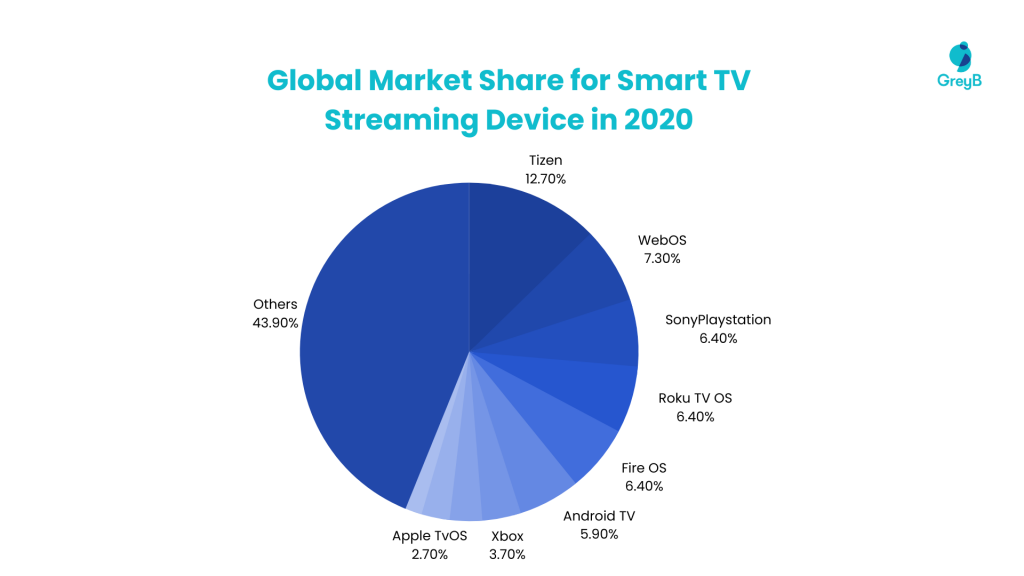
Apple’s machine learning teams are conducting cutting-edge research in machine learning and artificial intelligence. The team employs machine learning to educate their devices to comprehend the environment in the same way that humans do. Apple did a research study to investigate the feasibility of inferring accessibility for mobile apps from their display pixels.
Using a dataset of manually collected and annotated iPhone app screens, they trained a robust, quick, memory-efficient on-device model to recognize UI components. Due to this research, Apple launched the Screen Recognition function, which combines machine learning and computer vision to recognize and present material readable by VoiceOver for apps that would otherwise be inaccessible.
Even in May 2021, Apple Inc. hired Samy Bengio , a former prominent Google AI scientist. The hiring will lead to the establishment of a new AI research team within Apple, led by John Giannandrea. Bengio pioneered the “deep learning” methods that underpin today’s AI systems for processing photos, audio, and other data types.
Machine learning and artificial intelligence are now present in almost every aspect of the iPhone.
“I think that Apple has always stood for that intersection of creativity and technology. And I think that when you’re thinking about building smart experiences, having vertical integration, all the way down from the applications, to the frameworks, to the silicon, is really essential… I think it’s a journey, and I think that this is the future of the computing devices that we have, is that they are smart, and that, that smart sort of disappears.” – John Giannandrea, Senior Vice President for Machine Learning and AI Strategy at Apple
Apple has made a practice of crediting machine learning with boosting specific functions in the iPhone, Apple Watch, or iPad, but it seldom goes into much detail.
Apple has taken a more subtle and astute approach to AI. Apple hinted at various AI and ML-powered improvements and enhancements in its June 2020 announcements for iOS, iPadOS, and macOS.
- The Apple Watch utilizes machine learning to identify motions and detect sleep. Users only need to wear the Apple Watch to bed, and it will track their sleep.
- The new handwashing functionality on the Apple Watch, which utilizes AI to detect when one is scrubbing the mitts and starts a countdown, is one of the greatest examples of Apple’s approach.
- One of the features in iOS that allow the iPhone to listen for things like doorbells, sirens, dogs barking, or babies crying is sound alerts. AI excels at picture recognition tasks, and recognizing both Chinese and English characters is an accurate model.
- Apple HomeKit, a smart home solution, allows customers to use their smartphones to control and interact with connected gadgets. Users can utilize the HomeKit framework to provide a means for users to configure accessories and define actions to control them. Users may even bundle actions together and use Siri to initiate them.
- In iOS 14, Apple included a translation app. The app’s purpose is to provide translations from one language to another. Because of the inbuilt on-device machine learning, the Translate app works offline. The program includes various beneficial features while learning a new language and seeking to communicate with someone who speaks an anonymous language.
- Handwriting recognition is a difficult challenge for AI because the more natural a task is for humans, the more difficult it is for AI. In the most recent iPadOS update, when users draw anything with the Apple Pencil, the iPad can recognize their handwriting and, using Scribble, transform it into written text. It works in the same way that most machine learning does.
Artificial intelligence and its subset, machine learning, are being employed to improve the user experience in various Apple gadgets.
Comparison with Google, Amazon, Microsoft
Google paid $400 million for a DeepMind startup in 2014. This company provides various AI-powered solutions, ranging from picture and speech recognition to human simulation in video games. Google employs AI in various mundane tasks, including Gmail reply suggestions and sophisticated search algorithms. In addition, the business just released TensorFlow, a machine learning technology that is open to use by any developer.
Google also has Google Assistant, which assists users in doing daily chores more effectively and timely. It is supported by a wide range of devices (Sonos speakers, Samsung smart TVs, and Philips Hue) and is one of the most extensively used AI solutions today. Duplex is an AI-powered voice that assists users in scheduling business appointments using Google Assistant. The most recent PAIR initiative from Google in AI is worth mentioning. PAIR is an acronym that stands for People + AI Research and attempts to make working with AI as pleasurable and helpful as possible.
When consumers think about Amazon in AI, the first thing that comes to mind is Alexa. This is another virtual assistant that can set alarms, send alerts, and communicate by speech and is supported by Amazon Echo Dot speakers.
Amazon has lately launched the Alexa Shopping functionality. Customers may now use Alexa to place orders on Amazon. The assistant may add things to the basket, delete them, track their progress, and alert customers when they are delivered. Voice shopping reached $40 million by 2020; Amazon made a very smart move.
Microsoft Research AI is a Microsoft-founded organization dedicated to AI research and development. Since the corporation currently uses AI in its processes (Skype chatbots, data analysis, interaction with Cortana, and so on), it’s no surprise that it further intends to increase the usage of AI.
Aside from that, Microsoft has been releasing AI-powered products through its Azure cloud computing service and working on AI integration into Office 365. By 2018, Microsoft bought five artificial intelligence (AI) technology firms. Microsoft’s most recent purchase was XOXCO, a software product design and development firm.
Apple has Siri, one of the world’s most popular virtual assistants. Siri was initially developed as an app and released on the Apple app store by Nuance Communications, Inc. in February 2010. Apple acquired it two months later, on April 27, 2010, for approximately $200 million. Siri was then introduced with the launch of iPhone 4S on October 4, 2011.
It offers face recognition, which is entertaining to experiment with and improves security. Furthermore, Apple employs AI to identify fraud and improve battery usage, appearing to be an equal competitor.
Apple does not spend as heavily on AI as Google or Amazon. Second, it takes a fairly local approach, with its CreateML framework only operating on iOS devices, whereas most businesses train their ML models in the cloud.
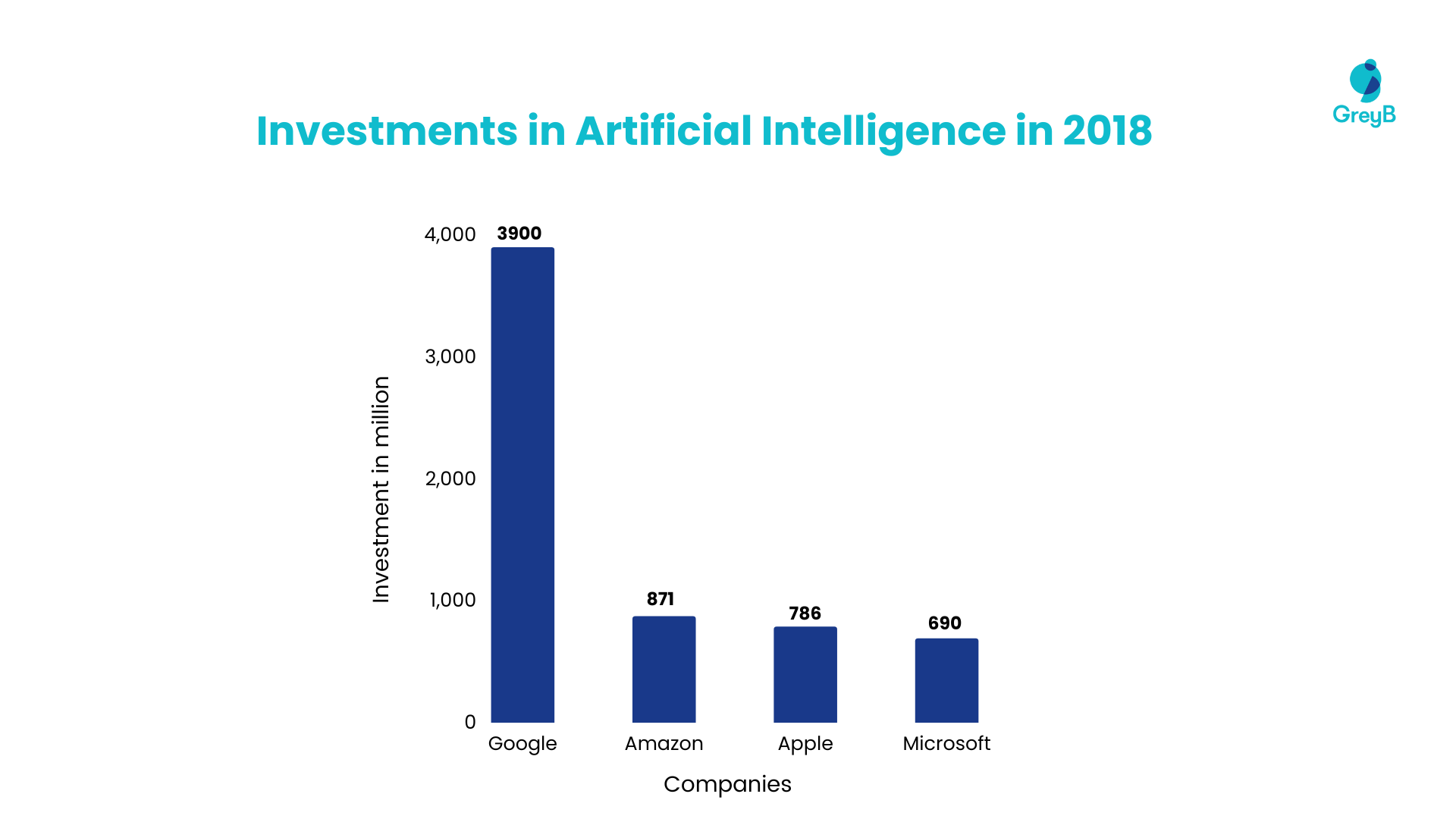
Since 2006, Google has invested over $3.9 billion in AI in disclosed transactions. There have been several organizations that have invested money in acquiring AI startups up till 2018. Some of these businesses are Amazon ($871 M), Apple ($786 M), and Microsoft ($690 M).
Acquisitions Related to AI
According to a report from GlobalData, Apple acquired around 25 artificial intelligence firms between 2016 to 2020. The various acquisitions that Apple made include:
- Emotient (Jan 2016)
Emotient, a San Diego business developing artificial intelligence technology that scans facial expressions to determine emotions, was bought by Apple. Apple did not specify the details of the acquisition in the report.
- Flyby Media (Jan 2016)
Apple acquired Flyby Media, an augmented reality business that created technology that lets mobile phones “see” the world around them. Apple has been interested in virtual reality for several years. The purchase occurred shortly after Apple announced the hiring of a prominent AR/VR specialist, Doug Bowman. Apple may have been working on technology that will someday find its way to the iPhone, similar to Google’s Project Tango, which delivers computer vision to mobile devices.
- Gliimpse (August 2016)
Gliimpse, a health data firm, was purchased by Apple for around $200 million. Gliimpse allowed users to import their medical information into a single virtual environment. Apple’s incorporation of Gliimpse into its existing products appeared to be more evident, given that the business has been working on health-related software for some years now. It was simple to see how Gliimpse, with its structured data centered on individuals, would be useful in products such as HealthKit, ResearchKit, and CareKit. Thus opening a gateway for Apple in the healthcare sector .
- Turi (August 2016)
Turi, a machine learning and artificial intelligence business, was purchased by Apple for more than $200 million. The acquisition is part of Apple’s bigger push into artificial intelligence and machine learning. Apple’s ambitions for Turi’s technology are unknown, but the corporation has been expanding its Siri personal assistant and associated technologies to make a larger push into artificial intelligence.
- Tuplejump (September 2016)
Tuplejump, a machine learning team based in India and the United States, was bought by Apple. The acquisition was motivated by Apple’s interest in “FiloDB,” an open-source project developed by Tuplejump to quickly apply machine learning ideas and analytics to enormous volumes of complicated data as it came in.
- RealFace (February 2017)
Apple has spent $2 million acquiring the Israeli company RealFace, a cybersecurity and machine learning business focusing on face recognition technologies. RealFace’s software employs exclusive IP in the realm of “frictionless face recognition,” which enables quick learning from facial traits.
- DeskConnect (March 2017)
DeskConnect, the start-up behind Workflow, was acquired by Apple. Workflow is similar to Automator, an Apple utility tool that comes with macOS Sierra but has no iOS counterpart. DeskConnect’s namesake cross-platform file-transfer tool was discontinued last month. Apple’s AirDrop, Handoff, and Universal Clipboard, among other services, were recommended by the firm.
- Lattice Data (May 2017)
Apple invested $200 million in acquiring Lattice Data, an AI firm. By acquiring Lattice Data, Apple was prepared to expand into machine learning and artificial intelligence. Around 20 engineers also joined Apple.
- SensoMotoric Instruments (June 2017)
SensoMotoric Instruments, a German provider of eye-tracking eyewear and systems, was acquired by Apple. SensoMotoric has created eye-tracking technology for virtual reality headsets such as the Oculus Rift, which monitors the wearer’s gaze and aids in the reduction of motion sickness, a major side effect of VR. Apple revealed a prototype set of “smart glasses” that would link to an iPhone and show the wearer “pictures and other information.”
- Regaind (September 2017)
Regaind, a French firm, was bought by Apple. Regaind had been working on a machine vision API for analyzing photo content. Apple used this technique to improve the Memories tab in the Photos app. iOS builds albums depending on events, location, and other factors. Using Regaind, iOS may search for aesthetically similar photographs, display the best image as cover art, and generate a recap movie with the finest photographs. Apple has integrated Regaind technology with the new Face ID sensor in the iPhone X, for example, to enhance animoji facial expressions.
- Pop Up Archive (December 2017)
Pop Up Archive, an Oakland-based online platform focused on developing tools to transcribe, organize, and search audio recordings, was bought by Apple. Apple, the long-dominating hands-off curator of the podcast world, has bought a technology aimed at boosting the knowability and sortability of the hundreds of thousands of broadcasts delivered via its Apple Podcast platform.
- Spektral (October 2018)
Apple invested over $30 million in Spektral, a computer vision business in Denmark that has worked on segmentation technology. Spektral’s initial application may have been the rather outdated world of school photos and the most prominent contribution Spektral might make to Apple’s photographic industry.
- Asaii (October 2018)
Apple invested less than $100 million in Asaii, a music analytics start-up focused on discovering new and rising musicians. The acquisition comes as Spotify, Apple Songs’s major competitor, expands its reach beyond conventional popular performers and supports unsigned musicians, who may now submit their music straight to the service.
- Silk Labs (November 2018)
Silk Labs, a firm focused on developing on-device machine learning software, had been acquired by Apple. The purchase perfectly fit Apple’s privacy-focused approach to artificial intelligence. Apple followed a similar approach to AI development, distinguishing itself from competitors such as Google, which collects large volumes of user data and analyses it on the cloud.
- PullString (February 2019)
PullString was acquired by Apple for around $30 million. It is a big indication of Apple’s plan to make Siri creation easier for iOS developers. The acquisition also provides Apple with extensive domain experience in the areas of voice app development, voice app designer and developer requirements, and the complexities of both Amazon Alexa and Google Assistant.
- Laserlike (March 2019)
Laserlike, a machine learning start-up, has been bought by Apple. Laserlike uses machine learning to collect massive amounts of data from the web and then give user-specific findings via an eponymous app. The transaction was made for an unknown purpose, according to Apple. Laserlike’s team may be trying to improve Siri’s long-struggling capacity to retrieve relevant information from the web.
- Lighthouse AI (March 2019)
Apple purchased Lighthouse’s patents for AI-powered home security cameras (eight patents and patent applications). Even the Lighthouse’s Co-Founders, along with about 20 employees, had joined Apple. Apple’s current emphasis on AI-driven home security systems is part of a broader tech industry embrace of so-called smart or connected homes, which include a large number of AI-driven and machine-to-machine gadgets.
- Drive.ai (June 2019)
Apple bought Drive.ai in June 2019. As a consequence of the agreement, hundreds of Drive.ai developers joined the tech giant’s top-secret Project Titan. Apple bought the company’s assets, including its self-driving vehicles.
- Spectral Edge (December 2019)
Apple invested an unknown sum in another UK start-up, Spectral Edge, in an apparent move to strengthen the iPhone camera. Spectral Edge created Phusion, a computer photography approach that employs infrared light that is invisible to the human eye to sharpen and restore color in smartphone images.
- Xnor.ai (January 2020)
Apple acquired Xnor.ai, a Seattle business specializing in low-power, edge-based artificial intelligence solutions. The transaction was completed for around $200 million. According to the agreement, Xnor’s AI-enabled picture identification technologies might become standard capabilities in future iPhones and cameras.
- Voysis (April 2020)
Apple Inc. acquired Voysis, an Irish artificial intelligence firm, in April 2020 for an undisclosed amount. Voysis’ technology, which includes a platform that adds vocal interactions to digital shops, might be used to improve the understanding of what consumers say by Apple’s Siri speech assistant.
- Inductiv Inc. (May 2020)
Apple Inc. acquired Inductiv Inc., a machine-learning firm situated in Ontario, Canada. Inductiv created technology that employs artificial intelligence to automate the job of detecting and repairing data problems. This technology will be used by Apple in a variety of products and improve Siri data.
- Subverse Corp.(Scout FM) (September 2020)
Apple Inc. acquired Subverse Corp. (Scout FM), a start-up that makes listening to podcasts more like tuning into radio stations, to strengthen its service in the face of increasing competition from Spotify. While other podcast applications, such as Apple’s, allow users to select an individual podcast to listen to, Scout FM established podcast stations on various themes. Scout FM was popular among Apple device owners and could be linked with CarPlay. This interface shows on compatible car screens when an iPhone is connected, and Apple’s Siri digital assistant.
- Vilynx (October 2020)
Apple Inc. invested $50 million in acquiring the artificial intelligence and vision firm Vilynx Inc. Vilynx technology might be adapted to Siri and Apple’s general search operations.
Apple Services
Apple has been working on different services to increase revenue, especially when iPhone sales are declining since 2018. Apple knew that it was bound to happen, so the company made several tactics to boost its revenue. One is simply to increase the price.
Apple iPhone, iPad, Watch, and Macbook average prices have seen growth that helped Apple consistently increase its revenue. But that tactic was a short-term plan and Apple Couldn’t rely on it for the long term. That’s where Apple services come into the picture.
Apple has introduced several services in the past 6 to 7 years, such as Apple Pay, App Store, Apple News+, Apple Music, Apple TV+, Apple Podcasts, Apple Fitness+, etc.
Apple generated $53.7 Billion in 2020 through its services, which accounted for 19% of total revenue. Surely, the number will keep growing in the coming years as Apple has a solid user base and is making the services a part of their ecosystem, which will help in user experience.
iMessage is Apple’s instant messaging service for iPhone, iPad, and Mac devices. iMessage, which debuted with iOS 5 in 2011, allows users to share messages, photographs, stickers, and other content between any Apple devices through the Internet. iMessage is exclusively available on Apple devices. That implies users won’t be able to send an iMessage to their Android contacts. Apple prioritizes privacy, which is why everything users transmit as an iMessage is encrypted from beginning to end. This implies that no one can intercept or read it except the person to whom it was sent, even Apple. In reality, even if they have a smartphone, they cannot force their way into a user’s iMessages. No, not without a user passcode. Apple has been chastised by the US government for this same reason, since it cannot, even if it wanted to, expose iMessages.
Apple’s FaceTime is a video chat application. FaceTime was built by Apple on an open standard, which implies that it may be utilized across a variety of platforms and that other manufacturers may exploit FaceTime’s protocol. But instead, FaceTime was only available to customers of Apple products until recently. With the release of iOS 15, FaceTime is coming out of the Apple closet. The software giant is making it possible for people who have Android phones and Windows laptops to hop on FaceTime calls — no iPhone required (well not really tho).
Before you jump to search the FaceTime app on the play store, here’s the catch- you won’t find it. Users will be able to join a FaceTime call on their Android and Windows devices using a link, so long as the person scheduling or starting the call has an Apple device and an Apple account. It now has a market share of less than 0.01%. Zoom is the market leader in this industry, with a 39.66% market share followed by GoToWebinar with a 20.64% market share, and Cisco Webex with a 16.48% market share.
Apple Maps and Google Maps have transformed the way we locate destinations, discover local businesses, and share directions with friends. Both serve the same objective, although their navigation tools and interfaces differ slightly . Google Maps, which debuted in 2005, has been the leading mobile mapping service since the smartphone’s inception. Apple acquired Placebase on July 7, 2009, to build its own Maps application for iPhone and iPad. This app didn’t come until 2012 and was stuck with technical challenges for years.
With the introduction of iOS 13 and iPadOS 13, Apple gained a foothold. Apple Maps was upgraded to exclude third-party navigation data in favor of new data obtained exclusively by Apple. The new maps are significantly more precise and accurate, thanks to millions of miles driven in camera- and LiDAR-equipped automobiles, new high-resolution satellite photos, Apple staffers canvassing areas on foot with radar modules strapped to their backs, and plenty of aerial photography.
Apple included routes for bicycles, routing for electric cars, congestion zones, and Guides for discovering the finest locations to visit in cities around the world in iOS 14 and iPadOS 14. Apple Maps is only available on Apple devices, including iPhones, iPads, and Apple Watches. It’s incorporated into all Apple-branded products, including Macs. It is not available on devices that are not part of the Apple ecosystem.
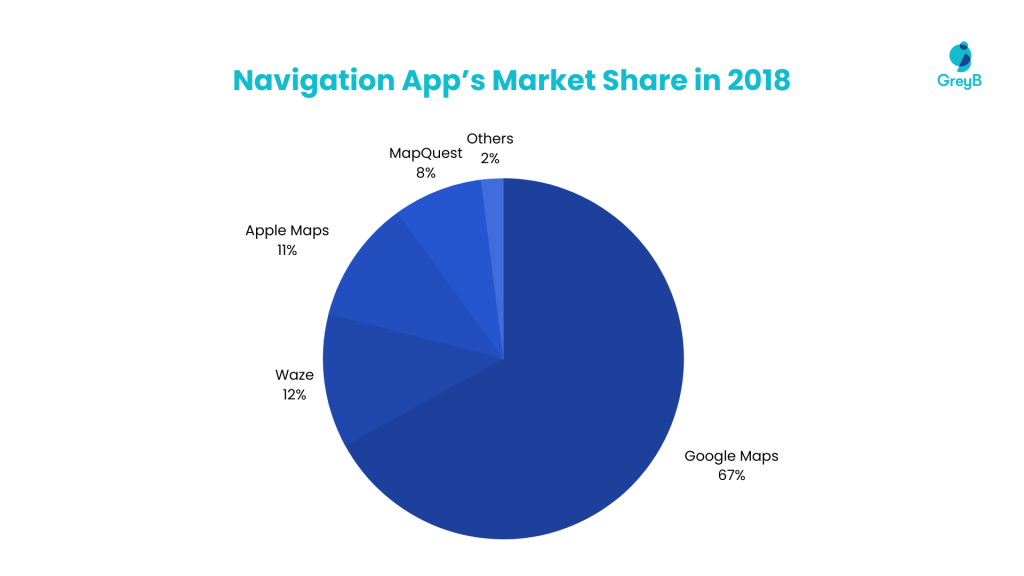
According to the latest survey data from The Manifest in 2018, the majority of smartphone owners use navigation applications, with the majority preferring Google Maps. It has a market share of 67% compared to 12% for Waze, 11% for Apple Maps, and 8% for MapQuest.
Apple’s digital software distribution platform for iOS devices is known as the App Store. The App Store, which debuted in 2008, allows software developers to publish content designed exclusively for the iPad, iPhone, and iPod touch. Apps may also be downloaded for the Apple Watch through the iOS App Store.
The App Store is more than just a shop; it is an innovative place dedicated to delivering incredible experiences. A large part of it is ensuring that the applications the firm provides adhere to the highest privacy, security, and content standards.
Android users have a choice of 3.48 million apps as of the first quarter of 2021, making Google Play the app store with the most available apps . With about 2.22 million iOS apps available, the Apple App Store stands second in the ranking.
While the actual number of applications may vary since Apple and Google constantly delete low-quality material from their app stores, the number of applications has continuously increased over the years.
Since 2008, the App Store has paid out more than $200 billion to developers.
According to mobile expert Horace Dediu, who provided even more current data which are as follows:
- $1.8 billion in App Store sales over the week between Christmas Eve and New Year’s Eve (+27% year on year)
- $540 million in App Store sales on January 1, 2021 (+40% year on year)
- 600 million: The number of iPhone users with an active subscription.
According to Apple, the App Store saw $643 billion in total commercial transactions in 2020, a 24% increase compared to 2019. At the present rate of growth, the indicated economic value might exceed $1 trillion within two years.
Apple TV+ is Apple’s own TV and movie streaming service. It features award-winning shows, captivating dramas, ground-breaking documentaries, children’s entertainment, comedy, and more. Every month, new Apple Originals are added. The service is positioned as Apple’s direct competitor to Netflix, Amazon Prime Video, and Disney+, and will exclusively offer original programming via the existing Apple TV app, which is available on various platforms.
It is available on a monthly subscription basis and is accessible across several devices via the most recent version of the Apple TV app. Apple TV+ provides ad-free, unique programming that has either been green-lit or created in-house by Apple.
A family membership to Apple TV+ costs £4.99 / $4.99 per month. Apple’s services package, which includes Apple Music, Apple TV+, Apple Arcade, Apple News+, and Fitness+, was launched in October 2020. Apple TV+ is accessible on iOS/iPadOS devices and the Mac via the Apple TV app.
A survey was conducted in May 2020, with Apple’s reader at Android Authority, ‘Which streaming service would they pick if they could only pick one?’ From this survey, it was seen that Apple TV+ captured less than 1% of the total vote. The majority of consumers complained that the library was just too small, while it would work better as a second or third membership for people who can’t get enough content.
Position in the Market Compared To Others
Apple TV+ was marketed as a unique curated stream of entertainment available exclusively through the Apple TV app. Despite Apple’s investments in new movies and programming for its streaming service Apple TV+, the platform is still considered to gain a large success. During the fourth quarter of 2020, it was reported that Apple TV+ has only a 3% market share in the United States, trailing competitors such as Netflix, Disney+, and even Peacock.
Apple TV+ was not the most popular streaming service in the fourth quarter of 2020. Apple TV+ trailed Peacock, NBCUniversal’s streaming service launched in July 2019, which had a 6% market share during the same period. Netflix maintained its 31% market share of streaming platforms in the United States, while Amazon Prime Video grew and drew close to 22%. Hulu came in second with 14%, followed by Disney+ with 13%, and HBO Max with 9%.
In 2020, Apple had a terrible year because most productions were halted due to the COVID-19 pandemic. Apple TV+’s catalog is extremely modest in comparison to its competitors because it only includes original movies and series. Apple extended the Apple TV+ trial term to members who had previously completed the one-year free trial in January 2021.
Apple is in a unique position since it both creates original video content and distributes third-party video bundles. Apple’s aim to become the “bundler of bundles” looks to profit when power shifts from one or two corporations to a lot of others. Apple TV+, Apple’s streaming video service, was priced at $4.99 per month, which was less than any other major provider.
As additional competitors plan to launch their services with larger video libraries consisting of famous series and movies, the firm was obliged to keep the pricing low . Within a few months of its inception, the one-year free trial had propelled Apple TV+ to the top of the streaming services.
Apple’s Plan to Increase Its Streaming Business
Tim Cook, Apple’s CEO, announced the debut of video streaming, news subscriptions, and a credit card in 2019. Apple took a calculated move to join the video streaming sector. The choice to enter the video streaming market is a little departure from the company’s core business, which has garnered its brand recognition.
Furthermore, since Apple has broadened its horizons in the services category, the launch of a video streaming service appeared to be an opportune decision, since this sector has a lot of untapped development potential.
- Online video streaming might be thought of as a replacement for television. In the United States, video streaming services have already surpassed television in terms of household penetration, with 69% of homes using a video streaming service.
- Apple has the economies of scale to enter this market with relative ease. It has significant client loyalty and may be able to gain clients more readily as a result of its loyal client base. Furthermore, with the aid of its existing products, the firm may be able to effortlessly pull in its existing consumers on video streaming services.
Apple TV+ is less expensive than the majority of its competitors. It costs $4.99 per month, which is less than half the price of a standard Netflix membership, and it is free for the first year for customers who buy Apple gadgets. Even now, Apple has been collecting older movies and episodes for its TV+ streaming service, intending to build a back library of material that can compete with the massive libraries offered on Netflix, Hulu, and Disney+. According to sources familiar with the topic, the company’s video-programming executives have received presentations from Hollywood studios about licensing older content for TV+ and have purchased several episodes and movies.
It is predicted that in the future the company might acquire Disney . If Apple is serious about becoming a large SVOD player, which they may not be, abandoning Apple TV+ and redirecting its programming to Disney’s established streaming portfolio makes sense. Disney is the only studio large enough to propel Apple into streaming dominance, and it just so happens to fit Apple’s family-friendly image and public values.
“Apple can easily push the Disney streaming apps onto every phone and make certain offerings free for everyone in markets that are underserved.” – David Offenberg, Associate Professor of Entertainment Finance in LMU’s College of Business Administration
Apple had planned to introduce augmented reality material to Apple TV+ , as it sought new methods to attract and keep members, as well as generate interest in AR technology. Even the ‘Bonus content’ has been one of the numerous ways in which Apple has attempted to increase the value of TV+ and keep consumers enrolled. Apple is planning to launch podcasts based on existing TV+ series. Apple is planning to release a headgear that combines augmented and virtual reality in 2022, with an emphasis on gaming, media consumption, and virtual meetings.
Apple Music
Apple Music was launched in 2015 and is a music streaming service that offers access to over 70 million songs. Its fantastic features include the option to download favorite tracks and play them offline, real-time lyrics, listening across all of your favorite devices, new music customized specifically for its users, curated playlists from their editors, and many more. All of this is in addition to exclusive and unique material.
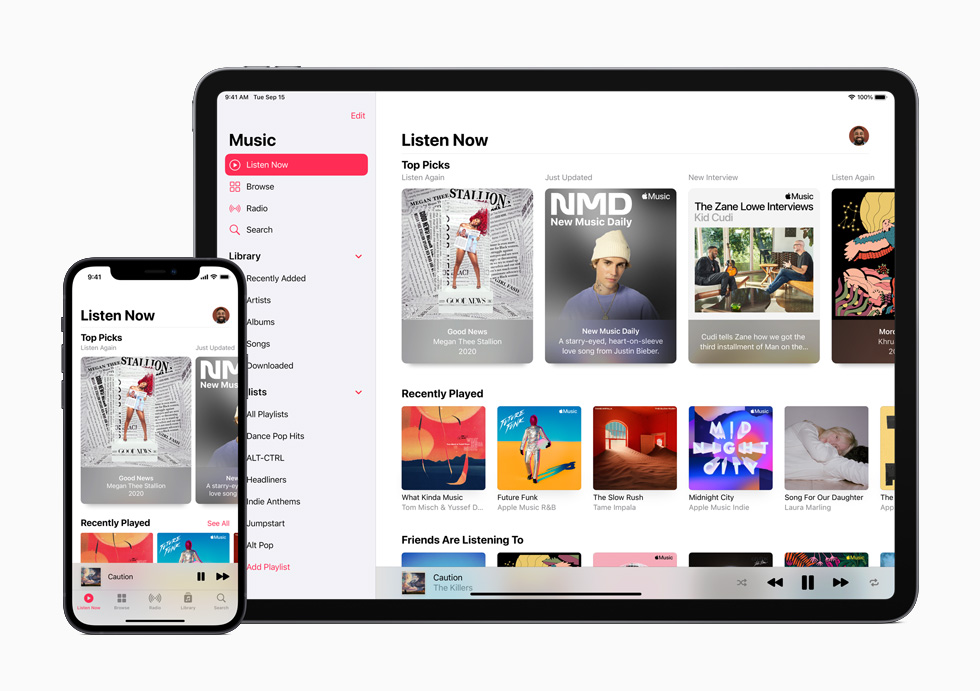
Apple Music also includes live radio stations and connectivity with Siri, allowing users to operate most of their devices with voice commands. The Apple Music service not only allows one to stream any tune from the iTunes collection on demand, but it also allows one to access all of the music in one location on all of the devices, whether purchased from iTunes, copied from a CD, or downloaded from the web. Individual plans cost £9.99 (US$9.99) per month. A Family subscription, which can accommodate up to six people, costs £14.99 or $14.99 per month, which is less than Spotify’s equivalent. The University Student plan, which costs £4.99/$4.99 a month, is the final option.
This streaming service now supports lossless streaming quality up to 24-bit/192 kHz! This app is available even for Android OS users to download and get a subscription, starting at only $1.19 or ₹99 per month. University students can get it even cheaper with free Apple TV+, making it one of the world’s best and surprisingly affordable lossless music streaming services. It’s unlike Apple to open up its ecosystem to other players, but audiophiles certainly appreciate this move.
Acquisitions and Collaborations
- On August 1, 2014, Apple acquired Beats Music & Beats Electronics for $3 billion.
“Music is such an important part of all of our lives and holds a special place within our hearts at Apple. That’s why we have kept investing in music and are bringing together these extraordinary teams so we can continue to create the most innovative music products and services in the world.” – Tim Cook, CEO of Apple
Beats Electronics began to employ Apple’s patented technology in various products following the acquisition, such as the W1 chip in select Bluetooth headphones. Apple shut down Beats Music at the end of the year in anticipation of the 2015 launch of Apple Music.
- In Jan 2015, Apple purchased Semetric , a business that analyzes music data online. This agreement was reached to revitalize the development of iTunes and Beats Music. Apple’s interest in Semetric is most likely limited to the Musicmetric product, which might be used to reliably compute record label royalties for a music streaming service like Apple Music. After purchasing Beats for $3 billion last year, Apple expressed a desire to extend its online music services with the acquisition.
- Apple purchased technologies from cloud-based music platform Omnifone in November 2016 and employed at least a dozen (at least 16) former Omnifone workers. Omnifone provided “white-label” music services, which allowed businesses to provide their personalized music services to clients and subscribers. Many former Omnifone employees have gone on to work as software developers at Apple, presumably in areas such as iTunes and Apple Music.
- In April 2021, Pinna, an on-demand audio entertainment service provider, announced collaborations with Apple . “Pinna is thrilled to be on the forefront of this exciting launch in collaboration with Apple.”, said Maggie McGuire, CEO of Pinna. Apple Podcasts Subscriptions will let them expand their worldwide reach even further, providing them with a unique ability to personalize channels to certain demographics and interests.
Apple has joined a crowded, competitive field populated by banks and upstart fintech companies. Tim Cook provided some insight into the company’s progress toward becoming a financial player during the company’s quarterly earnings call in 2018.
Apple Pay transactions increased from the previous year to over 1 billion in 2018. Apple had been working on a credit card with Goldman Sachs and MasterCard. In 2019, Apple launched its Apple credit card in collaboration with Goldman Sachs and MasterCard.
According to the firm, Apple customers were able to sign up for the new card using their iPhones in the summer of 2019. It revolves around Apple Pay, the company’s mobile payment and digital wallet service, which debuted in 2014.
Even though Apple was late to the credit card industry, its marketing prowess and dedicated client base allowed the business to expand very swiftly. Tim Cook, Apple’s CEO, indicated that more than 70% of U.S. shops accept Apple Pay and that around 40 countries had joined by the end of 2019.
- The Apple Card is more likely to put branded credit card issuers under competitive pressure than Goldman’s rival banks. Apple may continue to provide additional financial products to its customers, notably bank accounts, which are a good complement to credit accounts.
- According to Gene Munster of Loup Ventures, Apple Pay is still active on around 25% of all iPhones in the United States. This would hasten the adoption of Apple’s payment method since, unlike Apple Pay, the card could be used everywhere.
- Apple also paid around $100 million for acquiring Mobeewave, a payments start-up. The payment startup provides near-field communications (NFC) technology, which allows smartphones to be used as payment terminals. The technology enables mobile payment options such as Apple Pay and Google Pay.
Apple Pay was launched in October 2014 and is an Apple Inc. mobile payment and digital wallet service that allows users to make payments in person, in iOS applications, and on the web using Safari. It is compatible with the iPhone, Apple Watch, iPad, and Mac.
Apple introduced person-to-person Apple Pay payments using the Messages app on the iPhone and Apple Watch in 2017. Apple Pay has surpassed Starbucks to become the most used mobile payment platform in the United States as of 2019.
In 2020, the Apple Card had around 3.1 million users in the United States. Apple Pay also allows customers to make one-tap purchases within applications that have implemented the Apple Pay API, and it is available on the web on iOS 10 or macOS Sierra or later devices.
Presently, Apple Pay is accepted by more than 85% of retailers in the U.S. Apple Pay is also available at a variety of locations other than regular retail outlets, such as colleges, ballparks, non-profit organizations, Bitcoin payment providers, and ATMs from Bank of America, Chase, and Wells Fargo.
Apple Inc. announced Apple Card in August 2019 in collaboration with Goldman Sachs and MasterCard. It is a credit card with Apple Pay branding that gives 2% cashback on Apple Pay transactions. In addition to cash benefits for Apple Pay transactions, the card provides financing alternatives for Apple devices.
Apple Card functions similarly to a traditional credit card, but it is deeply integrated into the Wallet app, providing real-time views of the most recent transactions as well as a comprehensive overview of spending organized by category, as well as payment options optimized to encourage minimal interest.
Apple also provides 3% cashback when using the Apple Card with Apple Pay to make purchases at Uber, Uber Eats, T-Mobile, Walgreens, Nike, and Duane Reade. Apple also intends to offer 3% cashback rewards to additional shops and applications in the future.
What are the Potential Future Products of Apple?
Ar/vr/mr devices.
Apple is developing a range of augmented and virtual reality products that will be powered by a new 3D sensor technology. They announced Vision Pro , a new extended reality headset, on June 5, 2023. Interestingly, they never used the terms “virtual reality” or “augmented reality” throughout their presentation and marketing material. Instead, they’re calling this their first “Spatial Computer.” We’re well familiar with Apple’s tendency to create unique names for everything in their catalog.
Interestingly, we noticed one of their recently granted patents on this technology was filed back on May 4, 2007. It indicates that Apple has been working on this headset idea since the same year they launched the first iPhone! Say what you will about their walled-garden ecosystem approach; their vision (no pun intended) and relentless spirit of innovation are truly commendable.
This headset won’t need any external controllers whatsoever. You just use eye movement, voice, and hand gestures! The product even supports 3D video capture, allowing users to record and store memories like never before.
Through the VisionOS interface on its immersive dual 4K displays, Apple may be positioning this headset as a future replacement for smartphones and other handheld computing devices. Looking at the company’s track record of delivering seamless tech integrations into its ecosystem, we believe that the Vision Pro would be a natural extension of everyday tech for an Apple user.
Apple acquired SensoMotoric Instruments in 2017. They were a German provider of dedicated computer vision applications. Their tech was used in ARKit and likely made its way to the Vision Pro. In the same year, they acquired VRvana, an augmented reality headset startup, for $30 million. A number of the startup’s employees had joined Apple in California. Their work and expertise would have made its way to the Vision Pro.
The product isn’t set to launch until early 2024 in the US, but their featured claims seem revolutionary in this niche. Its asking price of $3499 is undoubtedly a steep jump for most consumers, and Apple is aware of that. Financial Times reports that Apple has reduced its production supply goal from 1 Million in 2024 to 400,000. This product may take some time to pick up speed for all but the most tech-savvy of consumers and early adopters.
Apple Glass
Apple Glass is expected to operate on Starboard (or perhaps glassOS), a proprietary operating system revealed in iOS 13’s final version. The augmented reality framework appears several times in code and text documents, implying that Apple is testing activation and application. According to Bloomberg, Apple Glass will be available in 2023 at the earliest. Apple is getting closer to releasing a VR headset that will compete with the Oculus Rift 2.
According to Scoble, Apple will most certainly release AR glasses next year , giving it a 2-3 year head start on all competitors.
Apple’s objective is to personalize computers. The Cupertino firm has everything in place to launch an AR product to the masses:
- Hardware manufacturing competence and a stable supply chain allow for seamless integration with an iPhone, AirPods, and Apple Watch.
- It comes with its operating system, chip, and App Store.
Because every buyer of these AR glasses will almost certainly have an iPhone, Apple can provide a lightweight product at a reasonable price.
Apple’s foray into personal mobility appeared to have begun in 2014 , with the announcement of something named Project Titan. This project is about the company’s efforts to bring a Tesla-style electric vehicle to market before the end of the decade.
The Apple Car project has had many lead changes and hundreds of layoffs during its development, but it is presently led by John Giannandrea, Apple’s Chief of AI and machine learning, who took over from Bob Mansfield after Mansfield departed in 2020.
It was verified in December 2020 that Apple is still working on a car and now aims to produce a vehicle in three to six years. According to Ming-Chi Kuo, an Analyst at Apple, a car would not be launched until 2025 to 2027. Ming-Chi Kuo, an Apple analyst, believes the automobile will be the company’s “next star product,” with Apple able to offer greater integration of hardware, software, and services than prospective competitors in the automotive business, thanks to Apple-designed processors made by TSMC.
“We’re focusing on autonomous systems. It’s a core technology that we view as very important. We are sort of seeing it as the mother of all AI projects. It’s probably one of the most difficult AI projects to actually work on.” – Tim Cook, CEO of Apple
The first car chassis of Apple might be built on Hyundai’s E-GMP electric vehicle (BEV) platform. The Apple Car will almost certainly be sold as an “extremely high-end” or “substantially higher” model than a regular electric car. Apple has been aiming for a game-changing design that might be employed in a future driverless car.
Apple is also working on a novel battery architecture that has the potential to “radically” lower battery costs while increasing vehicle range. The battery technology has been compared to “the first iPhone” and hailed as “next level.” Apple intends to use a novel “mono cell” design that bulks out the individual cells in the battery while freeing up room inside the battery pack by removing pouches and modules that carry battery components.
Apple is also developing a self-driving shuttle service known as ‘PAIL’ (Palo Alto to Infinite Loop). The shuttle service will transport staff between Apple’s Silicon Valley headquarters. Apple is collaborating with Volkswagen and will put self-driving software in Volkswagen T6 Transporter vehicles that will act as staff shuttles.
In 2019 and 2020, speculations circulated that the project had shifted once again and that Apple was still pursuing an Apple-branded car. However, many speculations in late 2020 indicated that Apple is still working on a full-fledged Apple-branded automobile. This is primarily aimed towards customers, with ambitions to collaborate with an established vehicle manufacturer.
Under the secret name “Project Titan,” Apple had hundreds of people working on the design of a minivan electric car. This project is being led by Steve Zadesky, Apple VP of Product Design.
Apple bought Drive.ai , a self-driving car startup, in June 2019. For its self-driving vehicle project, Apple engaged many Drive.ai professionals in engineering and product design. According to Axios, Apple bought the company’s assets, including its self-driving cars.
Drive.ai vans are customized Nissan NV200s that operate in a restricted region near major sites and sports venues. This acquisition was made primarily to improve the company’s autonomous vehicle development effort.
According to Morgan Stanley analysts, Apple spent approximately $19 billion on research and development in 2020, which equates to almost one-fifth of the overall R&D investment across the automotive sector (about $100 billion).
By May 2020, 700 employees were working on Apple AV Tech in the Bay Area.
What does Apple M&A Landscape look like?
Apple is well-known for its strict secrecy, especially when it comes to new iPhone releases. Apple has completed around 100 mergers and acquisitions in the last six years, the majority of which was done in secret. Apple has rigorous nondisclosure agreements in place and urges acquired staff not to update their LinkedIn pages.
The top 10 major acquisitions that Apple has made are mentioned below:
Apple’s Top 10 Acquisitions
Acquisition of beats.
The highest amount at which Apple did an acquisition on August 1, 2014, was at $3 billion, for Beats Music & Beats Electronics. This acquisition includes buying both Beats Audio hardware and Beats Music. One of the main reasons for this acquisition was the talent and reputation that Apple looks for when creating new products and services. Another relevant reason is Apple wanted to modify and uplift its iTunes. Therefore, Apple began acquisition negotiations with Beats just four months after their Beats Music service first debuted. Even Apple was impressed by the amount of revenue that Beats generated from their headphones.
Acquisition of Intel Smartphone Modem Business
In July 2019, the acquisition of Intel Smartphone Modem Business for $1 billion was Apple’s 2nd largest acquisition ever. In this deal, Apple had acquired the majority of Intel’s smartphone modem business. This deal also included the transactions of intellectual property, equipment, and approximately 2,200 Intel employees joining Apple. The agreement aided Apple in acquiring a large portfolio of wireless patents from Intel. More than 17,000 wireless technology patents have been held by Apple, ranging from cellular network protocols to modem architecture and modem service. According to multiple reports, Apple intends to produce its modems for iPhones by 2022-2023, and this Intel contract will undoubtedly aid those efforts.
Acquisition of Dialog Semiconductor
On October 11, 2018, Apple went under a deal to license IP, acquire assets and talent from Dialog Semiconductor to expand chipmaking in Europe at a deal of $600 million. The deal also involved more than 300 Dialog staff transitioning to Apple employees, becoming part of Apple’s hardware technologies team under Johny Srouji. In some cases, Apple will take over whole buildings formerly occupied by Dialog, and in others, they will co-locate in buildings where Dialog will continue to grow its own business.
Acquisition of Anobit Technologies
In December 2011, Apple went under an acquisition with Anobit Technologies , an Israeli semiconductor startup. The deal was completed at approximately $500 million. The main two reasons for which this acquisition was made include the flash memory controllers of Anobit made a key component of all Apple’s leading products (from iPads and iPhones to MacBook Airs) and finally the acquisition added a large team of chip engineers to payroll. Flash memory has been a crucial piece of Apple’s technology puzzle.
Acquisition of Texture
In March 2018, Apple acquired Texture , a digital magazine service by Next Issue Media LLC. The deal was done for $485 million, and it provided subscribers with unrestricted access to their favorite titles with a single monthly subscription fee.
“We’re excited Texture will join Apple, along with an impressive catalog of magazines from many of the world’s leading publishers. We are committed to quality journalism from trusted sources and allowing magazines to keep producing beautifully designed and engaging stories for users.” – Eddy Cue, Apple’s Senior Vice President of Internet Software and Services
Acquisition of Shazam
On September 24, 2018, Apple acquired Shazam to have more opportunities to explore and experience music. The deal was finalized at $400 million.
“Apple and Shazam have a long history together. Shazam was one of the first apps available when we launched the App Store and has become a favorite app for music fans everywhere. With a shared love of music and innovation, we are thrilled to bring our teams together to provide users even more great ways to discover, experience, and enjoy music.” – Oliver Schusser, Apple’s Vice President of Apple Music
In May 2018, Apple revealed that Apple Music had reached 50 million users.
Acquisition of Next Software
Back in 1996, Apple had acquired Next Software at a deal of $400 million. Apple paid approximately $350 million in cash and stock for the privately held Next to purchase that company’s shares and an additional $50 million to cover its debts.
Since its technology was agile, Apple hoped that Next’s object-oriented, Java-enabled open software platform would greatly boost its Internet and intranet status. It also aimed to capitalize on Next’s enterprise role.
“This is a complementary arrangement, and the pieces fit together better than any other alternative we looked at, and it will launch a new round of technology.” – Gilbert Amelio, Former Chairman and CEO at Apple
Acquisition of PrimeSense
In 2013, Apple acquired PrimeSense , an Israeli-based pioneer in 3D sensor technology. The deal was completed at approximately $360 million. PrimeSense’s system could potentially be used in a variety of Cupertino devices. This acquisition was Apple’s second purchase of an Israeli company, as it bought Anobit in January 2012. Apple did not disclose the intentions behind the purchase of PrimeSense.
Acquisition of AuthenTec
In 2012, Apple bought AuthenTec , a fingerprint sensor technology developer for approximately $356 million. The fingerprint technology, used in mobile phones in Japan for authentication of mobile payments, would help Apple bring those services to markets such as the United States.
Apple had also acquired the right to pay the company to license certain patents totaling as much as $115 million. AuthenTec’s authentication features would be integrated into Apple’s iPads, iPhones, and potentially as security measures for other features, such as non-mobile computer systems or cloud-based networks or services.
Acquisition of PA Semi
In 2008, Apple acquired PA Semi , a chip designer for approximately $278 million. This acquisition was a strategic move by Apple, as it aimed to continue to differentiate its next-generation handheld products amongst a growing fleet of competitors. Even the power savings offered by P.A. Semi’s designs may have been amongst the firm’s most compelling assets in Apple’s eyes.
Now, let’s move forward to Apple’s top 5 Market regions besides the US.
What are Apple’s Top 5 Markets besides the US by Revenue?
Apple’s top markets besides the US by revenue include the regions from Europe, Greater China, Japan, and the rest of Asia Pacific. America’s high income is partly attributable to Apple’s good performance in its home market, the United States. Apple has by far the greatest market share among smartphone suppliers in the United States.
Even though overseas sales account for a greater portion of Apple’s overall income, the United States still accounts for around 40% of Apple’s net sales.
During the years 2020 and Q1 2021, the annual revenue of Apple is divided into several regions, such as the U.S., Europe, Greater China, Japan, and the rest of Asia Pacific. The new iPhone 12 Pro and 12 Pro Max, now in their 14th iteration, continue to contribute to the success of Apple’s trademark product, helping push for year-on-year iPhone sales increase despite the COVID-19 pandemic.
Apple gained 28% of the European market in the first quarter of 2020, making it the company’s greatest first quarter of the fiscal period. Even in China during the year 2020, Apple captured a market share of approximately 10.5% . In Q4 2020, Apple was the only brand that showed positive year-on-year growth in the China market that year.
The following table shows the annual revenue:
Source: Statista
What does Apple’s Investment Landscape look like?
With the accelerating pace of technological change, investing in startups has become a key part of Apple’s corporate strategies. By doing so, they also tend to closely monitor their smaller brethren. Given below are the top 5 investments made by Apple.
Top 5 Investments Made by Apple
Apple has made several investments in startup companies globally. Amongst them, the top 5 investments include:
- In May 2016, Apple announced it had invested in a Chinese ride-hailing service, Didi Chuxing . Apple invested around $1 billion to help Apple to understand the critical Chinese market. The investment gave Apple a stake in two burgeoning waves of technology, i.e., the sharing economy and car technology. Even Apple has been trying to reinvigorate sales in China, where it has come under greater pressure from regulators.
“From a Didi point of view, we see that one, it is a great investment. Two, we think that there are some strategic things that the companies can do together over time. And three, we think that we’ll learn a lot about the business and the Chinese market beyond what we currently know.” – Tim Cook, CEO of Apple
- Even in June 2016, Apple and other firms backed unicorn Didi Chuxing Technology , which raised $4.5 billion in a fundraising drive to oppose Uber’s assault on the Chinese market.
- On March 31, 2021, Apple invested an amount of $50 million in UnitedMasters, a music distribution, and data analytics company. The platform aims to democratize the music industry by allowing budding musicians to earn money and get distribution across a variety of music platforms, including Spotify and Apple Music. This agreement marks the beginning of a strategic engagement with Apple, which will open up a plethora of new prospects for UnitedMasters artists.
“Steve Stoute and UnitedMasters provide creators with more opportunities to advance their careers and bring their music to the world.” – Eddy Cue, Apple Executive
- In March 2016, Apple, together with Blackboard, Dropbox, Udemy, and other companies invested around $2.3 million in Volley Labs , a learning technology firm. Volley’s primary goal is to provide technology that assists students, particularly those enrolled in advanced high school or college curricula, in understanding the content they are learning by surfacing relevant, machine-curated explanations from the web via their mobile devices. The Volley’s funders’ ultimate goal is to spare students from spending too much time “processing” material and redirect their time and energy on meaningful learning.
- On November 21, 2015, Apple invested in God-i , a startup that specialized in wearable devices in the seed round. But afterward, Apple exited from further investments in God-i.
- On February 25, 2019, Apple along with other investors invested an amount of $21 million in FreightWaves during a Series B funding. FreightWaves is a data and content forum that delivers near-real-time statistics to industry players.
Apart from investing in smaller companies and startups, collaboration is another strategy opted by Industry giants such as Apple. Let’s look at the top 10 partnerships and collaborations Apple has made over the past years.
Top 10 Partnerships/Collaborations Made by Apple
The various top partnerships and collaborations that were made by Apple are mentioned below:
- In September 2020, Singapore’s government and Apple announced a collaboration on the health initiative LumiHealth, which would use Apple Watch. LumiHealth, developed in partnership with a team of physicians and public health professionals, encourages the use of technology and behavioral insights. Singaporeans might use their Apple Watch and iPhone to stay healthy and complete wellness challenges.
“Singapore has one of the world’s leading healthcare systems, and we are thrilled to be partnering with them to incorporate Apple Watch and LumiHealth into their holistic approach to well-being” – Jeff Williams, COO of Apple
- In April 2020, Google and Apple announced a partnership initiative to use Bluetooth technology to help governments and health organizations in reducing the transmission of the COVID-19 virus, with user privacy and security at the forefront of the design. Both organizations would offer APIs in May that would allow Android and iOS devices to communicate with public health applications. Users would be able to download these official apps from their respective app stores.
- In October 2017, Apple and GE launched a collaboration to deliver powerful industrial applications that would provide predictive data and analytics from Predix, GE’s industrial Internet of Things (IoT) platform, to iPhone and iPad. The corporations announced the release of a new Predix software development kit (SDK) for iOS, which would provide developers with the tools they require to build their own powerful industrial IoT apps.
“Together, Apple and GE are fundamentally changing how the industrial world works by combining GE’s Predix platform with the power and simplicity of iPhone and iPad.” – Tim Cook, CEO of Apple
- In August 2017, Apple and Accenture announced a collaboration to help businesses revolutionize the way employees interact with consumers by developing new business solutions for iOS. Accenture Digital Studios would establish a dedicated iOS practice in key locations across the world. The two firms would provide a new set of tools and services, including IoT, to assist businesses in unlocking new income sources, increasing efficiency, improving customer experience, and lowering expenses.
- In September 2016, Apple and Nike unveiled the Apple Watch Nike+, the latest product of their long-standing collaboration. Apple Watch Nike+ has been the ideal running tool, combining exclusive Nike Sport Bands with the Apple Watch Series 2, including GPS, a two-times brighter display, 50-meter water resistance, a strong dual-core CPU, and watchOS 3.
“Apple Watch Nike+ takes performance tracking to a whole new level and we can’t wait to bring it to the world’s largest community of runners.” – Jeff Williams, COO of Apple
- In May 2016, Apple and SAP announced a collaboration to reimagine the mobile work experience for corporate clients of all sizes by combining powerful native apps for the iPhone and iPad with the better capabilities of the SAP HANA platform.
“As the leader in enterprise software and with 76% of business transactions touching an SAP system, SAP is the ideal partner to help us truly transform how businesses around the world are run on iPhone and iPad. Through the new SDK, we’re empowering SAP’s more than 2.5 million developers to build powerful native apps that fully leverage SAP HANA Cloud Platform and tap into the incredible capabilities that only iOS devices can deliver.” – Tim Cook, CEO of Apple
- In 2016, Apple and Deloitte announced a collaboration to assist organizations to accelerate business transformation on iPhone and iPad. They would also collaborate on the creation of EnterpriseNext, a new service offering from Deloitte Consulting designed to help clients fully leverage the iOS ecosystem of hardware, software, and services in the workplace.
“Our dedicated Apple practice will give global businesses the expertise and resources they need to empower their mobile workforce to take advantage of the powerful ecosystem iOS, iPhone, and iPad offer, and help them achieve their ambitions while driving efficiency and productivity.” – Punit Renjen, CEO of Deloitte Global
- In August 2015, Apple announced a partnership with Cisco to build a fast lane for iOS business customers by optimizing Cisco networks for iOS devices and apps with the integration of iPhone with Cisco corporate settings to offer unique collaboration on iPhone and iPad.
“iPhone and iPad have become essential tools for the modern workforce and are changing the way work gets done. Together with Cisco, we believe we can give businesses the tools to maximize the potential of iOS and help employees become even more productive using the devices they already love.” – Tim Cook, CEO of Apple
- In July 2014, Apple and IBM announced an exclusive collaboration that would combine each company’s strengths to improve workplace mobility by integrating IBM’s big data and analytics capabilities to iPhone and iPad. The collaboration would improve in the integration of Apple’s machine learning framework, Core ML, with IBM Watson, resulting in strong insights that become deeper with time and use. The alliance would include exclusive IBM cloud services optimized for iOS, such as device management, security, analytics, and mobile integration.
- In 2013, Square partnered with Apple to offer the new Square Stand, a point-of-sale system through Apple’s extensive retail network. The Square Stand is an iPad accessory with the capacity to connect to a variety of devices including cash registers, barcode scanners, and printers. In addition, the gadget has a built-in credit card reader. In 2016, the company announced a new collaboration that would allow consumers to connect money saved on Square’s virtual card, Square Cash, to their Apple Wallet.
Future Outlook
Apple has been doing more than good for a long time and say since the company launched the iPhone.
For the 10th consecutive year, Forbes magazine ranked Apple as the most valuable brand in the world in 2020. Apple’s great track record should continue as long as future management takes care of the brand and pushes it into new sectors. Apple’s breakthroughs are often incremental, with the company adapting its design prowess to the most recent consumer tech trends.
Looking ahead ten years, the Apple of 2030 should continue to progressively enhance its hardware products while also introducing new ones such as Apple automobiles, AR/VR headsets, AR smart glasses, and so on. Apple will also broaden its brand to provide a suite of packaged consumer offerings.
In 2020, Apple executed an AR-related acquisition, acquiring NEXTVR for around $100 million, considering the future growth and vast applications of AR and how Apple can take advantage of it.
“When I think about that in different fields, whether it’s health, whether it’s education, whether it’s gaming, whether it’s retail, I’m already seeing AR take off in some of these areas with the use of the phone,” said Tim Cook on a podcast . “And I think the promise is even greater in the future.”
Aside from possible smart eyewear, Apple is said to be working on self-driving automobiles. Besides these new, futuristic initiatives, Apple is projected to continue selling a large number of iPhones, Apple Watches, iPad tablets, laptops, and desktops even ten years from now. By 2030, it’s feasible that Apple will have a version of almost every form of entertainment, financial, or other consumer service.
Apple announced an acceleration of its US investments, with plans to make additional contributions totaling more than $430 billion and create 20,000 new jobs throughout the country over the next five years, beginning in April 2021. Apple has increased its investment by 20% over the next five years, boosting American innovation and delivering economic benefits in every state. Tens of billions of dollars will be invested in next-generation semiconductor research and 5G innovation throughout nine US states.
“At this moment of recovery and rebuilding, Apple is doubling down on our commitment to US innovation and manufacturing with a generational investment reaching communities across all 50 states.” – Tim Cook , Apple CEO.
It is becoming undebatable that Apple has amassed enormous status and reputation across the world. The capacity of Apple to retain and satisfy users inside its ecosystem is at the heart of its sustained success. In a realistic scenario, the future growth of Apple from 2022 to 2031 is depicted below:
- In this scenario, iPhone revenue will be moderately higher at the end of the 10 years than in 2021.
- By 2031, the Mac will grow only by 5%, the iPad by 8%, Wearables, Home and Accessories by 20%, and Services by 15%. One new product introduction, Product X, will generate $10 billion in revenue by 2031.
Over 10 years, sales growth is 9.66%, a reasonable rate for a company of this size. The iPhone growth narrative is far from done, and a couple more upgrade cycles may drive a revival in growth over the following two decades. Even if App Store fees are reduced to 0%, Apple’s management will find another way to monetize service offerings.
Authored By: Vipin Singh, Market Research
Next Read: Amazon Business Strategy: Insights of its operation and investment plan to become the top Fortune 500 company
Also Read: Airbnb expanding into social media? A peek into Airbnb’s expansion plan
[…] What is Apple Business Strategy?; […]
[…] instance, Apple’s strategic plan in the early 2000s centered on designing groundbreaking products like the iPhone, which set clear […]
[…] 1. GreyB: Apple Business Strategy: A Detailed Company Analysis 2. EdrawMind: Apple Segmentation, Targeting, and […]
Leave a Comment Cancel reply

- Deepak Syal (Director)
- +91-8297806050
- Chakshu Kalra (Director)
- +91-9878481471
- UNITED STATES
- +1-202-455-5058
- +65 84306322

- Pooja Sehgal (HR)
- +91 8427102546
- Vaishali Shorey (Talent Lead)
- +91 7589465756
- hr@greyb.com
Become a part of GreyB’s insider list
Get our distilled learning delivered to you.
Get the Sample Report
Fill out the form and get the report.
- SUGGESTED TOPICS
- The Magazine
- Newsletters
- Managing Yourself
- Managing Teams
- Work-life Balance
- The Big Idea
- Data & Visuals
- Reading Lists
- Case Selections
- HBR Learning
- Topic Feeds
- Account Settings
- Email Preferences
How Apple Is Organized for Innovation
- Joel M. Podolny
- Morten T. Hansen

When Steve Jobs returned to Apple, in 1997, it had a conventional structure for a company of its size and scope. It was divided into business units, each with its own P&L responsibilities. Believing that conventional management had stifled innovation, Jobs laid off the general managers of all the business units (in a single day), put the entire company under one P&L, and combined the disparate functional departments of the business units into one functional organization. Although such a structure is common for small entrepreneurial firms, Apple—remarkably—retains it today, even though the company is nearly 40 times as large in terms of revenue and far more complex than it was in 1997. In this article the authors discuss the innovation benefits and leadership challenges of Apple’s distinctive and ever-evolving organizational model in the belief that it may be useful for other companies competing in rapidly changing environments.
It’s about experts leading experts.
Idea in Brief
The challenge.
Major companies competing in many industries struggle to stay abreast of rapidly changing technologies.
One Major Cause
They are typically organized into business units, each with its own set of functions. Thus the key decision makers—the unit leaders—lack a deep understanding of all the domains that answer to them.
The Apple Model
The company is organized around functions, and expertise aligns with decision rights. Leaders are cross-functionally collaborative and deeply knowledgeable about details.
Apple is well-known for its innovations in hardware, software, and services. Thanks to them, it grew from some 8,000 employees and $7 billion in revenue in 1997, the year Steve Jobs returned, to 137,000 employees and $260 billion in revenue in 2019. Much less well-known are the organizational design and the associated leadership model that have played a crucial role in the company’s innovation success.
- Joel M. Podolny is the dean and vice president of Apple University in Cupertino, California. The former dean of the Yale School of Management, Podolny was a professor at Harvard Business School and the Stanford Graduate School of Business.
- MH Morten T. Hansen is a professor at the University of California, Berkeley, and a faculty member at Apple University, Apple. He is the author of Great at Work and Collaboration and coauthor of Great by Choice . He was named one of the top management thinkers in the world by the Thinkers50 in 2019. MortentHansen
Partner Center

The Leading Source of Insights On Business Model Strategy & Tech Business Models

Apple Business Model Analysis
Apple has a business model that is divided into products and services. Apple generated over $383 billion in revenues in 2023, of which over $200 billion came from iPhone sales, $29.36 billion came from Mac sales, $39.84 billion came from accessories and wearables (AirPods, Apple TV, Apple Watch, Beats products, HomePod, iPod touch, and accessories), $28.3 billion came from iPad sales, and $85.2 billion came from services.
Table of Contents
History of Apple in the early days
When Steve Jobs and Steve Wozniak launched Apple Inc. back in 1976, the match turned out to be one of the most successful.
In the early days, the man acted as a bridge between the two strong personalities, Ronald Wayne.
However, he got out very early from the partnership.
Wozniak and Jobs had known each other a few years earlier, and they had both love for technology and computing, but two very different personalities.
On the one hand, Wozniak was highly technical, an engineer by core, and only interested in the technology.
But, instead, Jobs was a business person by nature, trying to figure out how technology could be commercialized and marketed to the masses, with his obsession with aesthetics.
Indeed, one of its greatest achievements of Apple has been the ability to make technology adopted at scale, as its devices, once a symbol of “Think Different,” turned into status quo objects and then into a must-have.
In that sense, the story of how Steve Jobs turned Apple upside down is all but linear.
In fact, while the first computer Apple launched was successful, the company’s revenues stalled later on, and that is when Steve Jobs was ousted from the company he had founded.
To give a bit of context, in the years before he got ousted, Apple had brought in adult supervision in the hands of John Sculley.
John Sculley was first fascinated by Jobs and joined the company; then he became one of the people that wanted him out as Apple revenues started to slow down significantly.
When Steve Jobs had to leave a company that wasn’t on good terms, jobs sold his stocks, and went on to find NeXT computers and later also invested in Pixar.
How did he get back and turn Apple upside down?
It was the year 1997, Apple was experiencing a sharp sales decline:

Compared to 1996, the company’s net sales decreased by 28% and even more compared to just a couple of years before.
To understand the severity of the crisis, an article from NY Times dated March 28th, 1996 , said:
Apple Computer said today that it expected to report a $700 million after-tax loss for its fiscal second quarter, a sign that the nation’s third-largest personal computer maker is in even deeper financial trouble than had previously been recognized. The company said that more than half of the loss it was projecting for the quarter, which ends March 31, would come from write-downs against more than $1 billion in unsold products. An additional 25 percent would be related to restructuring costs, the company said, indicating that another wave of layoffs is imminent.
In its annual report, Apple stated:
Macintosh computer unit sales and peripheral unit sales decreased 27% and 33%, respectively, during 1997, compared with 1996, as a result of a decline in worldwide demand for most of the Company’s product families, which the Company believes was due principally to continued customer concerns regarding the Company’s strategic direction, financial condition and future prospects, and the viability of the Macintosh platform, and to competitive pressures in the marketplace
Apple had lowered the prices of many of its products.
So even though the aggregate average revenue didn’t change much, it still contributed to the sales decline.
Amelio, which was supposed to be a turnaround master, was eventually replaced.
Indeed, Apple swiftly moved and removed Amelio as CEO, and that is when Steve Jobs joined the company again after being ousted in 1985.
Steve Jobs and Bill Gates recounted the transition from Amelio back to Jobs:
Jobs was going back to Apple, which wasn’t cheap for the company. As reported in the 1997 Annual Report:
In February 1997, the Company acquired NeXT. NeXT developed, marketed and supported software that enables customers to implement business applications on the Internet/World Wide Web, intranets and enterprise-wide client/server networks. The acquisition was accounted for as a purchase and, accordingly, the operating results pertaining to NeXT subsequent to the date of acquisition have been included in the Company’s consolidated operating results. The total purchase price, including the fair value of the net liabilities assumed, was $427 million of which $375 million was allocated to purchased in-process research and development and $52 million was allocated to goodwill and other intangible assets. The purchased in-process research and development was charged to operations upon acquisition, and the goodwill and other tangible assets are being amortized on a straight-line basis over two years.
Looking back at the Apple investment in NeXT and given its financial distress, it’s easy to understand that it wasn’t an easy choice. What made Apple go for it?
When Steve Jobs left Apple in 1985, it wasn’t on good terms. As soon as Steve Jobs left the company, he also announced he was going to start a new company, which would become NeXT.
As soon as Jobs announced, Apple followed up with a suit!
To understand the strategic importance of NeXT for Apple, as appleinsider.com pointed out
At the time, Apple was experiencing a substantial flaw in its software. Many fail to understand that the business success of Apple wasn’t just its hardware and aesthetics, but the software side played a key role.
When Steve Jobs pitched to Apple its NeXTSTEP (the software that powered NeXT computers); he won his way back to Apple.
As pointed out on macworld.com :
Jump back to 1996, when Apple was looking for a replacement OS. Steve Jobs heard of this search and pitched NeXTSTEP to Apple executives. They liked what they saw, and in December of 1996, Apple announced it was purchasing NeXT with the goal of using NeXTSTEP as the foundation of a new Macintosh OS. Along with the announcement came news that Steve Jobs would be taking an advisory role in the company. In a stunning turn of events, the founder was back.
The team from NeXT that Jobs brought to Apple right away tried to adapt the software side from NeXT to the Apple OS. The project took the name of Rhapsody.
Long story short, Adobe (at the time a critical third-party developer for Apple at the time) didn’t support this project until Apple changed its plans. In 1998, Apple started to develop a new graphical interface for Rhapsody, called “Aqua,” which as pointed out by macworld.com during that project “ the philosophical shift from Rhapsody to OS X took place.”
The shift to Aqua was critical to winning over the consensus of developers, that were and are a key ingredient to Apple’s success.
When Steve Jobs presented Aqua, the audience was stunned as it showed many new elements of the graphical interface. Apple understood it needed to release it and put it in the hands of as many people as possible.
What did Apple do? As macworld.com pointed out:
Apple set the price of “Mac OS X Public Beta,” as it was called, at $29.95—low enough for anyone could get it if they wanted, but high enough to exclude folks who might not be constructive to the beta testing process. The beta sold through Apple’s online store; the company later offered a $30 discount on the first full release of OS X (v10.0) when it shipped in 2001.
The way the company launched its beta is quite impressive. Rather than release a free version, Apple released its beta with a low price point, yet high enough to exclude those that would not be constructive and sufficient for future development.
However, what mattered was that finally, Apple had won over the consensus of developers, which started to test and report bugs, which made the software grow and improve quickly.
To understand the importance of that development, Apple’s entire software ecosystem has been built on top of that.
Not only desktops devices but also iPhone and iPods devices.
Therefore, Steve Jobs entered again in Apple as Interim CEO never left the company again.
To have a bit of context of the impact that Jobs brought to Apple . In 1998 the company was profitable again.
However, Apple gained momentum in sales again in the 2000s when Apple laid out a strategy that saw the launch of new products that hooked the consumers.

By 2004 the iPod would be a hit that fueled and got fueled by other music products consisting of iTunes Music Store sales, iPod-related services, and Apple-branded and third-party iPod-related accessories.
It was the fall of 2006 when Apple had been working on the launch of a product that would revolutionize the smartphone market.
Steve Jobs had remarked several times there was nothing “smart” to that market. True, these phones had improved a lot compared to previous phones. However, they were still hard to use, not practical and used primarily for business .
Not a consumer device.
Steve Jobs would put an end to all that with the launch of the iPhone, which would become a massive commercial success. Still, in 2017 iPhone sales accounted for most of Apple’s revenues.
The story of the iPhone and how it got to be – from the technological standpoint – has been told many times.
Thus, this time I want to focus on the business story. How Steve Jobs, rather than the greatest visionary we all think, might have been a great deal maker instead.
He was able to squeeze any industry he set up to disrupt with deals that took advantage of already-established oligopolies, cartels, and centers of power.
How he managed to do that is still a mystery to me. This time I want to focus on the deal that made the iPhone a wild success: the AT&T deal.
The iPhone’s success isn’t just about a technological device that innovated and was years ahead of its competitors.
This is the story of a tool, primarily subsidized by the carriers industry, which without it would have probably never taken off as he did, and it all starts with one of the most inaccurate predictions of our time, from Steve Ballmer, former Microsoft’s CEO.
Before Steve Jobs the iPhone changed the rules of the game, the mobile phone industry represented a multi-billion dollar industry where the mobile carriers saw the handset business as a commodity they could use.
While that strategy had paid back in the past to bring in new subscribers, the whole industry needed a shake.
And Apple was ready to give that. One of the first players that understood that the iPhone could be a potential hit – or at least could revitalize their brand was Cingular (later AT&T).
In an attempt to be branded as an “innovative company” and steal subscribers from its rivals, the time seemed right for Apple ‘s deal. Before we get to that point, there is another step of the story to understand here.
As the story goes, Steve Jobs understood he had to bet on the mobile market by producing its handset, which would be something in the middle between a phone and an iPod.
That phone was Rokr, and it was in partnership with Motorola.
When the Rokr came out – noted cultofmac – “ In the end, the Rokr E1 proved disastrous. With its cheap plastic design , poor camera, and a 100-song limit, it fell far short of the iPod’s promise of 1,000 songs in your pocket. Designed to make listening to your music easy, and pitched as the “iTunes phone,” it also failed on that front. The Rokr E1 required that users buy songs via iTunes, then transfer them to the device using a cable. “
The demo of Steve Jobs on the “iTunes phone” might well be considered the least successful one. Yet those mistakes would set the stage for the iPhone.
The Cingular team was the first to understand a change in the carriers’ business model .
Where before handsets providers were a mere commodity used to lock as many new subscribers with cheap phones. There was a chance now to be perceived as an innovator in the space.
And what partner would best fit this role than the company that had first disrupted the computer industry and then moved to the music industry?
Steve Jobs made a deal with AT&T, as reported by Wired “ i n return for five years of exclusivity, roughly 10 percent of iPhone sales in AT&T stores, and a thin slice of Apple’s iTunes revenue, AT&T had granted Jobs unprecedented power. “
However, Apple in return got a revenue-share model where it received $10 for every iPhone customer subscribing to an AT&T plan, plus total control over the design , manufacturing, and marketing of the iPhone.
That was an unprecedented deal! That was the beginning of the end for the mobile carrier’s dominance over the smartphone companies – or at least Apple.
As of December 31, 2009, AT&T served 85.1 million wireless customers, compared to 77.0 million on December 31, 2008. Part of this staggering growth was also due to iPhone’s success.

As Apple introduced its App Store in 2008, this finally enabled the sales of iPhones, thus creating Apple’s unique feature of hardware, combined with a powerful operating system and a marketplace, to enable third-party to build their apps on top of the iPhone.
This business model , which we give for granted today, was the real revolution of Apple.
The Trillion-dollar empire
In August 2018, Apple was the first American company ever to be worth $1 trillion.
By the end of October 2022, in the midst of the greatest financial crisis of the last decade, Apple is one of the last standing big tech fortresses.
In fact, whereas most tech companies lost half their capitalization, Apple is a company worth over $2.5 trillion dollars!

Source: CompaniesMarketCap
To gain a bit of context of how big Apple has become, i f we take the US GDP figure for 2021 at 23 trillion, this means Apple’s market cap represents over 10% of the total economic output of the wealthiest country on earth.
The Apple business model explained
Apple’s business model is mainly based on the sales of tech products. However, it cannot be understood from that standpoint alone.
Apple is both software and hardware, which also made it successful. No doubt, the iPhone is an icon of our days. Yet, the iPhone is also a device that works pretty well, thanks to its software.
If we look at Apple’s growth for 2023, it was still primarily driven by iPhone sales, together with service revenues.
The interesting part? Within the service business , advertising revenues were the fastest-growing sub-segment.
Followed by Mac, Accessories & Wearables, and the iPad.

Therefore, as of 2023, while Apple has a diversified business model , the iPhone does represent the most important piece of the puzzle.
In fact, the iPhone is the physical platform, on top of which Apple has built its operating mobile system (iOS) and its marketplace (App Store).
Hardware, operating systems, and the marketplace together make up an incredible business ecosystem, which fifteen years after the iPhone’s launch still makes Apple the most valuable company in the world.
Apple’s products
Apple sells three main products and a set of accessories and wearables (which are developing into a whole new set of products):
- Wearables, Home, Accessories Devices.
Apple’s operating systems
Those products are run by Apple Operating systems:
Apple-related services
And supported by a set of related services:
- Digital Content and Services.
- Advertising .
Services revenues also have grown fast in the last few years, and they represented almost 20% of the overall revenues in 2022.
The most interesting part is that those revenues carry high profitability for the company, even more than its core products, as they follow a platform business model.
In addition, within the services business , Apple has the advertising service sold via its store; this tells us that the advertising business (for which we don’t have a breakdown) is growing very rapidly, and it might be already now a multi-billion dollar segment.
It’s very critical to highlight that for the sake of this analysis , I divide products and services into two separate business units.
In reality, they are highly interconnected.
Indeed, there is no service business without the successful hardware products Apple has built over the years. And there is no service business without the iPhone.
In fact, on top of the iPhone Apple also offers Apple Care, cloud storage, advertising (through the App Store), and more.
In addition to that, the iPhone also spurs the whole accessory business for Apple. Products like the AirPods are great companions to the iPhone.
It’s critical to keep that in mind.
Apple as a chip maker!
In November 2020, Apple launched the M1 chip, which would become the main component of its computers. This changed the whole supply chain of the chip industry.
Indeed, the M1 changed the whole architecture of Apple’s computers, making it possible for the company to create a whole line up of products based on these chips.

This move was critical for apple to complete a process of vertical integration further, controlling a key component of its hardware.
Indeed, design has been, for years, the key element of Apple’s competitive advantage.
As the smartphone industry saturated, Apple moved further up the supply chain by internalizing the production of chips. This changed the whole industry!
The introduction of Apple’s chips is also critical for the development of the business platform of the future: AR. Indeed, a powerful chip developed in-house will be a critical component to enable powerful AR devices.
Apple’s Distribution strategy

The Company sells its products and resells third-party products in most of its major markets directly to consumers and small and mid-sized businesses through its retail and online stores and its direct sales force.
The Company also employs a variety of indirect distribution channels, such as third-party cellular network carriers, wholesalers, retailers, and value -added resellers.
In 2023, the Company’s net sales through its direct and indirect distribution channels accounted for 37% and 63% of total net sales.
Where the indirect channel is critical for amplification and scale.
The direct channel is critical for the development of the service business, and as a branding tool at scale, it also plays a key role in the B2B sales side of the company.
It’s much easier for Apple to sell to other businesses through its owned stores, as it can provide the necessary support to them before and after the products’ purchases.
Inside Apple’s iPhone Economics

To understand the economics of Apple, it’s worth looking at the economics of the iPhone.
For instance, based on the iPhone 14 Max Pro, Apple might spend about $501 to make it and sell it at a base price of $1099.
This is a huge markup and premium for a tech product, and Apple is the only company on earth that can do it at such a scale.
In short, the iPhone generated over $205 billion in revenues for the company in 2022 and has done it at wide margins.
And on top of the iPhone, Apple has built various business segments:
- App Store: apps enhance the iPhone’s capability, and the reason Apple can charge a wide premium on the physical product is also thanks to the apps available on the iPhone (see reverse razor and blade strategy ).
- Service business: on top of the iPhone and the other products’ lineup, Apple has built a set of services offered in its stores (insurance, assistance, education, and more).
- Advertising : within the service business, the marketplace that Apple has created also enables Apple to sell mobile advertising at wide margins.
- Marketplace revenue cut : within the App Store, the apps featured share a cut of the revenues with Apple. Also, the marketplace has become an incredible source of revenue at high margins.
- Accessories and Wearables : new products like ups, like AirPods and Apple Watch, have become extremely successful. And lately, the AirTags as well. Those devices pair seamlessly with the iPhone, thus enabling a smooth experience if you stay within Apple’s ecosystem!
In short, the iPhone isn’t just a hardware product; it served as the basis for developing what I like to call a business platform .
On top of this business platform, comprising hardware, an operating system, and a marketplace, Apple has built its success.

Apple’s business model recap:
- Products : the products lines comprise things like iPhone, iPad, Mac, and wearable, home, and accessories devices (Apple Watch, AirPods, and more)
- Services: the services business comprises primarily: 1. Digital Content Stores and Streaming Services, comprising purchases on the App Store and subscription services like Apple Music and Apple TV. 2. Other services comprise AppleCare+ (“AC+”) and the AppleCare Protection Plan, which are fee-based services that extend the coverage of phone support eligibility and hardware repairs. 3. Apple’s Cloud Services (iCloud), 4. Licensing is where Apple licenses the use of certain of its intellectual property and provides other related services. And 5. Other services include Apple Arcade™, a game subscription service; Apple Card™, a co-branded credit card; Apple News+, a subscription news and magazine service; and Apple Pay, a cashless payment service.
- Apple has a diversified business model broken down into products and services.
- Even though iPhone sales still represented over 52% of the overall sales for 2022, the company also offers services and subscriptions, which are growing substantially.
- The services business has a high marginality, even higher than the products business of Apple. This makes it interesting for Apple to keep pushing its growth in the coming years, considering this part comprises the advertising business.
Apple’s quest for the next business platform
Apple is among the tech companies that can build incredible hardware while leveraging its software.
Apple is secretly working on its AR headset (we don’t know the specs), which might be launched next year.
Apple controls the pipeline of the mobile Internet. And the next ten-trillion dollars business platform will be AR.
Thus, for Apple to be the company that we know today, it needs to be on top of it in ten years.
Related to Apple
Who Owns Apple

- Apple Business Model

Apple Business Growth
Apple Distribution
Apple Value Proposition

How Much Is Apple Worth?

Apple Cash On Hand

Apple Employees

Apple Revenue Per Employee

Apple iPhone Sales

Apple Profits

Revenue Per Employee

Apple Mission Statement

The Economics of The iPhone
Tim Cook’s Salary

Tim Cook’s Net Worth

- Apple Distribution Strategy
- The Apple-NeXT Deal
- A Decade-Long Evolution Of Apple Sales By Products
- Who Owns Apple?
- Apple vs. Google Business Models
More Resources

About The Author
Gennaro Cuofano
Leave a reply cancel reply, discover more from fourweekmba.
Subscribe now to keep reading and get access to the full archive.
Type your email…
Continue reading
- 70+ Business Models
- Airbnb Business Model
- Amazon Business Model
- Google Business Model
- Facebook [Meta] Business Model
- Microsoft Business Model
- Netflix Business Model
- Uber Business Model

The Business Strategy of Apple: A Concise Analysis

Apple was behind one of the successful microcomputers produced for mass consumers. The introduction of the desktop computer Apple II in 1977 ushed in the era of personal computing and the beginning of the digital information revolution. This same product also marked the emergence of Apple as a capable consumer electronics company.
It did not rest alone in designing and manufacturing personal computers. The leadership of Steve Jobs saw the expansion of its product portfolio with the introduction of the portable digital music player iPod and the digital content management and online music store iTunes in 2001. Products such as the iPhone and the iPad catapulted Apple to further success.
The company is also part of the Big Five technology companies in the United States alongside Amazon , Meta Platforms or Facebook , Google or Alphabet, and Microsoft . Understanding the success of iconic products such as the iPod and the iPhone requires an appreciation of the overall business strategy of Apple. This article provides a concise analysis and discussion of several strategies that have been developed and implemented by this company.
Elements of the Business Strategy of Apple
Product and innovation strategy.
Apple was not the first to introduce the personal computer. It did not invent the first portable media player nor did it pioneer the first smartphone with a touchscreen input and heralded the first tablet computers in the market. Nevertheless, despite these undeniable facts, it is still interesting to underscore the fact that it has earned widespread recognition for being an innovator and a disruptor. It is important to note that Apple was not always innovative.
The Apple II and Macintosh received initial success but were later pitted against personal computers from IBM. This transpired after Steve Jobs left the company in 1985. The competition was tough. Apple was at the losing end as it struggled with sales until succumbing to defeat following the introduction of Microsoft Windows . This operating system became popular beginning in 1990 as more PC manufacturers carried it in their products.
An inferior product strategy was the cause of the poor performance of Apple. The company was designing, manufacturing, and marketing personal computers that were redundant and confusing. The Apple II and the Macintosh products proved this fact. However, when Steve Jobs returned in 1996 to lead the company, his first order of business was to forego all unprofitable products and realign product development based on the principle of simplification.
Integral to the revitalized business strategy of Apple is a specific product and innovation strategy that revolves around a reactive approach and a proactive approach built on the need to promote simplicity. It does this by using cues from already existing products and improving them further by removing undesirable qualities and integrating differentiating features through the introduction of novel functionalities and reinventing the entire user experience .
The reactive approach and proactive approach to product development and innovation have enabled Apple to leave a lasting influence over different industries and sectors . The introduction of the iPod and the iTunes revolutionized the music industry through the promotion of digital music. The company was also instrumental in ushering in the era of smartphones and tablet computers with the introduction of the iPhone in 2007 and the iPad in 2019.
Apple banked on its established experience in designing and deploying the ARM instruction set architecture that was first used in the A-series systems-on-chip for the iPhone. It later ditched the CISC-based x86 architecture from Intel in favor of RISC and ARM architectures for personal computing. This transpired following the introduction of the first Apple M1 chip for Mac devices in 2020 and it marked another attempt to disrupt the personal computing market.
Take note that the product and innovation strategy of Apple is applied across its diverse product lines. This is evident from its closed product ecosystem which is characterized by the presence of several Apple devices, applications, and services that complement one another. The extensive but controlled product portfolio of the company creates and maintains a uniform user experience while maintaining coherent branding and encouraging repeat sales.
The user interface of the macOS for Mac devices is an example. This operating system has similar design principles and functional operations as the iOS for the iPhone and the iPadOS for the iPad . This creates a sense of familiarity across the different operating systems. Another example is the Apple ID which serves as an all-access account that enables a user to link together and manage his or her Apple products for a seamless user experience.
Manufacturing and Supply Chain Strategy
Another notable aspect of the business strategy of Apple is outsourcing . It does not operate manufacturing facilities. Generic components such as storage media and wireless communication modules are either bought or licensed from suppliers while custom hardware components such as processors and panels are outsourced to contract manufacturers. Actual devices such as the MacBook and the iPhone are assembled in different production facilities.
The fact that production is outsourced to third parties should not be taken against Apple. This approach to manufacturing enables the company to be both effective and efficient. It can save costs due to reduced operating expenses that would come from running, maintaining, and upgrading production facilities. Outsourcing also gives it more resources and space to focus on research and development undertakings and marketing and sales activities.
Apple also alternates between lean and agile supply chain strategies depending on current market requirements and forecasted market direction. A lean strategy allows the company to focus on adding value for customers through the elimination of waste or whatever that does not add value. An agile strategy is a wait-and-see approach that involves monitoring consumer demand and market trends before developing and launching a particular product.
The lean supply chain strategy of Apple has been demonstrated in several of its product launches. These include the introduction of the iMac and the Mac OS in 1998, the launching of the iPod and iTunes in 2001, and the unveiling of the iPhone in 2007 and the iPad in 2010. Take note that these products were based on counterpart products from competitors but featured differentiating characteristics, significant reinventions, and innovative improvements.
Instances in which Apple followed an agile supply chain strategy are obvious in product iterations or the introduction of a new product within the same product line. Specific examples include the launch of the iPad Mini which represented a response to the clamor for smaller table computers, the iPhone Plus which corresponded to the popularity of phablets, and hardware upgrades to the Mac and MacBook product line and the iPhone and iPad lines.
The supply chain strategy of Apple is also centered on maintaining control over how it wants its products to look and function. Consider the iPhone as an example. The company designs this device and some of its critical components. It then selects contract manufacturers that are capable of turning its designed specifications into an actual and working final product. Apple also designs and develops the operating system and controls other app developers.
Hence, from the aforementioned efforts to maintain control, designing the hardware, requiring contract manufacturers to follow instructions on the dot, developing the operating system, and regulating app developers allow Apple to maintain an unrivaled hardware-software integration and optimization while also ensuring that the user experience across all of its product, software, and services or its diverse product ecosystem streamlined and seamless.
Marketing and Branding Strategy
Every sound business strategy also includes a game plan for reaching people and turning them into customers. Take note that the specific marketing strategy of Apple has evolved throughout the years. Its current approach to marketing is straightforward. Most marketing efforts revolved around premium branding positioning and cult marketing. It also spends on traditional promotional activities such as sales promotions and digital marketing activities.
Positioning Apple as a premium brand is made possible through a product strategy that takes into consideration the addition of innovative features and inclusion of a simple and classic design language, a pricing strategy based on premium pricing or the use of higher price points relative to the competition, and a distribution strategy that centers on an providing an experiential retail experience and reliable after-sales support using various distribution channels.
The specific product strategy aimed at supplementing its premium brand image has been evident from the top-of-the-line features and defining characteristics of its flagship products. These include the muted look and metal chassis of the MacBook line, more premium metal components in the newer generations of the iPhone line, the use of high-end display panels trademarked as Retina , and the metal-and-glass aesthetics of the iPad and the Apple Watch.
Another way Apple maintains a premium branding positioning is through a premium pricing strategy. Remember that most of its products are expensive when compared to counterparts from its competitors. These high price points help the company tell consumers that expensive products represent exceptional quality and distinctions. It is also worth mentioning that luxury consumers are willing to pay extra to induce a sense of grandeur or as a status symbol.
The retail experience in its experiential concept stores and universal after-sales support are aimed at sustaining further its premium brand image. Authorized physical stores feature a minimalist interior design and showcase products similar to a vehicle showroom. These provide a visually pleasing and immersive experience. Authorized service centers enrich further the customer experience through servicing, product tutorials, and even product recycling .
It is also worth mentioning that the company further reinforces its premium brand image through a particular aspect of its product strategy that centers on developing complementary products. The actual experience of using a specific device, a particular software, or a specific service is similar across different product categories. This seamless user experience helps maintain a premium brand image because it fosters positive perception and reduces churn.
The seamlessness of using different Apple products creates a halo effect. Most consumers would prefer sticking with Apple rather than purchasing and using products from other companies and experiencing a hodgepodge of varied user experiences. This halo effect also means that the company is selling not only a product but also a lifestyle. This is essential in cult marketing for encouraging repeat sales and nurturing a pool of dedicated customers.
Another notable characteristic of the marketing strategy of Apple is its minimal promotional activities as evident from its low budget for advertising. The company does not need to spend on advertising and other expensive promotional activities. It banks on its established brand and a pool of dedicated customers. The various events it hosts create anticipation and buzz before and even after the event proper from the media, digital influences, and enthusiasts.
A Note on the Business Strategy of Apple
The aforementioned specific aspects of the business strategy of Apple are selected for the purpose of conciseness. This article highlights the specific production and innovation strategy, manufacturing and supply chain strategy, and marketing and branding strategy because they are prominent and have been critical to the success of the company. These strategies provide the foundational basis for the defining characteristics of Apple as a business organization.
It is still important to note that Apple utilizes a range of more specific strategies and tactics . These include a financial management approach, human resource activities for talent acquisition and retention, and even a stakeholder relationship and social responsibility policies. It is interesting to note that it has a dedicated corporate social responsibility program that includes initiatives aimed at promoting sustainability and protecting the environment .
FURTHER READINGS AND REFERENCES
- Garcia, C. 2023. “Apple Stock: Advantages and Disadvantages.” Fincier . Esploro Research. Available online
- Garcia, C. 2023. “How to Invest in Apple: A Guide for Beginners.” Fincier . Esploro Research. Available online
- Martinez, I. 2023. “Competitive Advantage of Apple.” Konsyse . Esploro Research. Available online
- Martinez, I. 2023. “Differentiation Strategy of Apple: Channels and Components.” Konsyse . Esploro Research. Available online
- Martinez, I. 2023. “Promotion Strategy of Apple: Key Promotional Activities” Konsyse. Esploro Research. Available online


Apple iPhone
In 2007, apple launches the iPhone and combines an internet browser, a music player, and a mobile phone in one high-end, multitouch device without a keyboard. It ushers in the era of the smartphone.
In 2007, Apple founder Steve Jobs famously introduced the iPhone at the Macworld 2007 convention as a revolutionary device that “would change everything.” Its initial selling price was a hefty $499, but 270 thousand units sold its first weekend and 6 million units in its first year of production.
Apple’s iPhone ushered in the era of the smartphone, the world of mobile-first and constant connection, leading the way for mobile technology to dominate and reform day-to-day existence. Apple’s iPhone has consistently been more expensive than competing devices. However, Apple continually packs new features and technology into its iPhone in order to keep its products from seeming like a commodity.
Despite high prices, Apple maintains a high degree of control over production costs in its supply chain. This combination of controlled costs, high-end positioning, and continuous technology innovation have resulted in gross margins of 60 to 70% in the last 10 years.

1. Delight and surprise the high end of the market
Apple positions the iPhone at the high end of the spectrum, knowing that the price will put it out of reach for the majority of the market. The phone combines an aspiration feel with design, technology, and simplicity, and capitalizes on its love-mark brand.
2. Control costs
Apple does not manufacture the iPhone, but keeps its production costs low by controlling its supply chain. Due to the popularity of the device, Apple forces its suppliers to keep costs low as well as maintain privacy and secrecy over their devices.
3. Maximize margins and profits from high end market share
The iPhone’s profit margins have remained between 60 to 70% over the past 10 years. At its peak, Apple captured 94% of the smartphone industry’s profits, despite only accounting for 14.5% of sales.
4. Continuously reinvent and surprise the high end of the market
Since 2007, Apple has released 12 generations of iPhones. While Apple isn’t always the first to develop many of the iPhone’s technological innovations, it often delivers the best: multi-touch screen, dual cameras, Apple Pay, Siri, iMessage, FaceTime, facial recognition.
+ The App Store
The iPhone initially launched without the App Store, which was opened in 2008 with 500 applications. As of 2019, the store featured over 1.8 million apps. The available applications and number of developers provide Apple with an additional competitive advantage as described in the Resource Castle Platform.

About the speakers
Download your free copy of this whitepaper now, explore other examples, get strategyzer updates straight in your inbox.
- Skip to primary sidebar
- Skip to content
- Skip to footer

Denis Oakley & Co
I HELP BOLD LEADERS TRANSFORM THEIR BUSINESSES AND THE INDUSTRIES THEY COMPETE IN
September 13, 2018 By Denis Oakley
What is the Apple Business Model Canvas?
What is Apple’s business model? In this video, I describe how Apple makes money by working through all 9 components of Apple’s business model canvas.

Apple creates consumer electronic products that have amazing design and usability and bundles them with software products to lock consumers in. Because they are so attractive they deliver great status and productivity to users leading to a premium price.
Customer Segments in the Apple Business Model
Apple’s business model targets mass-market consumers. That is hundreds of millions of consumers. They may be middle class and fairly affluent. It may be marketed as a premium product but it is a mass-market electronic good.
There are smaller customer segments that it focuses on for non-handheld products. Designers and entrepreneurs both use and love Mac products but in 2019 this is a relatively small proportion of Apple’s revenue.
In the tables below Apple’s customer segments are broken down across a number of different measures, geographic, demographic, behavioural and psychographic
Apple’s Customer Segmentation – Geographic
Apple’s customer segmentation – demographic, apple’s customer segmentation – behavioural, apple’s customer segmentation – psychographic, value proposition.

The Apple Value Proposition revolves around three core concepts.
Think Different
- Tech That Works
Your Privacy is Safe with Us
“Think different” sets Apple apart. In the years since the original advert, shown below, it has developed into a philosophy that spawned the design style
The value proposition is that Apple is for the people who Think Differently , who see the world differently, who change it. Creatives, Entrepreneurs and Hipsters.
Their Apple devices are a way of letting them make their statement about who they are and what they are doing. The design, which many people say is important, is an outward and visible sign of the value proposition. Not the value proposition itself
Tech that Works
Living in a Microsoft environment before I got my first iPhone I remember how difficult it was to get things to work. It took me a day once to install a printer for an insurance company. I spent hours trying to get music onto my Creative music player. Technology promised lots of gains, but you had to put the hours in to get the technology to work to get those gains.
What Apple brought, brings, to the table, is technology that is seamless and integrated. Play around with Google for a while and you quickly discover that their products aren’t really integrated. Google Plus is dead but I still had to go somewhere that looked a lot like Google Plus to change my YouTube channel name today. Microsoft Windows has a UI that is half sleek and modern , and then suddenly jumps you back 20 years due to legacy coding issues.
The Apple business model is in large part the experience of using Apple products. Google’s is to consume advertising – which is why the experience isn’t nearly so good.
This is a major differentiation between it and it’s Android competitors. Apple controls the software, the hardware and the content. This means that it is able to finely tune the experience that users have.
In contrast, Samsung and other users of Android OS have to face the fact that they control the hardware, have some control over the version of Android that they use and have little control over the apps on the Play Store. This results in a far less joined up, or easy, experience for users.
Because Apple is the only company able to offer this it is major support for the premium that it is able to charge.
Apple sells Software and Hardware. It doesn’t sell advertising or make a market in data. It also builds all of its products into a single consistent eco-system or walled garden.
Once you are in you are safe. You stay safe. Apple doesn’t take your data. Apple makes sure that no one else takes your data unless you explicitly give them permission to do so.
This creates a core value proposition that separates them from Google. Google’s whole business model is based on taking your data and selling it to other people.
We can break these down into a number of smaller value propositions which Apple delivers to customers through its hardware and software products
Sense of Achievement
For many, there is a sense of achievement in getting an Apple Phone. When billions have a $50 smartphone being able to afford a phone that can cost over $1,000 is important. This is especially so for those who started off with an Android phone and were able to, through hard work or endeavour, to be able to achieve one. It’s a visible mark of success and is treated as such.
Self Expression
The self-expression component of Apple’s value proposition is an identification of the user with Apple’s brand values. Having an Apple product makes you hip, cool, an entrepreneur, creative, individual, someone who thinks different, successful. Any of the or all of these may apply to particular individuals. Invariably, individuals use Apple products to show to the world that these are important truths about them
Speed of Service
Speed of service is an important value proposition for Apple’s customers. This is not really about how fast your new Apple phone is delivered. It’s about how fast you can set it up and start using it. It’s about how quickly you can learn to use it. It’s about how smoothly the product has an impact on what is important in your life and how it makes you more efficient and effective.
“I waste less time trying to do stuff now that I have an Apple”

The efficiency component is deeply related to Apple’s speed of service value proposition. It’s not about the tech. Apple is notoriously behind many other hardware manufacturers in its tech.
It’s about how the tech interacts with your life. Is there friction between the tech and you? If there is then the technology is not really delivering the value that the hardware claims. This is a big part of ‘design’. It’s about ergonomics and usability. It’s stripping waste, or muda , out of every customer interaction. Those milliseconds and seconds stack up to a far more efficient customer experience
Advanced Features & Capabilities
This is all the cool tech stuff. Retina displays. Multiple Cameras. Fingerprint sensors. They are important but other manufacturers have them – and often better
So despite Apple entering the smartphone and tablet categories first, it is happier to be a fast second. The value proposition is a hygiene factor. Not a critical success factor.
Finally recreation. People play lots of games on Apple devices. They watch lots of videos. But the consumers who buy them are predominantly wealth successful business people.

Recreation on Apple devices is a much lower importance value proposition for many of them. For example, I have Netflix on my iPhone, no games and almost every app contributes to me doing my job better.

Apple Products
Apple has four groups of products
Operating Systems
Accessories.
- iPhone smartphone
- iPad tablet computer
- Mac personal computer
- iPod portable media player
- Apple Music
- Airpods – wireless headphones
- Apple Watch – Smartwatch
- AppleTV – digital Media player
- HomePod – smart speaker

Distribution Channels
Apple uses a number of powerful promotional channels in the Apple business model, several of which have now been copied so much that they no longer differentiate Apple. These include the packaging of Apple products and the genius bar layout of apple stores.
These include:
- Apple Stores
- Apple’s websites
- Third Party Stores
- Telecom Companies
Apple Stores make a statement in a way that their competitors do not

Apple also controls the distribution of its products through its own website
Third-party stores have their brand and image tightly controlled so that they support the Apple brand.

Finally, Apple phones and tablets are sold through telecoms companies – bundled with the SIM and data required to make the most out of the device.

Marketing Channels
Apple generates an immense amount of PR and this is supported by strong brand awareness campaigns ‘shot with iPhone’ is a classic and long-running campaign.

Just as importantly – more so even – is the word of mouth. Because of the importance of self-expression and achievement in Apple’s value proposition users need and want to talk about their ownership of an Apple product.
If no one knows that they own an Apple device then they don’t get as much benefit from it. So they talk and often evangelise.

The final component of Apple’s word of mouth is the importance of groups.
“People like us do things like this” Seth Godin – Marketing Guru
Creatives, entrepreneurs, hipsters and business people have all adopted Apple products as part of their definition of group membership.
You can’t really be a ‘proper’ designer unless you use an Apple product. This isn’t true, but to members of a group, and especially to aspiring members of a group it can seem so.
Customer Relationships
With over 1.6 billion devices sold Apple is a mass-market consumer company by any definition.
Apple has a number of channels where they manage customer relationships

Telephone Customer Support

Chat and Online Customer Support

These are all great and are typically much better than competitors. Staff are onshore, rather than offshore, and as can be seen often match the demographics of target customers. Compare this to a lowest cost outsourced customer service department at Verizon.
However what makes the biggest difference in Apple’s customer relationships are:
- Evangelists
The evangelists have been mentioned in the section on Marketing Channels. They provide a similar service in the customer relationships – advocating for Apple, as unpaid salespeople. They will often also provide a front line level of support for other users.
Design is critical. Because Apple is a product-led company – they focus on building great products and expect success and scale to be based on the product – a great deal of the need for customer support is designed out.
In many ways, customer support, an important part of customer relationships in the business model canvas, is a failure of product design. Consumers contact support when something goes wrong. If you can design out failures…. then you need far less customer support.
Revenue in Apple’s Business Model
Apple’s business model is hugely cash generative. It makes more profits and has a stronger cash flow than Amazon, Google and Facebook combined.
Apple’s $60B of TTM operating income was nearly 50% more than the combined operating income of Alphabet ($24B), Facebook ($15), and Amazon ($3B). Above Avalon

So what does Apple sell? How does Apple monetise its business model?
- Apple Watch
- iTunes Store,
- Garage Band
Almost all of those are large enough to be a large company in their own right.
Key Resources in the Apple Business Model
The most important key resources in the Apple Business model are:
- Product First Design Philosophy
Supply Chain
- Walled Garden
Apple’s Product First Design Philosophy
If you look at Apple’s products you will find that they are often not better, on a technical sense
If you look at Apple’s products you will find that they are often not better, on a technical sense than its competitors. They are also priced similarly to the competitors’ premium products.
Apple, despite this, manages to extract far more profit from its products and services than its competitors.
This is a key feature of the Apple business model. When you charge the same price for a similar service and make a lot more money from it something must be going on under the hood.
The difference is Apple’s Product First Design philosophy.
This starts from the premise that they are going to make the best possible product for their market segment. Unlike competitors, they don’t initially think about scale and volume.
The focus is on how to make a product that will delight and inspire its users.
Those are the design constraints. Most other companies use budget and manufacturability as design constraints.
For them, a functional product is good enough. Customers understand that it is a functional product and treat it as one. In contrast, Apple’s focus is on creating a product that excels.
This is captured in their core values
- We believe that we’re on the face of the Earth to make great products.
- We believe in the simple, not the complex.
- We believe that we need to own and control the primary technologies behind the products we make.
- We participate only in markets where we can make a significant contribution.
- We believe in saying no to thousands of projects so that we can really focus on the few that are truly important and meaningful to us.
- We believe in deep collaboration and cross-pollination of our groups, which allow us to innovate in a way that others cannot.
- We don’t settle for anything less than excellence in every group in the company, and we have the self-honesty to admit when we’re wrong and the courage to change.
The result of this is that Apple’s business model creates products that work well. I mean well on a very deep level. They are hard to design, easy to manufacture and easy to use.
There is a significant amount of risk in doing this. If their idea of a product is wrong, if it doesn’t gel with the times, then they could lose a lot of money.
It’s a philosophy of perfection and, after their market entries, means that they will rarely be at the forefront of technology.
Design perfection means that they take longer to bring products to market. If they didn’t then they would lose the ease of use and many of the subtle components of the value proposition that makes the Apple business model so successful.
This key resource is composed of hugely talented people and a number of research and development labs working to bring products and services to fruition.
The second key resource that Apple has is its supply chain. In some ways, this is a misnomer as Apple, as part of the design of its business model, has positioned itself as a designer of products

It has decided to buy the manufacturing of its products as a key resource delivered by key partners (ie Foxconn) rather than make them itself.

In contrast, many computer hardware manufacturers are, well, computer hardware manufacturers.
They have to spend a great deal of cash building and running factories, and then even more time focusing on the management of their supply chain to make sure that it works efficiently.
Imagine we have a management team that has a limited amount of time and attention.
It can decide to spend some of its time on manufacturing and some on design. That’s what most companies do. They produce good products as a result.
What Apple does in its business model is to focus ‘all’ its time on design. It then gets Foxconn to spend ‘all’ its time on manufacturing and supply chain.
As a result, it gets far better outcomes in both design and manufacturing than other computer hardware manufacturers do.
This also nicely ties in with the design focus of Apple’s business model.
Much of the visible design is focused on the consumer experience. A great deal of the invisible design is focused on the manufacturability of the product.
Because Apple gives another party critical control over a key part of its business model there is a huge risk of things going wrong.
The manufacturing design, done in Cupertino, work hard to design out as many faults as possible in the product. They are easier to manufacture as a result, and this, in turn, reduces the number of issues of product failure and reduces the need for customer support.
The Walled Garden
The final resource that the Apple Business Model has is the walled garden. This could also be called the Apple Ecosystem

Everything works smoothly together.
This delivers a key part of Apple’s value proposition. It’s easy, unlike Windows or Android
If we look back into history Microsoft Windows created a platform that worked with any piece of hardware and allowed almost any software to run on it.
The operating system was the middleware that allowed everything to happen. The problem was that hardware designers and software developers cared only about their own products and didn’t often follow standards.
That meant that Windows was often a frustrating product to use as software and devices didn’t work, couldn’t be installed easily or crashed with the famous blue screen of death

Apple in an attempt to differentiate itself from Microsoft kept tight control of the ecosystem – perhaps because early users were creatives and not good at IT (Slanderous assertion I know) – and ensured it was user-friendly in a way that Microsoft did not.
This was rolled over into the Apple Store when the first iPods and iPhones were released. It then became an increasing part of the Apple experience. Everything played nicely together.
That then provided additional benefits.
Because Apple made its money from hardware sales it has no need to mine customer data and sell it to other people.
Apple can give users privacy. It also provides them with safety and security from many of the threats on the internet.
Finally, the more Apple products you use the greater the synergy you have. With each product, you add you get fewer irritations and hitches in your electronic life.

Key Activities in the Apple Business Model
Apple has two key activities in its business model. The first is the design. The second is branding.
We’ve spoken a great deal about design already, so I won’t go into too much detail there.
Why did I talk about branding being a key activity rather than marketing?
Apple is fundamentally about associating their products and services with emotional feelings in its users.
Apple wants its users to feel successful. Apple wants them to feel that they have achieved. It wants them to feel different. It wants them to be special
This is not something that can be done with traditional feature-based product marketing.
Branding thus connects people who want to be a ‘Mac’ and creates the need to buy the product in them.
It is all about who they can be and the lifestyle that they will become part of if only they buy into the Apple lifestyle.
Branding also works well because Apple controls a big chunk of its direct distribution channels – the Apple Stores.
Key Partnerships in Apple’s Business Model
There are two groups of key partners in the Apple business model.
These are the:
- Contract manufacturers
- Telecoms companies
Telecoms Companies in the Apple Business Model
Whilst Apple does have 500 shops worldwide this is a small number compared to the shops of other mobile phone companies, telecoms companies and resellers.
Expanding this network to enable everyone who wants to buy a phone would be cost prohibitive.
Apple’s key sales channel is selling phones through telecoms companies. They bundle the Apple iPhone with a subscription and let consumers pay for the phone over a couple of years. They provide the consumer financing that lets many people afford an expensive phone.
Apple outsource sales to the phone companies and uses their distribution networks and million of direct customers to achieve scale far faster than it could through its own store and website distribution service.
Contract Manufactures
Apple made the decision to buy manufacturing services rather than making its own. It derisked this by focusing on its design and quality control. As a result it freed up a huge amount of cash on its balance sheet.
It thought, correctly, that by using a manufacturer that it had a deep long term relationship with that it could get lower prices, a lower cost per unit, than if it ran factories itself.
Costs in the Apple Business Model
Apple employs some of the most expensive designers in the world in one of the most expensive locations in the world.
Equally, it spends a great deal on branding and on sourcing high-quality components.
Does it make sense then to say that Apple is a cost-driven company?
I think it does.
The expensive designers mean that Apple’s products hit the value proposition sweet spot demanded by their customers. As a result, Apple makes more $ per designer’s time than competitors.
The expensive branding means that it has to spend far less on tactical marketing and sales.
The expensive components deliver a superior user experience that generates intense loyalty and significantly reduces the retention cost and churn of apple users.
As a result, this focus on spending a lot on very valuable activities means that the actual cost of making Apple products is remarkably low and this is the fundamental reason for Apple’s incredible profitability.
Cost is a strategic goal, not a tactical one in the Apple business model
That’s the secret of Apple’s business model!

- Marketing Experimentation
- What is the Tencent Business Model?
- Business Model Design & Customer Value
- Value Proposition Design Questionaire
- Should a Brand be Desirable?
About Denis Oakley
Explorer | Trail Runner | Mountain Lover
'Big' companies are civilisation. I stay in the wilderness guiding entrepreneurs and startups on their journey to becoming 'Big'.
Then I head back to the frontier
Strategy | Marketing | Operations
Ready to start?

I help entrepreneurs transform their industries through wiser choices
Outcome : More Traction, Bigger Rounds, Better Products
Method : Problems, Customers, Business Models, Strategy
Home / Free Pitch Deck Templates for PowerPoint and Google Slides Themes / Free Apple Inc PowerPoint Presentation And Google Slides
Free Apple Inc PowerPoint Presentation And Google Slides
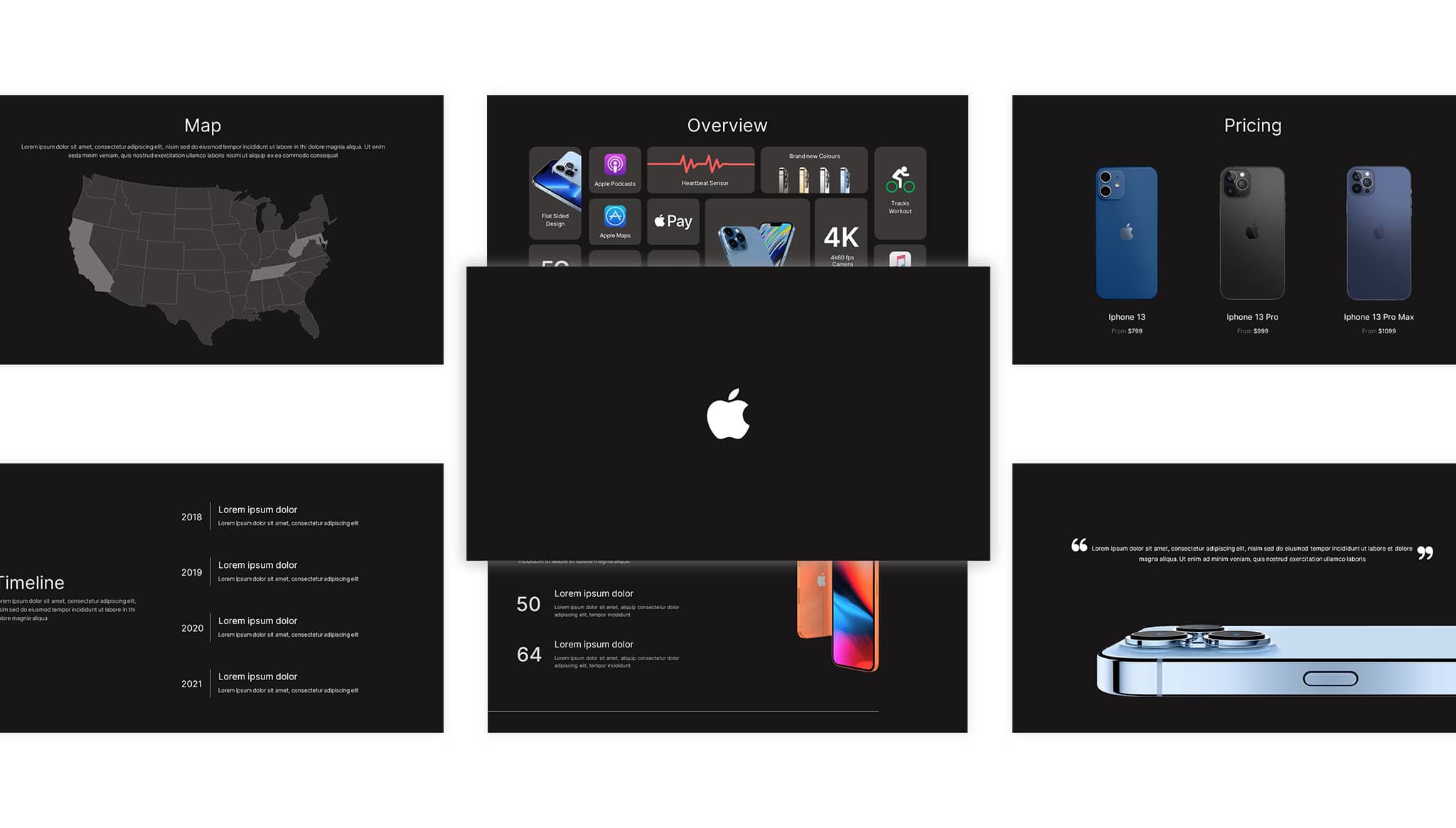
About the Template
Apple inc presentation slides.
Good presentation skills are important in the workplace. They can make or break a deal, provide information for an audience, or strengthen your argument. Finding the right PowerPoint template is crucial to presenting well and ensuring you give off the best impression. Download this amazing free Apple template and create a lasting impression on your audience.
Unlock the world of creativity with these captivating “Apple Elegance” themes – a tribute to the innovative spirit of Apple Inc. This free Apple presentation template is a perfect blend of sleek design and intuitive functionality, embodying the essence of Apple’s iconic style.
About the Template:
- Sleek Design: Immerse your audience in a realm of refined aesthetics that mirror Apple’s hallmark elegance and simplicity, elevating your content to new heights.
- Vibrant Color Palette: This template color scheme draws inspiration from Apple’s timeless shades, radiating modernity and professionalism throughout your presentation.
- Data Visualization: Transform complex data into easily digestible insights with these interactive charts and graphs, designed to resonate with Apple’s focus on user-friendly design.
- Versatile Slides: From title slides to content layouts, each slide exudes a sense of sophistication that mirrors Apple’s attention to detail, allowing your narrative to shine.
Whether you’re a tech aficionado, a creative professional, or an educator aiming to inspire, the “Apple Elegance” template empowers you to craft presentations that mirror Apple’s captivating ethos. From boardroom presentations to educational seminars, this template is your gateway to showcasing your ideas in a way that’s as cutting-edge as the Apple brand itself.
This free Google Slides Apple template for PowerPoint presentation – a perfect design for your next business meeting, conference, or training session. This Apple version of the PowerPoint template has a sleek and professional theme with the right amount of detail to make it stand out from other templates on the web. The Apple logo and iPhone 13 mockups give the deck a professional appeal. Finding the right PowerPoint template is crucial to presenting well and ensuring you give off the best impression. Stand out from the corporates in the meeting room and present an outstanding presentation using these Free Google Slides Apple template for PowerPoint presentations. Find out the more interesting business deck template here at our Business Pitch Deck library.
If you want to design a winning action plan for your team, try using this Free Google Slides Roadmap to Success template .
Google Slide,PowerPoint
100% Fully Customizable
Free to use
Decision Making
Financial Management
Free Active Template Library
Free Apple Templates
Free Company Profile Templates
Project Management
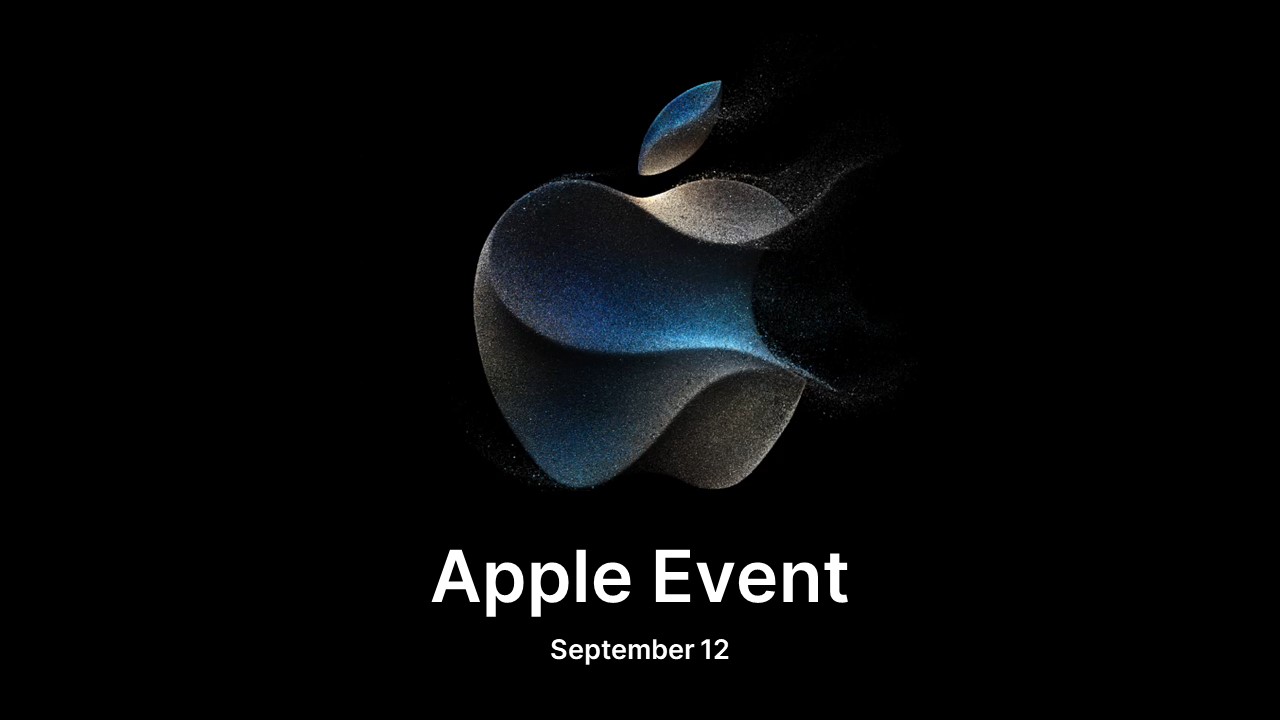
Free Apple Event 2023 Template PowerPoint & Google Slides
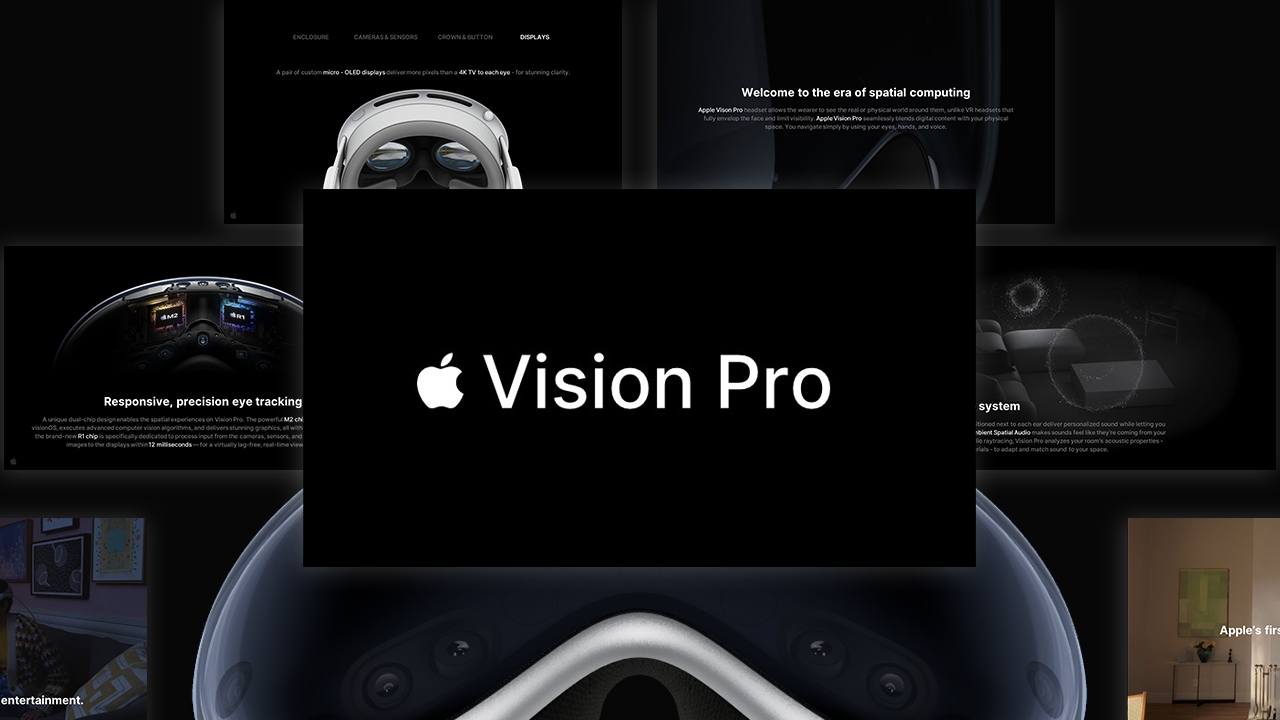
Free Apple Vision Pro Template PowerPoint & Google Slides
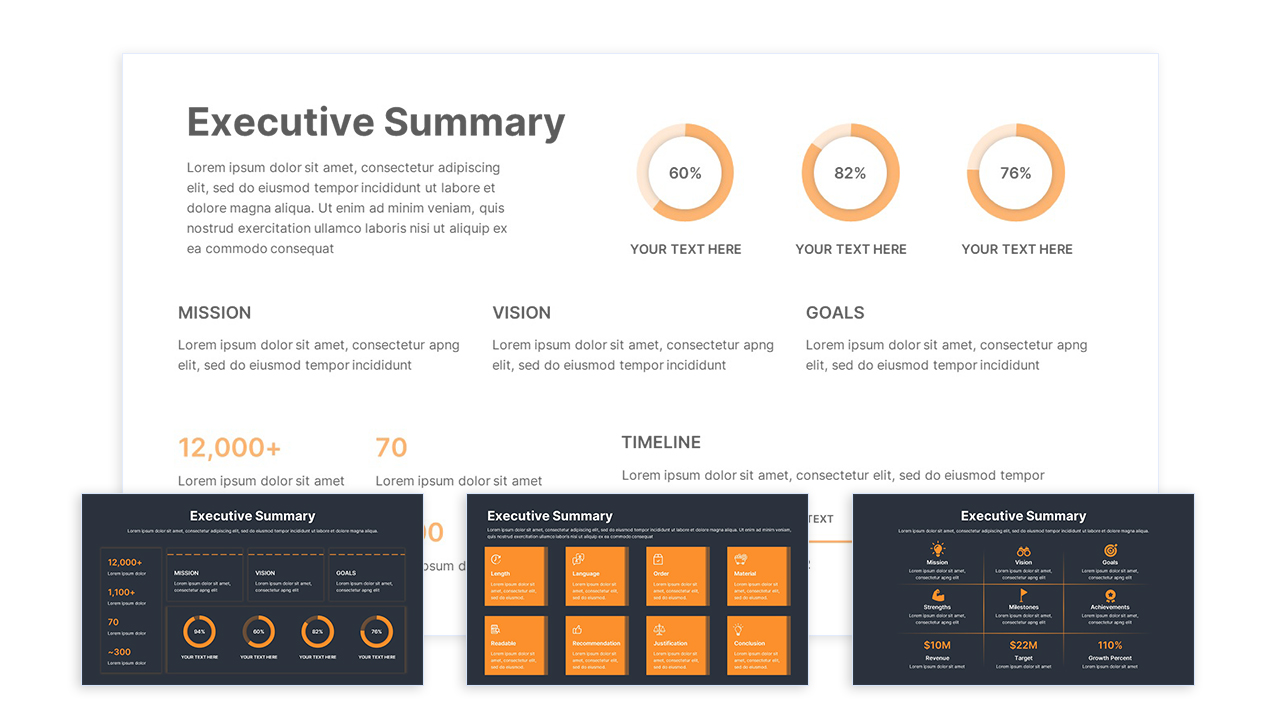
Free Executive Summary Template PowerPoint & Google Slides
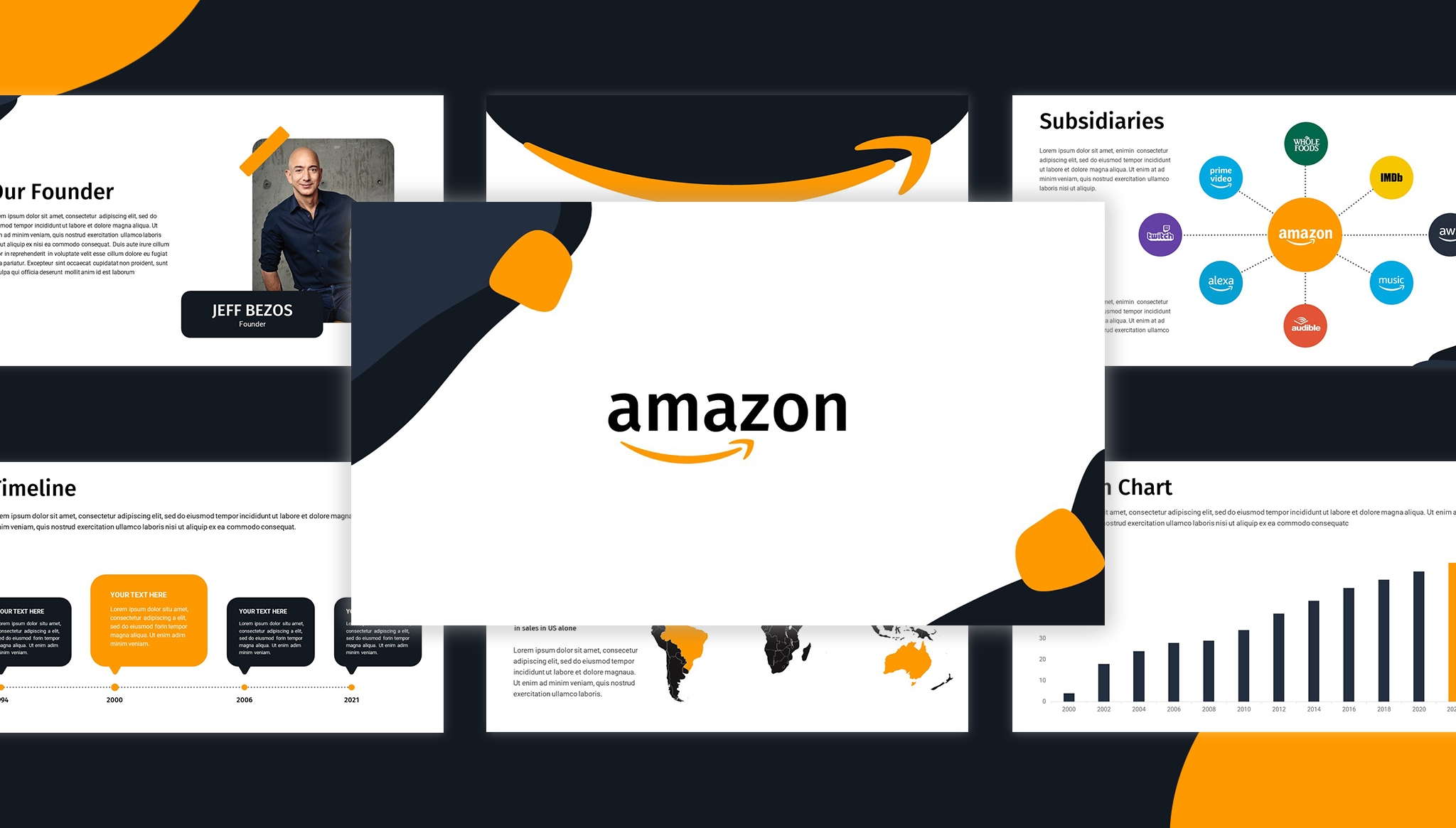
Free Google Slides Amazon PowerPoint Template
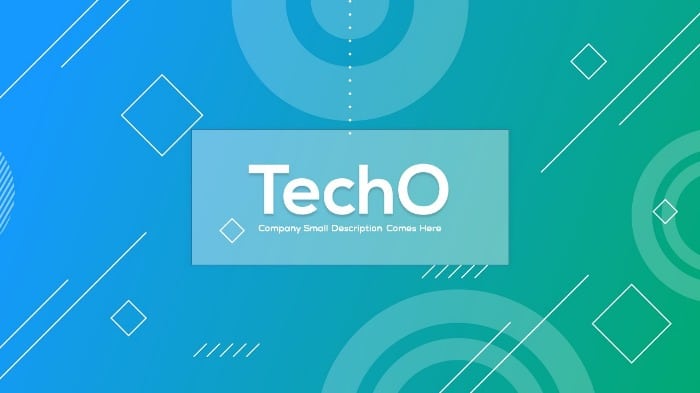
TechO Free PowerPoint Presentation Templates and Google Slides
Are you looking for custom presentation template designs.
It is a long established fact that a reader will be distracted by the readable content of a page when or randomised words which don’t look even slightly believable

- Apple Marketing Strategy
- Popular Categories
Powerpoint Templates
Icon Bundle
Kpi Dashboard
Professional
Business Plans
Swot Analysis
Gantt Chart
Business Proposal
Marketing Plan
Project Management
Business Case
Business Model
Cyber Security
Business PPT
Digital Marketing
Digital Transformation
Human Resources
Product Management
Artificial Intelligence
Company Profile
Acknowledgement PPT
PPT Presentation
Reports Brochures
One Page Pitch
Interview PPT
All Categories
Powerpoint Templates and Google slides for Apple Marketing Strategy
Save your time and attract your audience with our fully editable ppt templates and slides..
Item 1 to 60 of 83 total items
- You're currently reading page 1

Deliver this complete deck to your team members and other collaborators. Encompassed with stylized slides presenting various concepts, this Brand Story How Apple Has Emerged As Innovative Market Leader Branding CD is the best tool you can utilize. Personalize its content and graphics to make it unique and thought-provoking. All the seventy three slides are editable and modifiable, so feel free to adjust them to your business setting. The font, color, and other components also come in an editable format making this PPT design the best choice for your next presentation. So, download now.
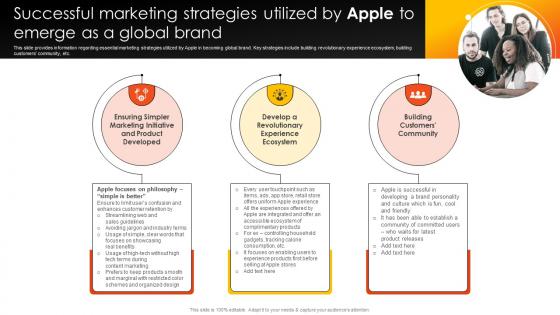
This slide provides information regarding essential marketing strategies utilized by Apple in becoming global brand. Key strategies include building revolutionary experience ecosystem, building customers community, etc. Introducing How Apple Competent Successful Marketing Strategies Utilized By Apple To Branding SS V to increase your presentation threshold. Encompassed with Two stages, this template is a great option to educate and entice your audience. Dispence information on Product Developed, Experience Ecosystem using this template. Grab it now to reap its full benefits.
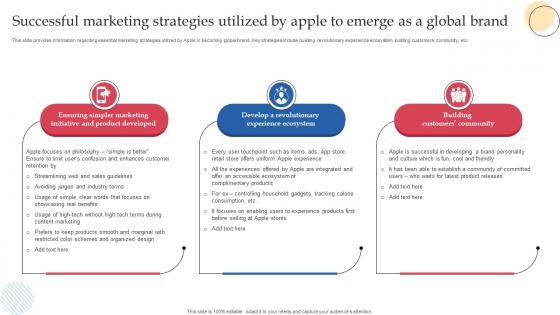
This slide provides information regarding essential marketing strategies utilized by Apple in becoming global brand. Key strategies include building revolutionary experience ecosystem, building customers community, etc. Increase audience engagement and knowledge by dispensing information using Successful Marketing Strategies Utilized By Apple To Emerge How Apple Connects With Potential Audience. This template helps you present information on Three stages. You can also present information on Ensuring Simpler Marketing, Experience Ecosystem, Building Customers Community using this PPT design. This layout is completely editable so personaize it now to meet your audiences expectations.
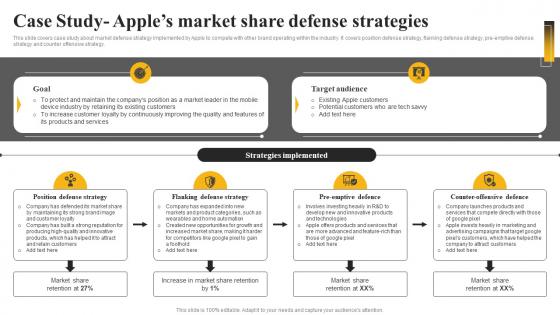
This slide covers case study about market defense strategy implemented by Apple to compete with other brand operating within the industry. It covers position defense strategy, flanking defense strategy, pre emptive defense strategy and counter offensive strategy. Introducing Case Study Apples Market Share Defense Strategies Market Leadership Mastery Strategy SS to increase your presentation threshold. Encompassed with four stages, this template is a great option to educate and entice your audience. Dispence information on Position Defense Strategy, Flanking Defense Strategy, Counter Offensive Defence, using this template. Grab it now to reap its full benefits.
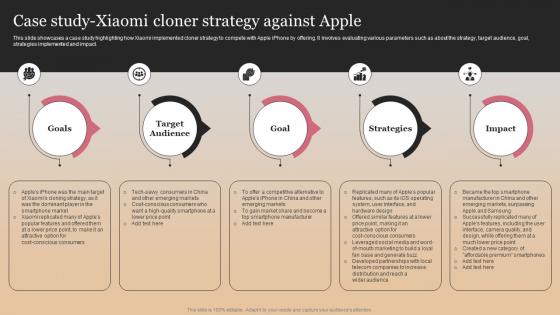
This slide showcases a case study highlighting how Xiaomi implemented cloner strategy to compete with Apple iPhone by offering. It involves evaluating various parameters such as about the strategy, target audience, goal, strategies implemented and impact. Increase audience engagement and knowledge by dispensing information using Case Study Xiaomi Cloner Strategy Against Apple Market Follower Strategies Strategy SS. This template helps you present information on five stages. You can also present information on Goals, Target Audience, Strategies, Strategy Against Apple using this PPT design. This layout is completely editable so personaize it now to meet your audiences expectations.
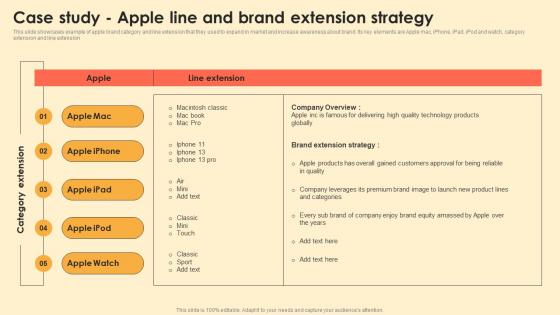
This slide showcases example of apple brand category and line extension that they used to expand in market and increase awareness about brand. Its key elements are Apple mac, iPhone, iPad, iPod and watch, category extension and line extension. Deliver an outstanding presentation on the topic using this Case Study Apple Line And Brand Extension Strategy Digital Brand Marketing MKT SS V. Dispense information and present a thorough explanation of Line Extension, Company Overview, Brand Extension Strategy using the slides given. This template can be altered and personalized to fit your needs. It is also available for immediate download. So grab it now.
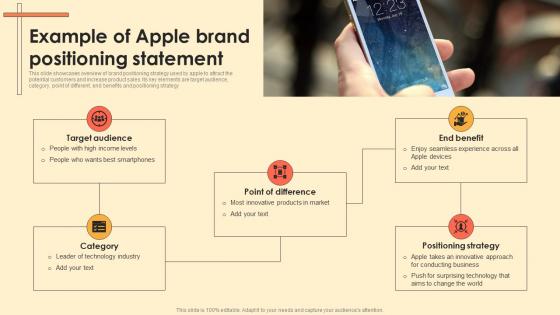
This slide showcases overview of brand positioning strategy used by apple to attract the potential customers and increase product sales. Its key elements are target audience, category, point of different, end benefits and positioning strategy. Introducing Example Of Apple Brand Positioning Statement Digital Brand Marketing MKT SS V to increase your presentation threshold. Encompassed with five stages, this template is a great option to educate and entice your audience. Dispence information on Target Audience, Point Of Difference, Positioning Strategy, using this template. Grab it now to reap its full benefits.
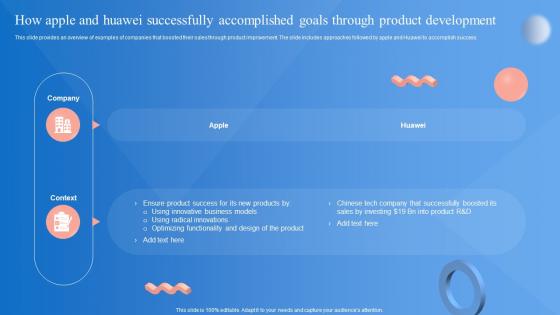
This slide provides an overview of examples of companies that boosted their sales through product improvement. The slide includes approaches followed by apple and Huawei to accomplish success. Present the topic in a bit more detail with this Market Penetration Strategy How Apple And Huawei Successfully Accomplished Goals Strategy SS V. Use it as a tool for discussion and navigation on Company, Ensure Product, Business Models. This template is free to edit as deemed fit for your organization. Therefore download it now.
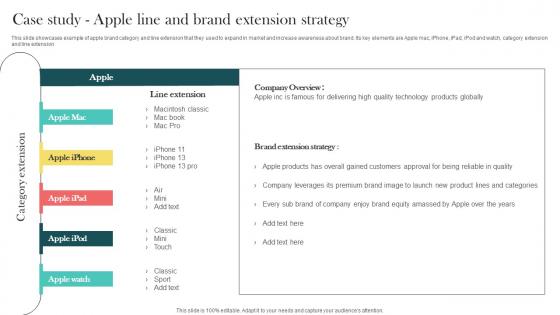
This slide showcases example of apple brand category and line extension that they used to expand in market and increase awareness about brand. Its key elements are Apple mac, iPhone, iPad, iPod and watch, category extension and line extension. Present the topic in a bit more detail with this Product Marketing And Positioning Strategy Case Study Apple Line And Brand Extension Strategy MKT SS V. Use it as a tool for discussion and navigation on Apple Brand Category, Line Extension, Category Extension And Line Extension, Gained Customers Approval. This template is free to edit as deemed fit for your organization. Therefore download it now.
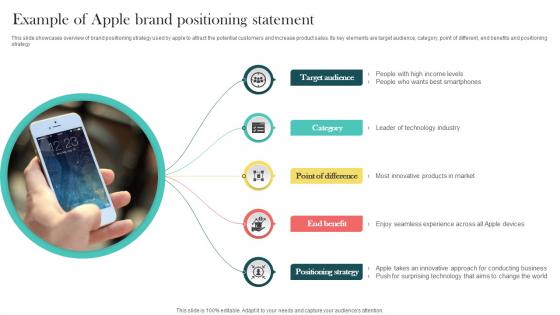
This slide showcases overview of brand positioning strategy used by apple to attract the potential customers and increase product sales. Its key elements are target audience, category, point of different, end benefits and positioning strategy. Introducing Product Marketing And Positioning Strategy Example Of Apple Brand Positioning Statement MKT SS V to increase your presentation threshold. Encompassed with five stages, this template is a great option to educate and entice your audience. Dispence information on Positioning Strategy, Target Audience, Brand Positioning Strategy, Surprising Technology That Aims, using this template. Grab it now to reap its full benefits.
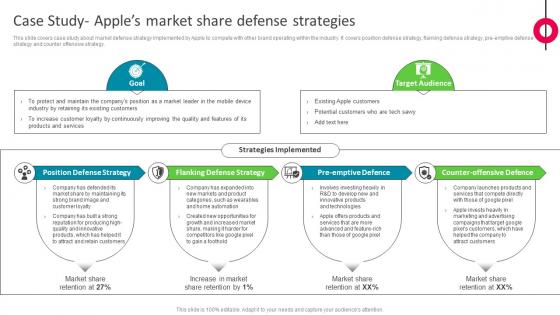
This slide covers case study about market defense strategy implemented by Apple to compete with other brand operating within the industry. It covers position defense strategy, flanking defense strategy, pre-emptive defense strategy and counter offensive strategy. Introducing Case Study Apples Market Share Defense Strategies The Ultimate Market Leader Strategy SS to increase your presentation threshold. Encompassed with Four stages, this template is a great option to educate and entice your audience. Dispence information on Position Defense Strategy, Flanking Defense Strategy, Counter Offensive Defence, using this template. Grab it now to reap its full benefits.
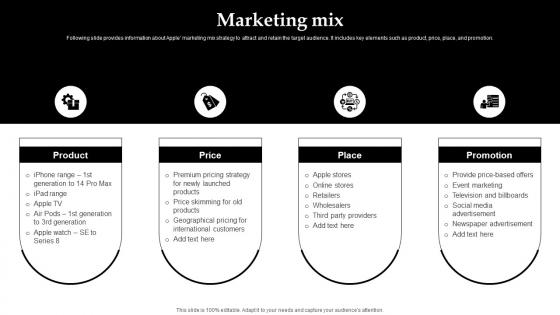
Following slide provides information about Apple marketing mix strategy to attract and retain the target audience. It includes key elements such as product, price, place, and promotion. Introducing Marketing Mix Apple Company Profile Ppt Download CP SS to increase your presentation threshold. Encompassed with four stages, this template is a great option to educate and entice your audience. Dispence information on Product, Price, Place, Promotion , using this template. Grab it now to reap its full benefits.
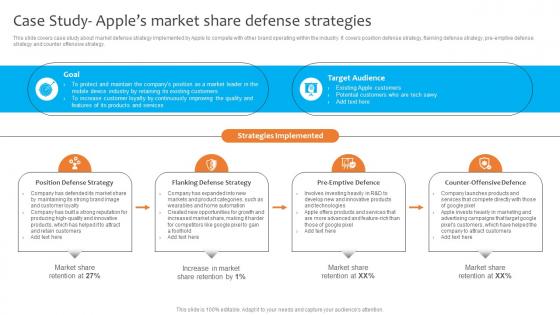
This slide covers case study about market defense strategy implemented by Apple to compete with other brand operating within the industry. It covers position defense strategy, flanking defense strategy, pre-emptive defense strategy and counter offensive strategy. Introducing Case Study Apples Market Share Defense Strategies Dominating The Competition Strategy SS V to increase your presentation threshold. Encompassed with four stages, this template is a great option to educate and entice your audience. Dispence information on Position Defense Strategy, Flanking Defense Strategy, Target Audience, using this template. Grab it now to reap its full benefits.
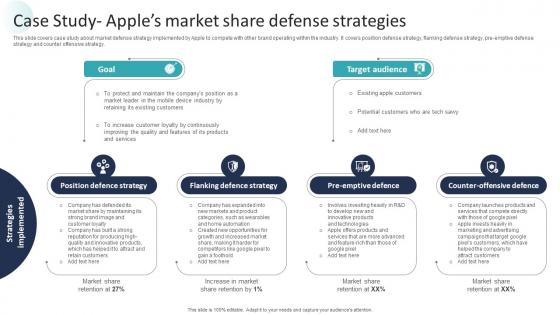
This slide covers case study about market defense strategy implemented by Apple to compete with other brand operating within the industry. It covers position defense strategy, flanking defense strategy, pre-emptive defense strategy and counter offensive strategy. Introducing Corporate Dominance The Market Case Study Apples Market Share Defense Strategy SS V to increase your presentation threshold. Encompassed with four stages, this template is a great option to educate and entice your audience. Dispence information on Position Defence Strategy, Flanking Defence Strategy, Target Audience, Counter Offensive Defence, using this template. Grab it now to reap its full benefits.
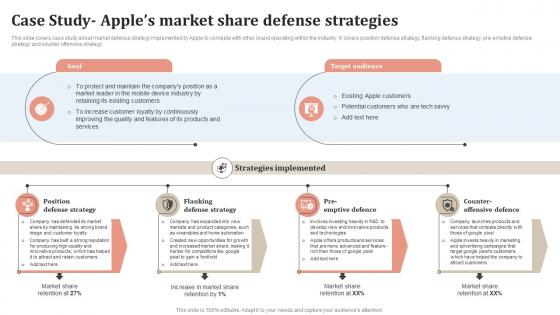
This slide covers case study about market defense strategy implemented by Apple to compete with other brand operating within the industry. It covers position defense strategy, flanking defense strategy, pre emptive defense strategy and counter offensive strategy. Introducing Case Study Apples Market Staying Ahead Of The Curve A Comprehensive Strategy SS V to increase your presentation threshold. Encompassed with four stages, this template is a great option to educate and entice your audience. Dispence information on Strategy, Flanking, Offensive, using this template. Grab it now to reap its full benefits.
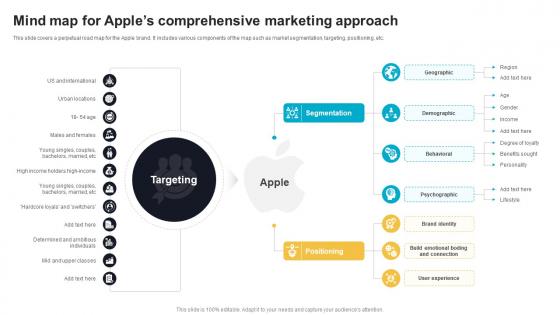
This slide covers a perpetual road map for the Apple brand. It includes various components of the map such as market segmentation, targeting, positioning, etc. Deliver an outstanding presentation on the topic using this Mind Map For Apples Comprehensive Marketing Approach Effective Product Brand Positioning Strategy Dispense information and present a thorough explanation of Us And International, Urban Locations, Males And Females using the slides given. This template can be altered and personalized to fit your needs. It is also available for immediate download. So grab it now.
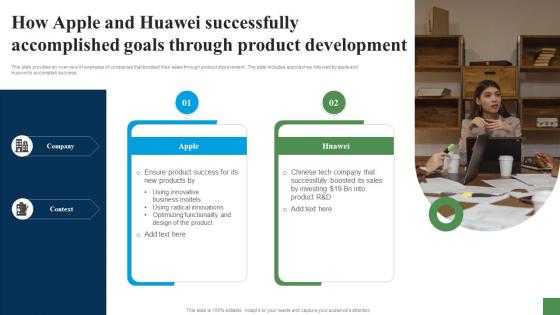
This slide provides an overview of examples of companies that boosted their sales through product improvement. The slide includes approaches followed by apple and Huawei to accomplish success. Introducing How Apple And Huawei Successfully Accomplished Expanding Customer Base Through Market Strategy SS V to increase your presentation threshold. Encompassed with two stages, this template is a great option to educate and entice your audience. Dispence information on Innovative, Business Models, Context, Company, using this template. Grab it now to reap its full benefits.
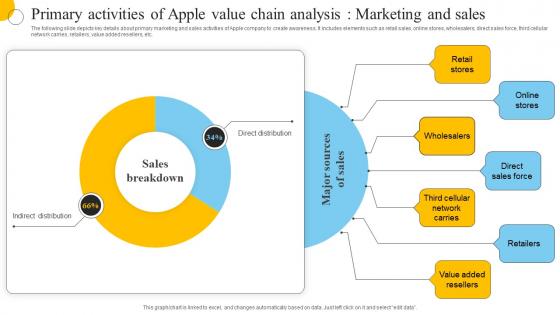
The following slide depicts key details about primary marketing and sales activities of Apple company to create awareness. It includes elements such as retail sales, online stores, wholesalers, direct sales force, third cellular network carries, retailers, value added resellers, etc. Introducing our Primary Activities Of Apple Value Chain Analysis Marketing And Sales set of slides. The topics discussed in these slides are Retail Stores, Online Stores, Wholesalers. This is an immediately available PowerPoint presentation that can be conveniently customized. Download it and convince your audience.
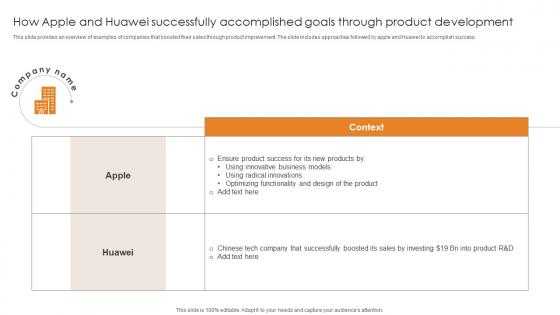
This slide provides an overview of examples of companies that boosted their sales through product improvement. The slide includes approaches followed by apple and Huawei to accomplish success. Present the topic in a bit more detail with this Market Penetration For Business How Apple And Huawei Successfully Accomplished Goals Strategy SS V. Use it as a tool for discussion and navigation on Apple And Huawei Successfully, Accomplished Goals. This template is free to edit as deemed fit for your organization. Therefore download it now.

This slide provides an overview of examples of companies that boosted their sales through product improvement. The slide includes approaches followed by apple and Huawei to accomplish success. Introducing How Apple And Huawei Successfully Accomplished Goals Through Implementation Of Market Strategy SS V to increase your presentation threshold. Encompassed with Two stages, this template is a great option to educate and entice your audience. Dispence information on Free Shipping, Brand Perception using this template. Grab it now to reap its full benefits.
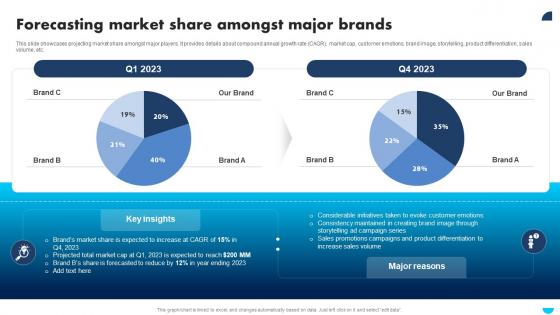
This slide showcases projecting market share amongst major players. It provides details about compound annual growth rate CAGR, market cap, customer emotions, brand image, storytelling, product differentiation, sales volume, etc. Deliver an outstanding presentation on the topic using this Apple Emotional Branding Forecasting Market Share Amongst Major Brands. Dispense information and present a thorough explanation of Brands Market, Projected, Sales Promotions using the slides given. This template can be altered and personalized to fit your needs. It is also available for immediate download. So grab it now.
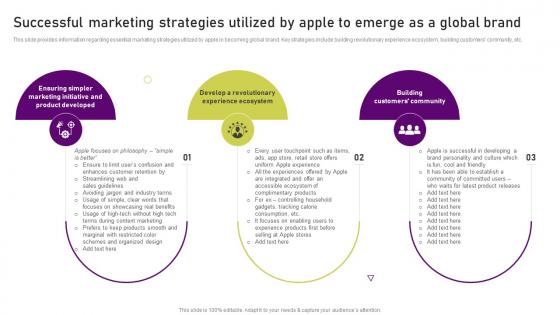
This slide provides information regarding essential marketing strategies utilized by apple in becoming global brand. Key strategies include building revolutionary experience ecosystem, building customers community, etc. Introducing Successful Marketing Strategies Utilized By Apple To Emerge As A Global Unearthing Apples Billion Dollar to increase your presentation threshold. Encompassed with three stages, this template is a great option to educate and entice your audience. Dispence information on Product Developed, Ecosystem, Customers Community, using this template. Grab it now to reap its full benefits.
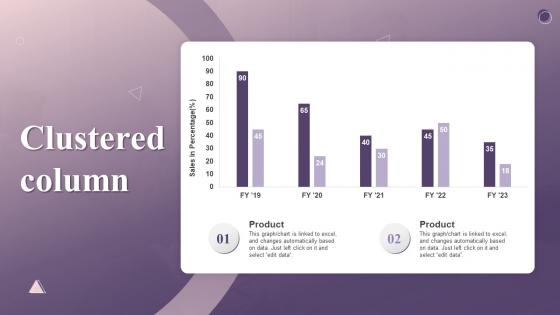
Present the topic in a bit more detail with this Clustered Column How Apple Has Emerged As Innovative Market Leader.Use it as a tool for discussion and navigation on Clustered Column.This template is free to edit as deemed fit for your organization.Therefore download it now.
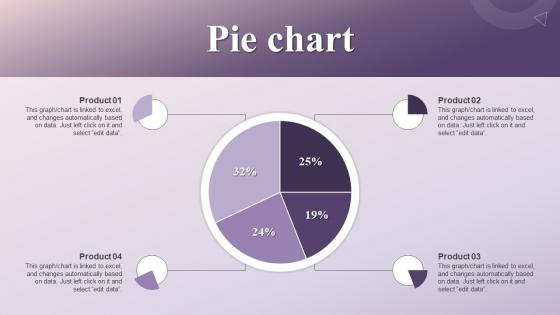
Present the topic in a bit more detail with this Pie Chart How Apple Has Emerged As Innovative Market Leader.Use it as a tool for discussion and navigation on Pie Chart.This template is free to edit as deemed fit for your organization.Therefore download it now.
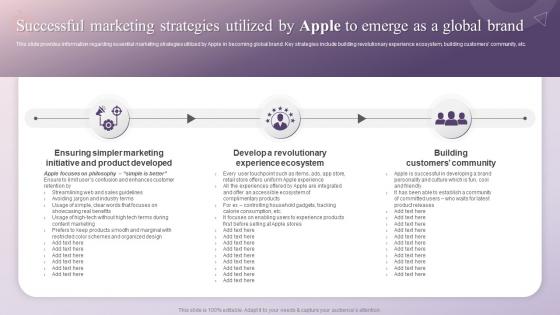
This slide provides information regarding essential marketing strategies utilized by Apple in becoming global brand.Key strategies include building revolutionary experience ecosystem, building customers community, etc.Introducing Successful Marketing Strategies Utilized By Apple To How Apple Has Emerged As Innovative to increase your presentation threshold.Encompassed with three stages, this template is a great option to educate and entice your audience.Dispence information on Ensuring Simpler, Develop Revolutionary, Experience Ecosystem, using this template.Grab it now to reap its full benefits.
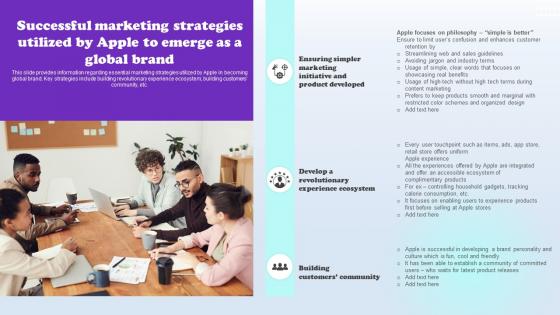
This slide provides information regarding essential marketing strategies utilized by Apple in becoming global brand. Key strategies include building revolutionary experience ecosystem, building customers community, etc. Increase audience engagement and knowledge by dispensing information using Successful Marketing Strategies Utilized By Apples Aspirational Storytelling Branding SS. This template helps you present information on three stages. You can also present information on Product Developed, Experience Ecosystem, Customers Community using this PPT design. This layout is completely editable so personaize it now to meet your audiences expectations.
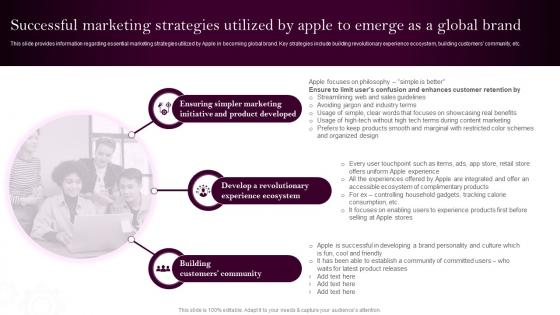
This slide provides information regarding essential marketing strategies utilized by Apple in becoming global brand. Key strategies include building revolutionary experience ecosystem, building customers community, etc. Increase audience engagement and knowledge by dispensing information using Apples Branding Strategy Successful Marketing Strategies Utilized By Apple To Emerge As A Global. This template helps you present information on three stages. You can also present information on Product Developed, Revolutionary Experience Ecosystem, Building Customers Community using this PPT design. This layout is completely editable so personaize it now to meet your audiences expectations.
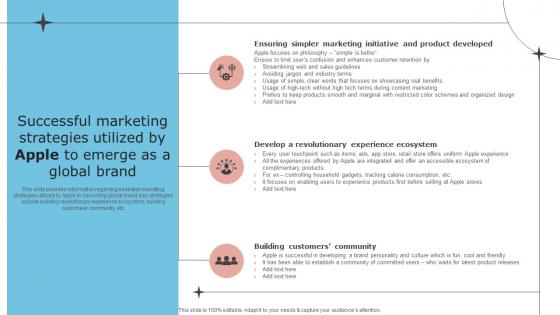
This slide provides information regarding essential marketing strategies utilized by Apple in becoming global brand. Key strategies include building revolutionary experience ecosystem, building customers community, etc. Introducing Unfolding Apples Secret To Success Successful Marketing Strategies Utilized By Apple to increase your presentation threshold. Encompassed with three stages, this template is a great option to educate and entice your audience. Dispence information on Product Developed, Marketing, Ecosystem, using this template. Grab it now to reap its full benefits.
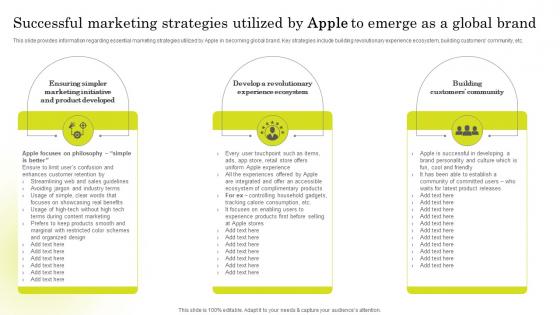
This slide provides information regarding essential marketing strategies utilized by Apple in becoming global brand. Key strategies include building revolutionary experience ecosystem, building customers community, etc. Introducing Successful Marketing Strategies Utilized Brand Strategy Of Apple To Emerge Branding SS V to increase your presentation threshold. Encompassed with three stages, this template is a great option to educate and entice your audience. Dispence information on Product Developed, Marketing Initiative, Experience Ecosystem, using this template. Grab it now to reap its full benefits.
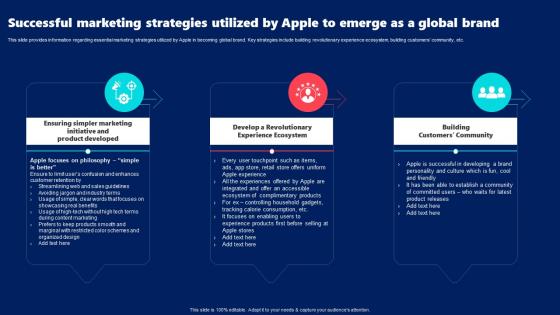
This slide provides information regarding essential marketing strategies utilized by Apple in becoming global brand. Key strategies include building revolutionary experience ecosystem, building customers community, etc. Increase audience engagement and knowledge by dispensing information using Successful Marketing Strategies Utilized By Apple To Emerge Global Brand Branding SS V This template helps you present information on Onestages. You can also present information on Product Developed, Experience Ecosystem using this PPT design. This layout is completely editable so personaize it now to meet your audiences expectations.
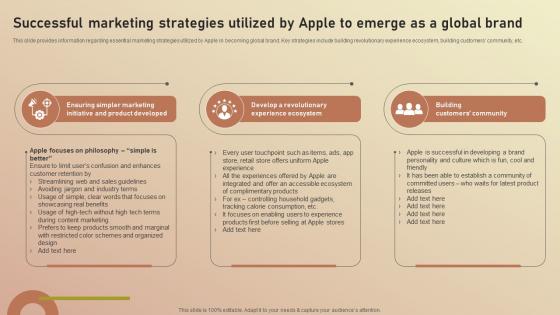
This slide provides information regarding essential marketing strategies utilized by Apple in becoming global brand. Key strategies include building revolutionary experience ecosystem, building customers community, etc. Increase audience engagement and knowledge by dispensing information using Successful Marketing Strategies Utilized By Apple To Emerge Apple Branding Brand Story Branding SS V This template helps you present information on Three stages. You can also present information on Overview, Brand architecture, Brand archetype using this PPT design. This layout is completely editable so personaize it now to meet your audiences expectations.
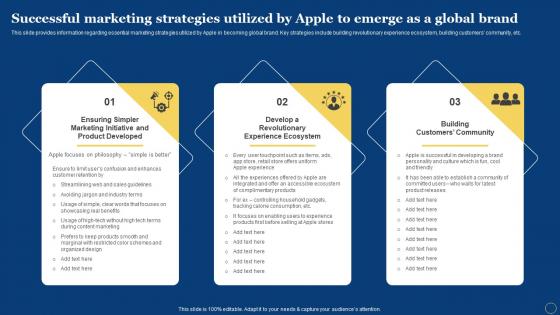
This slide provides information regarding essential marketing strategies utilized by Apple in becoming global brand. Key strategies include building revolutionary experience ecosystem, building customers community, etc.Introducing Successful Marketing Strategies Utilized How Apple Has Become Branding SS V to increase your presentation threshold. Encompassed with three stages, this template is a great option to educate and entice your audience. Dispence information on Marketing Initiative, Ensuring Simpler, Experience Ecosystem, using this template. Grab it now to reap its full benefits.
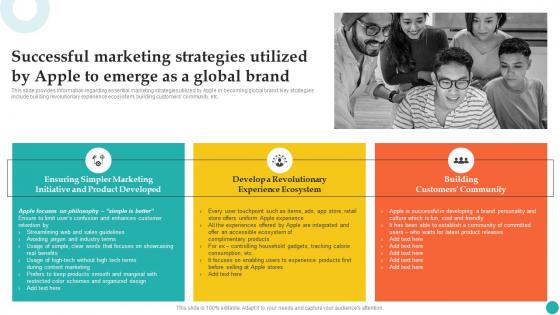
This slide provides information regarding essential marketing strategies utilized by Apple in becoming global brand. Key strategies include building revolutionary experience ecosystem, building customers community, etc. Introducing Successful Marketing Strategies Utilized By How Apple Became Competent Branding SS V to increase your presentation threshold. Encompassed with Three stages, this template is a great option to educate and entice your audience. Dispence information on App Tracking Transparency, Data Collection And Organization using this template. Grab it now to reap its full benefits.
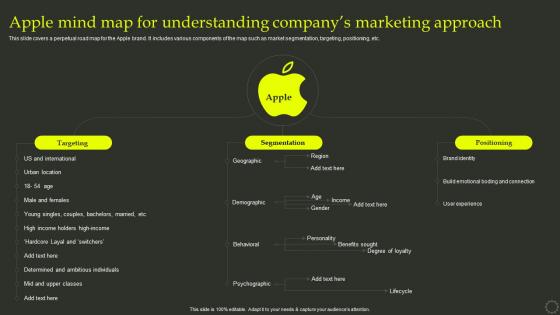
This slide covers a perpetual road map for the Apple brand. It includes various components of the map such as market segmentation, targeting, positioning, etc. Present the topic in a bit more detail with this Apple Mind Map For Understanding Companys Marketing Approach Effective Positioning Strategy Product. Use it as a tool for discussion and navigation on Marketing, Approach, Understanding. This template is free to edit as deemed fit for your organization. Therefore download it now.
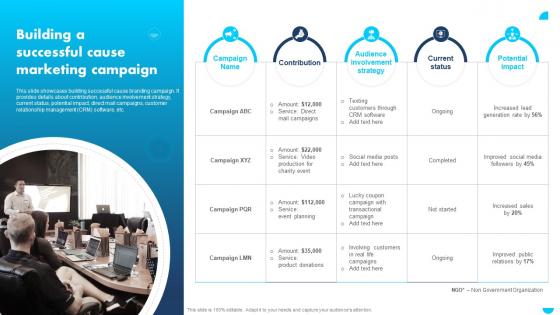
This slide showcases building successful cause branding campaign. It provides details about contribution, audience involvement strategy, current status, potential impact, direct mail campaigns, customer relationship management CRM software, etc. Introducing Apple Emotional Branding Building A Successful Cause Marketing Campaign to increase your presentation threshold. Encompassed with one stages, this template is a great option to educate and entice your audience. Dispence information on Contribution, Audience Involvement Strategy, Current Status, using this template. Grab it now to reap its full benefits.
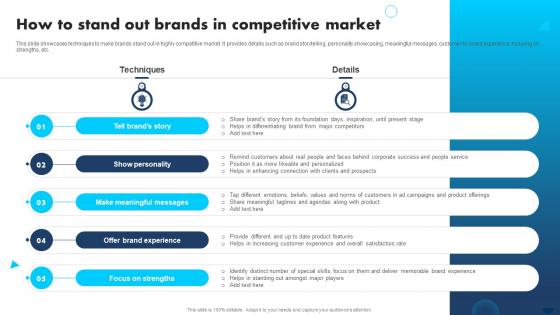
This slide showcases techniques to make brands stand out in highly competitive market. It provides details such as brand storytelling, personality showcasing, meaningful messages, customer to brand experience, focusing on strengths, etc. Introducing Apple Emotional Branding How To Stand Out Brands In Competitive Market to increase your presentation threshold. Encompassed with five stages, this template is a great option to educate and entice your audience. Dispence information on Show Personality, Make Meaningful Messages, Offer Brand Experience, using this template. Grab it now to reap its full benefits.
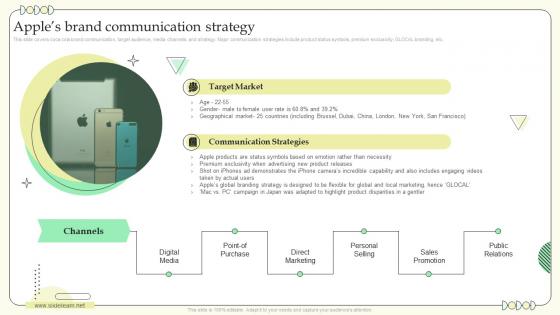
This slide covers coca cola brand communication, target audience, media channels, and strategy. Major communication strategies include product status symbols, premium exclusivity, GLOCAL branding, etc. Present the topic in a bit more detail with this Apples Brand Communication Strategy Building Communication Effective Brand Marketing. Use it as a tool for discussion and navigation on Communication, Strategy, Sales Promotion. This template is free to edit as deemed fit for your organization. Therefore download it now.
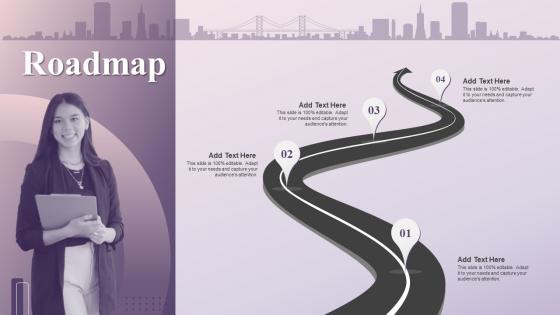
Increase audience engagement and knowledge by dispensing information using Roadmap How Apple Has Emerged As Innovative Market Leader.This template helps you present information on four stages.You can also present information on Roadmap using this PPT design.This layout is completely editable so personaize it now to meet your audiences expectations.
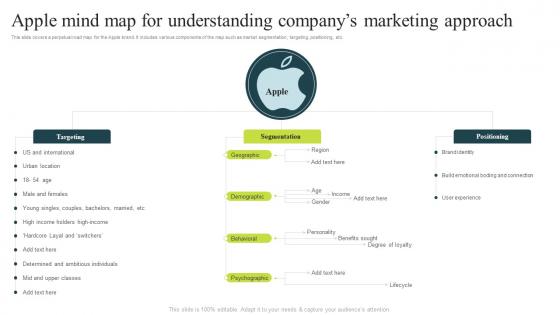
This slide covers a perpetual road map for the Apple brand. It includes various components of the map such as market segmentation, targeting, positioning, etc. Present the topic in a bit more detail with this Successful Product Positioning Guide Apple Mind Map For Understanding Companys Marketing Approach. Use it as a tool for discussion and navigation on Marketing, Approach, Segmentation . This template is free to edit as deemed fit for your organization. Therefore download it now.
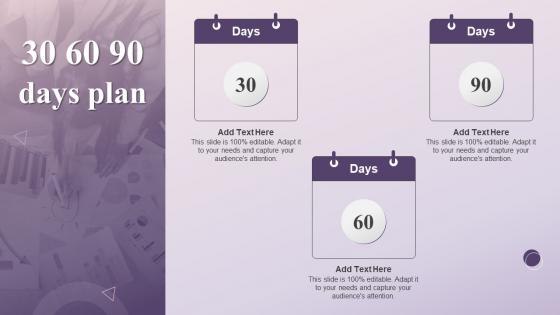
Introducing 30 60 90 Days Plan How Apple Has Emerged As Innovative Market Leader to increase your presentation threshold.Encompassed with three stages, this template is a great option to educate and entice your audience.Dispence information on 30 60 90, Days Plan, using this template.Grab it now to reap its full benefits.
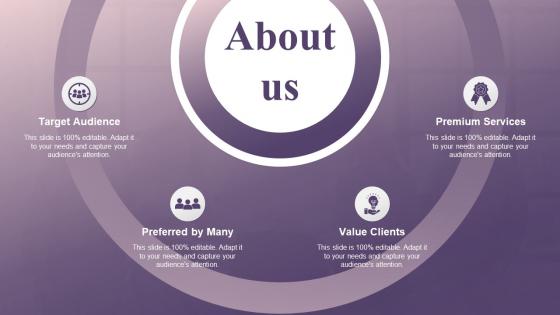
Increase audience engagement and knowledge by dispensing information using About Us How Apple Has Emerged As Innovative Market Leader.This template helps you present information on four stages.You can also present information on Target Audience, Preferred Many, Premium Services using this PPT design.This layout is completely editable so personaize it now to meet your audiences expectations.
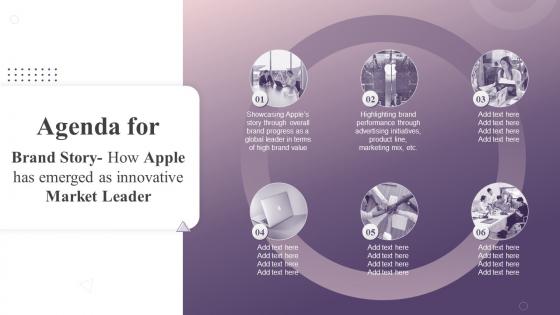
Increase audience engagement and knowledge by dispensing information using Agenda For Brand Story How Apple Has Emerged As Innovative Market Leader.This template helps you present information on six stages.You can also present information on Global Leader, Performance Through, Advertising Initiatives using this PPT design.This layout is completely editable so personaize it now to meet your audiences expectations.
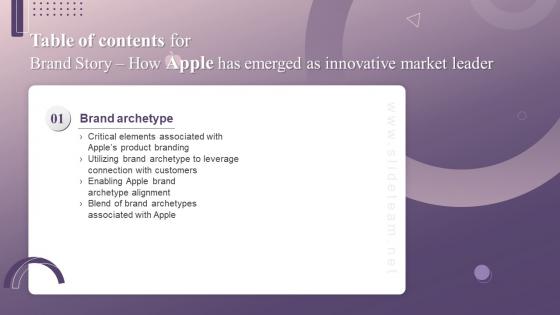
Present the topic in a bit more detail with this B145 Table Of Contents For Brand Story How Apple Has Emerged As Innovative Market Leader.Use it as a tool for discussion and navigation on Further Expansion, Loyal Customer, Advanced Technology.This template is free to edit as deemed fit for your organization.Therefore download it now.
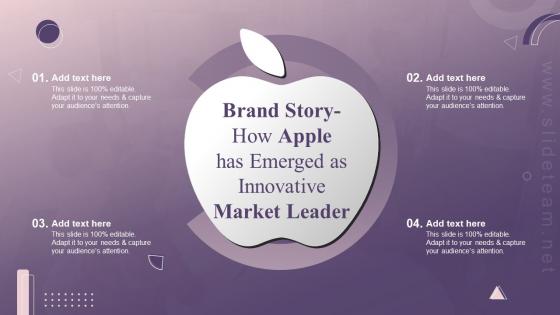
Deliver an outstanding presentation on the topic using this Brand Story How Apple Has Emerged As Innovative Market Leader.Dispense information and present a thorough explanation of Products Offered, Operating Systems, Creativity Software using the slides given.This template can be altered and personalized to fit your needs.It is also available for immediate download.So grab it now.
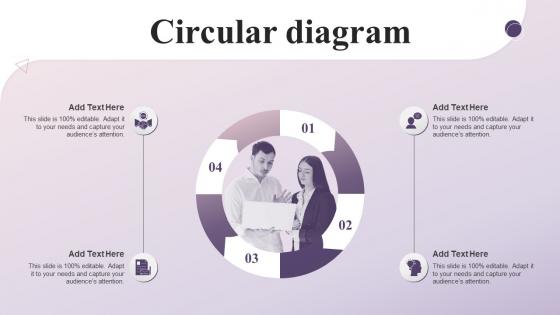
Increase audience engagement and knowledge by dispensing information using Circular Diagram How Apple Has Emerged As Innovative Market Leader.This template helps you present information on four stages.You can also present information on Circular Diagram using this PPT design.This layout is completely editable so personaize it now to meet your audiences expectations.
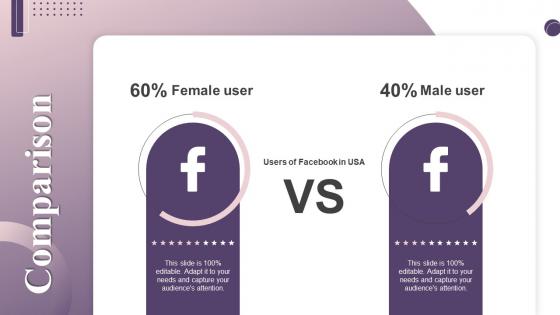
Introducing Comparison How Apple Has Emerged As Innovative Market Leader to increase your presentation threshold.Encompassed with two stages, this template is a great option to educate and entice your audience.Dispence information on Comparison, using this template.Grab it now to reap its full benefits.
Presenting our well crafted Icons Slides For Brand Story How Apple Has Emerged As Innovative Market Leader set of slides.The slides include icons that are innovatively designed by our team of experts.The icons are easy to edit so you can conveniently increase or decrease their size without any loss in resolution.Therefore, grab them instantly
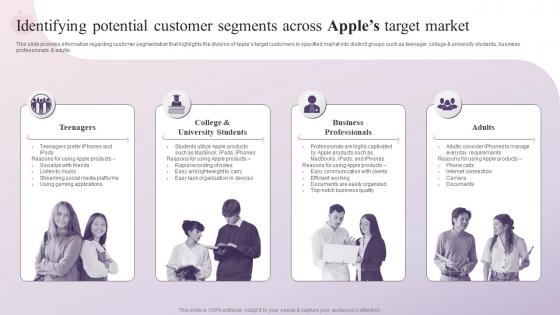
This slide provides information regarding customer segmentation that highlights the division of Apples target customers in specified market into distinct groups such as teenager, college and university students, business professionals, and adults.Introducing Identifying Potential Customer Segments Across Apples Target Market How Apple Has Emerged As Innovative to increase your presentation threshold.Encompassed with four stages, this template is a great option to educate and entice your audience.Dispence information on Gaming Applications, Teenagers Prefer, Documents Easily, using this template.Grab it now to reap its full benefits.
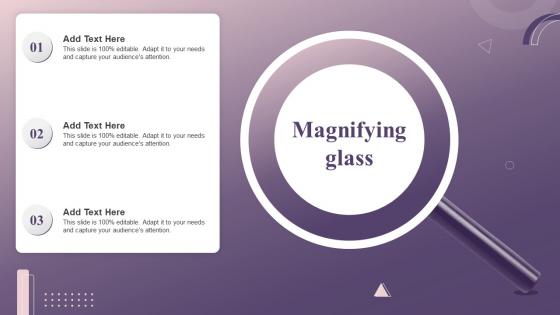
Introducing Magnifying Glass How Apple Has Emerged As Innovative Market Leader to increase your presentation threshold.Encompassed with three stages, this template is a great option to educate and entice your audience.Dispence information on Magnifying Glass, using this template.Grab it now to reap its full benefits.

Increase audience engagement and knowledge by dispensing information using Meet Our Team How Apple Has Emerged As Innovative Market Leader.This template helps you present information on three stages.You can also present information on Meet Our Team using this PPT design.This layout is completely editable so personaize it now to meet your audiences expectations.
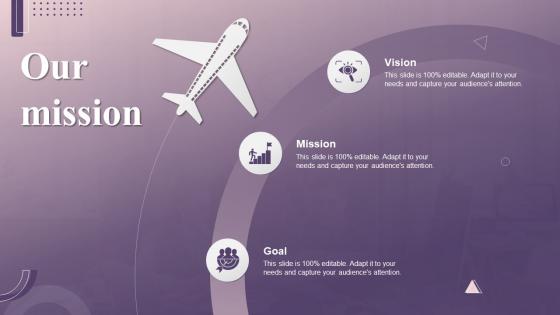
Increase audience engagement and knowledge by dispensing information using Our Mission How Apple Has Emerged As Innovative Market Leader.This template helps you present information on three stages.You can also present information on Mission, Vision, Goal using this PPT design.This layout is completely editable so personaize it now to meet your audiences expectations.
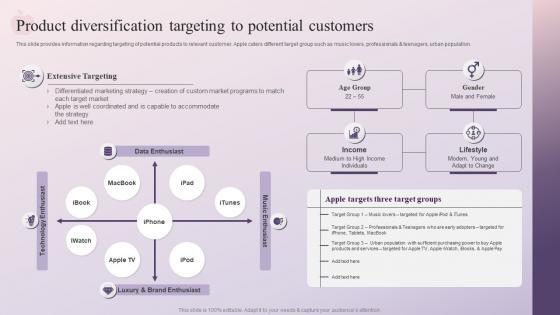
This slide provides information regarding targeting of potential products to relevant customer.Apple caters different target group such as music lovers, professionals and teenagers, urban population.Deliver an outstanding presentation on the topic using this Product Diversification Targeting To Potential Customers How Apple Has Emerged As Innovative Market Leader.Dispense information and present a thorough explanation of Differentiated Marketing, Technology Enthusiast, Income Individuals using the slides given.This template can be altered and personalized to fit your needs.It is also available for immediate download.So grab it now.
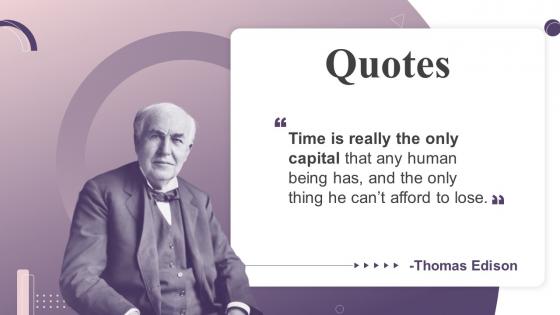
Present the topic in a bit more detail with this Quotes How Apple Has Emerged As Innovative Market Leader.Use it as a tool for discussion and navigation on Quotes.This template is free to edit as deemed fit for your organization.Therefore download it now.
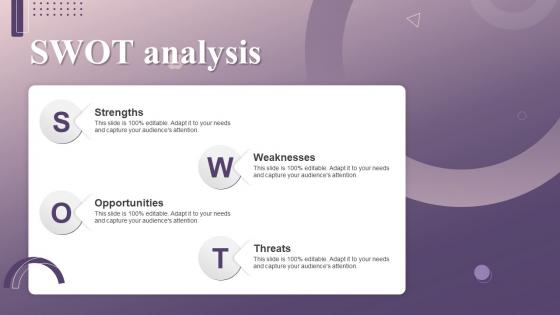
Increase audience engagement and knowledge by dispensing information using SWOT Analysis How Apple Has Emerged As Innovative Market Leader.This template helps you present information on four stages.You can also present information on Strengths, Weaknesses, Opportunities using this PPT design.This layout is completely editable so personaize it now to meet your audiences expectations.
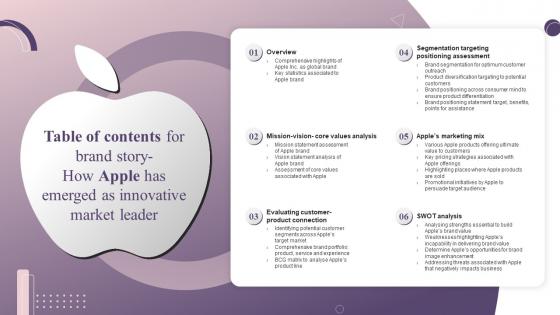
Present the topic in a bit more detail with this Table Of Contents For Brand Story How Apple Has Emerged As Innovative Market Leade.Use it as a tool for discussion and navigation on Segmentation Targeting, Positioning Assessment, Evaluating Customer.This template is free to edit as deemed fit for your organization.Therefore download it now.
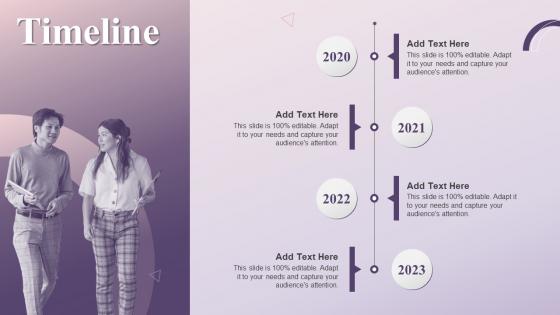
Increase audience engagement and knowledge by dispensing information using Timeline How Apple Has Emerged As Innovative Market Leader.This template helps you present information on four stages.You can also present information on Timeline using this PPT design.This layout is completely editable so personaize it now to meet your audiences expectations.
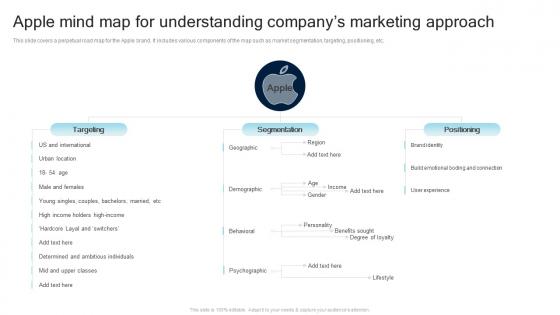
This slide covers a perpetual road map for the Apple brand. It includes various components of the map such as market segmentation, targeting, positioning, etc. Increase audience engagement and knowledge by dispensing information using Apple Mind Map For Understanding Companys Marketing Approach Steps For Creating A Successful. This template helps you present information on three stages. You can also present information on Targeting, Segmentation, Positioning using this PPT design. This layout is completely editable so personaize it now to meet your audiences expectations.
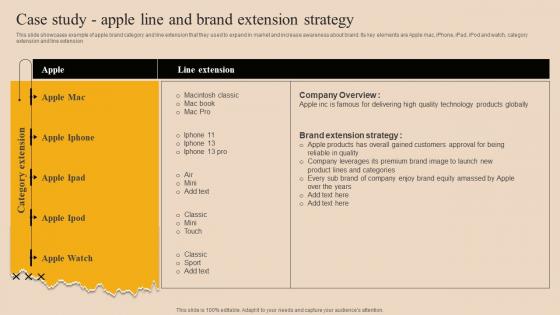
This slide showcases example of apple brand category and line extension that they used to expand in market and increase awareness about brand. Its key elements are Apple mac, iPhone, iPad, iPod and watch, category extension and line extension Present the topic in a bit more detail with this Case Study Apple Line And Brand Extension Market Branding Strategy For New Product Launch Mky SS. Use it as a tool for discussion and navigation on Brand Extension Strategy, Company Overview, Technology. This template is free to edit as deemed fit for your organization. Therefore download it now.
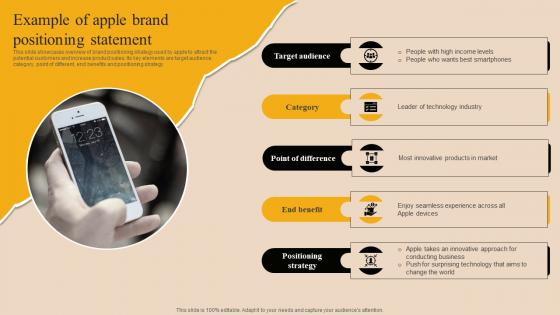
This slide showcases overview of brand positioning strategy used by apple to attract the potential customers and increase product sales. Its key elements are target audience, category, point of different, end benefits and positioning strategy Introducing Example Of Apple Brand Positioning Market Branding Strategy For New Product Launch Mky SS to increase your presentation threshold. Encompassed with five stages, this template is a great option to educate and entice your audience. Dispence information on Positioning, Statement, Target Audience, using this template. Grab it now to reap its full benefits.
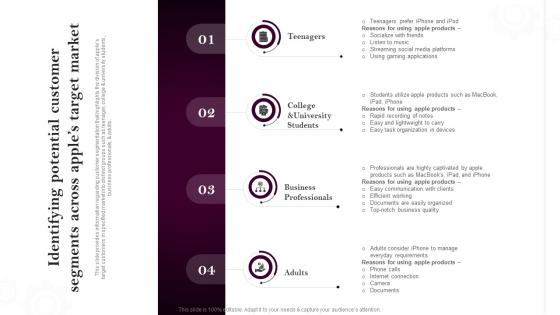
This slide provides information regarding customer segmentation that highlights the division of apples target customers in specified market into distinct groups such as teenager, college and university students, business professionals, and adults. Introducing Apples Branding Strategy Identifying Potential Customer Segments Across Apples Target Market to increase your presentation threshold. Encompassed with four stages, this template is a great option to educate and entice your audience. Dispence information on Business Professionals, Identifying Potential, Customer Segments, Target Market, using this template. Grab it now to reap its full benefits.

Business Essentials
One complete subscription that seamlessly brings together device management, 24/7 support, and cloud storage. With Apple Business Essentials, your small business can easily manage every iPhone, iPad, Mac, and Apple TV — every step of the way.
- Make IT easy.
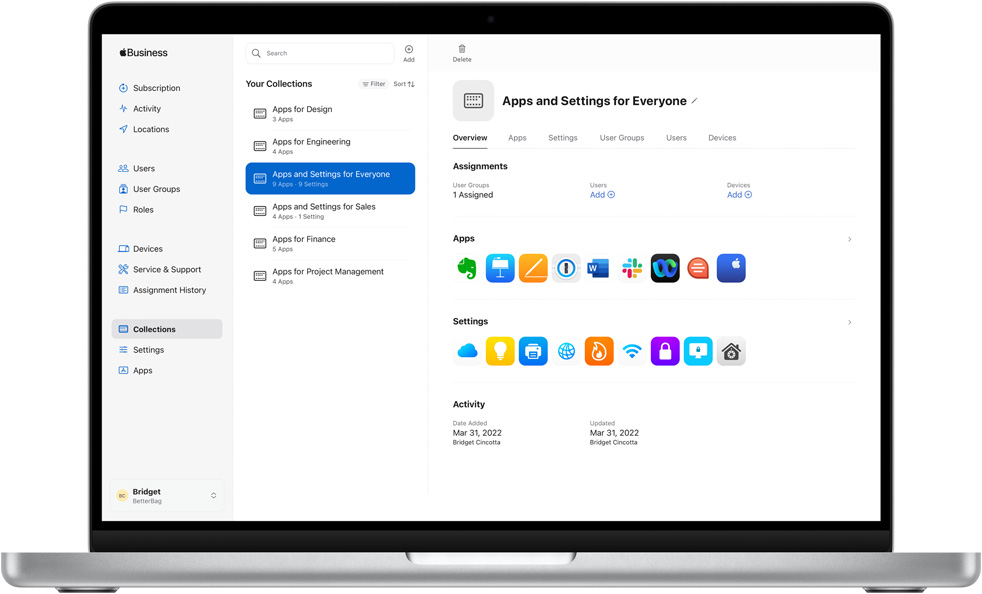
Add users. Not work.
Setup is faster and simpler with Collections. They allow you to automatically assign the right apps and settings to employees, teams, and their devices.
Collections save you time.
Whether you want to set up a device for a new employee, share an app with the whole marketing team, or change password settings for everyone, you can do it all in one go with Collections.
Smart User Groups make setup automatic.
Create a Smart User Group based on rules like location, role, or team. Then assign Collections to that group to set up their devices. And you can import users from Microsoft Azure Active Directory and Google Workspace to automatically add them to groups and deliver Collections.
New and existing devices are easy to configure.
Whether employees are in the same location as you or elsewhere, they just sign in to set up — straight out of the box. And employees can easily sign in to enroll and set up existing devices, too.
See everything in one place.
Stay on top of every device — from app licenses to storage to repair requests. Sort by location, team, or platform, and take action when needed.
is as easy as logging in.
Onboarding is as easy as logging in., managed apple ids let users sign in to set up..
Managed Apple IDs are separate from personal Apple IDs but work in similar ways. All employees have to do is sign in with their Managed Apple IDs to access work storage and support from AppleCare.
Apple Business Essentials syncs with Microsoft Azure Active Directory and Google Workspace.
Integrations with Microsoft Azure Active Directory and Google Workspace allow your employees to log in using a single user name and password across services.
Employees can set up their personal devices for work.
User Enrollment makes it easy for employees to enroll their personal devices — and get them set up for work. Personal data on their devices stays private, and everything stays secure.
Apps for employees help free up your time.
The Business Essentials app lets employees add the work apps they need on their devices. And the Support app lets them access support and make repair requests. That way employees don’t need to contact your IT department to stay productive.

Back up and move on.
Employees get a dedicated iCloud account for work — so storage, backup, and collaboration are simple and secure. And for iPhone and iPad, work backups are automatic.
Security for every device. Privacy for everybody.
Security for every device. privacy for everybody., protect every device with security settings..
You control security settings and features like password policies, FileVault, and Firewall so that users can’t change them by mistake.
Protect personal data with User Enrollment.
When employees enroll personal devices, cryptographic separation keeps their work and personal data separate so their privacy is protected.
Take action to secure lost or stolen devices.
With Lost Mode, you can locate or play a sound on a missing iPhone or iPad. And Remote Lock and Erase lets you lock or wipe any iPhone, iPad, or Mac.
Support is on call 24/7.
AppleCare+ for Business Essentials helps you and your employees resolve issues quickly. And AppleCare can even help you with issue tracking and reviewing your deployment strategy.
Repairs Not someday Not next week Not soon ASAP.
Repairs asap., flexible repairs.
Faster repairs mean less downtime. Plans with AppleCare+ for Business Essentials allow you or your employees to bring the device to any Apple Authorized Service Provider for same day repairs 1 .
- Same-day repairs are subject to parts and appointment availability.
Use repairs however you see fit.
Each plan with AppleCare+ for Business Essentials includes up to two repairs that refresh annually, but they’re not tied to any one device or user. You can apply them manually or automatically to any device associated with a plan with AppleCare+ for Business Essentials.
Easily assign users to new devices. And old devices to new users.
Update. Reassign. Relax. Repeat.
Update or replace devices without slowing down..
When it’s time for updates or replacements, employees just sign in to their new devices to access their apps, settings, and work data in iCloud.
Wipe and reassign existing devices remotely.
You can remotely erase existing devices so they’re ready when new users sign in with their Managed Apple IDs.
Relax — or take care of other tasks.
Apple Business Essentials works in the background to manage devices and data, freeing you up to handle other business demands.
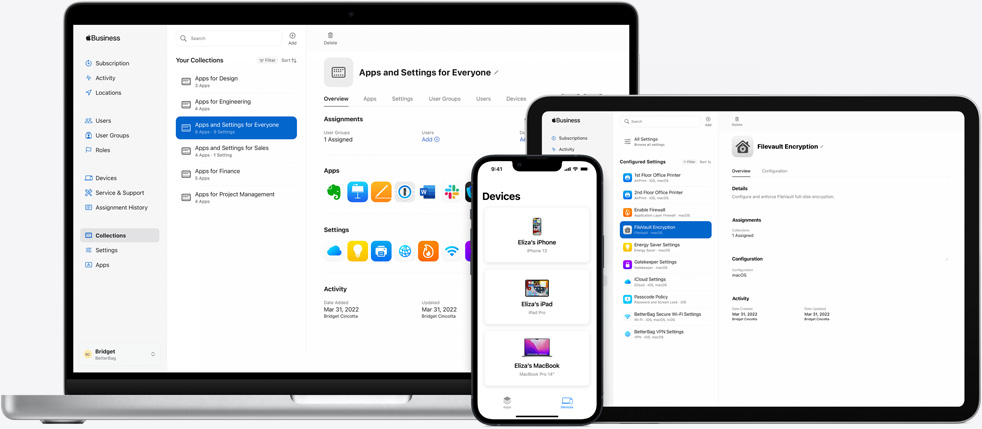
One subscription. Plenty of options.
You can mix and match plans to cover every employee and every device. * And make changes to your plans anytime.
$2.99 per device/mo.
Single-device plans are perfect for users with one device and include 50GB of storage. Device-only plans for kiosks, displays, and more do not include storage.
$9.99 per device/mo.
Plans include 50GB of storage, one repair credit per year per user or device, and 24/7 support.
$6.99 per user/mo.
Multidevice plans let you manage up to three devices for each user, with 200GB of storage.
$19.99 per user/mo.
Plans cover up to three devices per user and include 200GB of storage, two repair credits, and 24/7 support.
$12.99 per user/mo.
Give your power users a multidevice plan with up to three devices and 2TB of storage.
$24.99 per user/mo.
Plans cover up to three devices per user and include 2TB of storage, two repair credits, and 24/7 support.
Sorry, but your device or browser isn’t supported.
To log in or get started, switch to a supported browser such as Safari, Chrome, or Edge on a desktop, laptop, or tablet.
Try it now for free.
Now any small business in the U.S. can try Apple Business Essentials free for two months. Plans start at $2.99 per month after that.
See how it works.
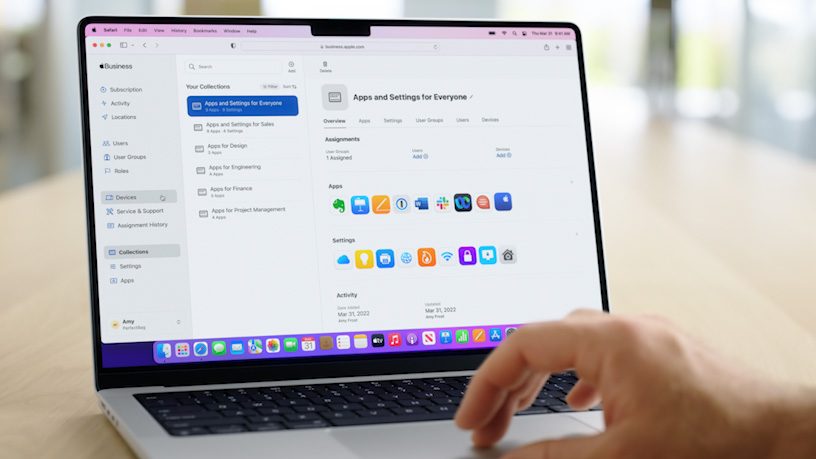
Home Blog Business How To Craft & Deliver an Effective Business Plan Presentation (Quick Guide)
How To Craft & Deliver an Effective Business Plan Presentation (Quick Guide)
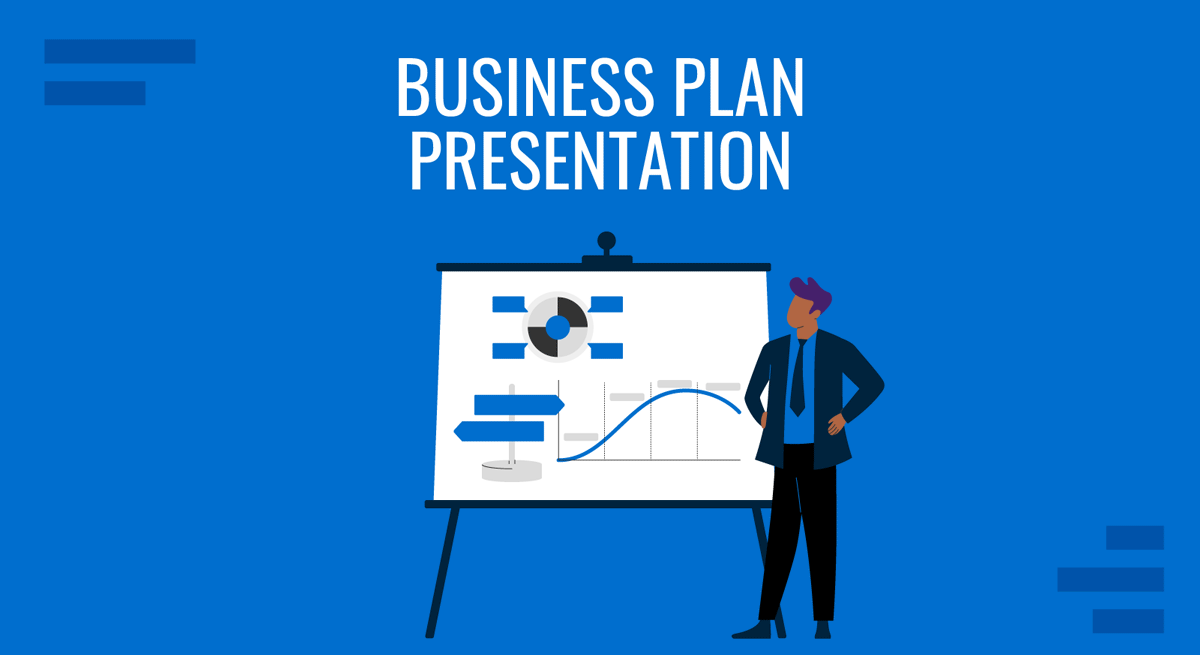
A vital element in today’s highly competitive business landscape is the ability to craft and deliver a business plan presentation. This applies to both entrepreneurs and corporate leaders.
This guide describes essential aspects required to build a business plan presentation and deliver it to stakeholders.
Table of Contents
What is a Business Plan Presentation?
Is a business plan presentation the same as a business presentation, executive summary, justification of the business proposal, swot analysis, the niche of the proposal & actors in the industry, competitors, competitive intensity, trend analysis and critical variables, value chain, market analysis, jobs-to-be-done, value proposition, revenue streams, cost structure, distribution channels, key partnerships for the business model, organizational structure & management, go to market and marketing plan, development plan, qa, and continuous improvement model, distribution plan, inventory management, initial funding and financing structure, projection of income and costs.
- Evaluation of Projected Return vs. Required
Risk Evaluation
Sensitivity to critical variables, how to present bibliographical information in a business plan presentation, how to deliver a business plan presentation.
A business plan presentation is the medium we use to communicate a business plan to an audience.
Presenters commonly ask what is the target length of a business plan presentation in terms of slides. Our expertise in this field tells us it’s advisable to work between 13-20 slides, remaining as concise as possible and using the help of visual aids. Let the graphics speak rather than fill your slides with text blocks.
No. A business plan presentation is used to communicate an identified business opportunity and how it is planned to be served in a way that generates profit. A business presentation is a more generic term, explained in our article about business presentation examples .
How to Create a Business Plan Presentation
This section will list our recommended content for a successful business plan presentation. We broke it down into four stages which help the presenter build the story backing the business: a-. The opportunity and the competitive landscape analyzed, b- the business model designed and tested to serve the opportunity, c- the implementation plan of the business model, and finally, d- the financial and economic projections estimated that show the profitability of the opportunity.
For the purpose of this guide, the slides will refer to a case study of photo editing software. To replicate this slide deck creation process, you can speed up design decisions by working with the SlideModel AI Presentation Maker and tailoring it to your project.
So, how to make a business plan presentation? Let’s see a step by step guide.
Stage 1 – Identifying the Opportunity
After the title slide that defines how to start a presentation , any business plan should proceed by introducing the executive summary in a concise but impactful format.
The purpose of the executive summary is to inform the audience what to expect from the presentation and its conclusion.
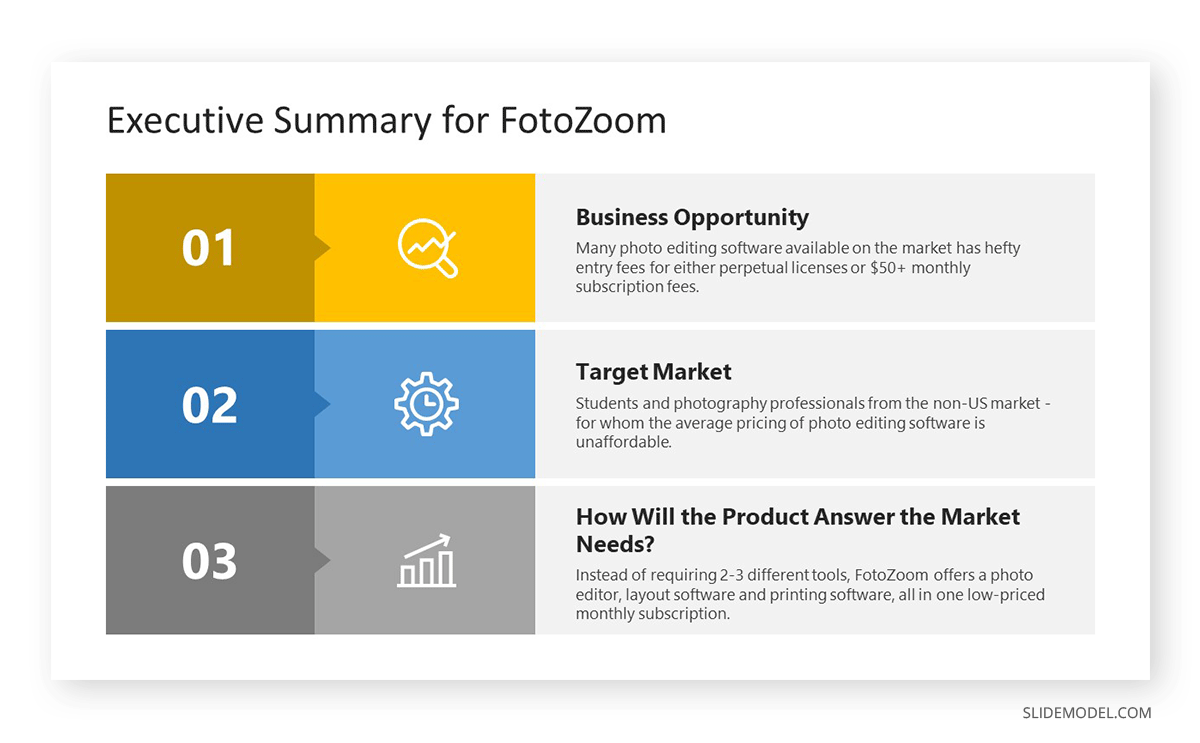
Work with a maximum of two slides for this section, highlighting the key elements through visual cues. Check our guide on how to present an executive summary .
The next slide should disclose all the reasoning behind the business plan proposal, why this plan is being presented at this present moment, and projections of how the plan aligns with the current market trends.
Presenters can share the analysis done by the Market research team as long as it’s made clear which problem is relevant to the current market trends that this business plan aims to solve.
Mention all the references used to arrive at the conclusions expressed so data is backed with meaningful sources.
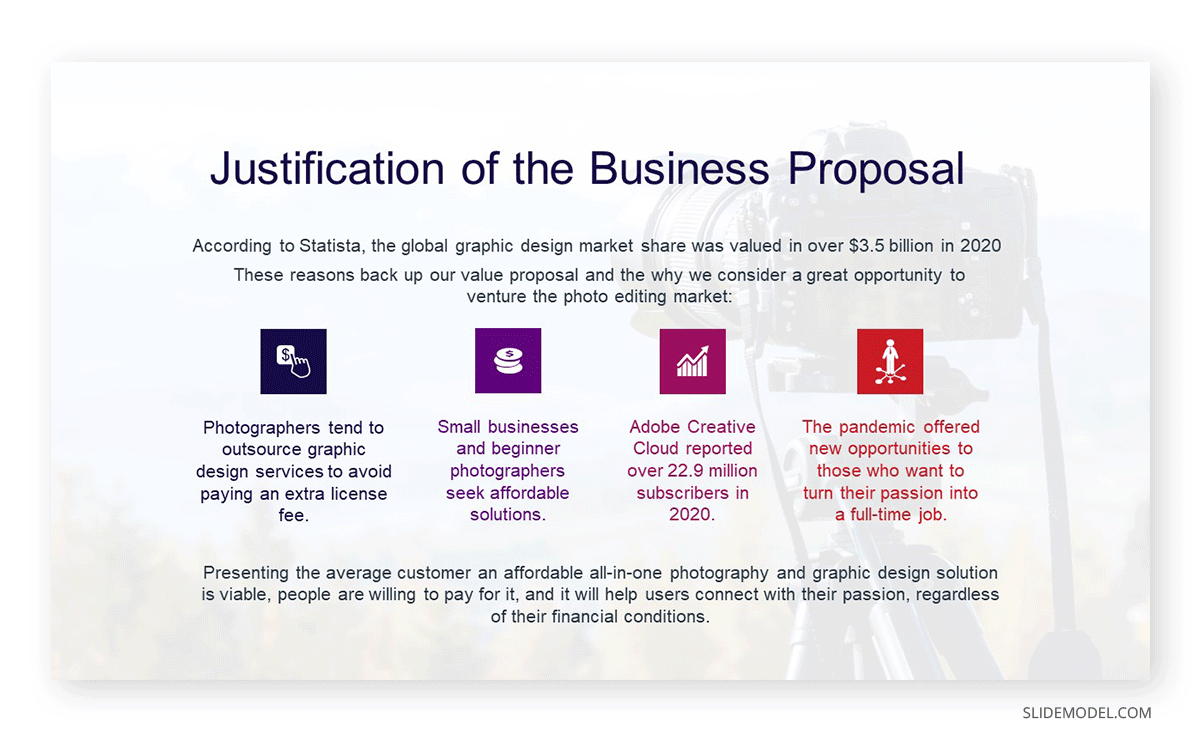
Any corporate PPT template can help you craft this slide, but presenters can also boost their performance through the use of infographics . If your solution for the selected problem involves a complex process, consider using a process flow template to expose the step-by-step justification of this proposal.
Use a SWOT template to showcase the Strengths, Weaknesses, Opportunities, and Threats of this business opportunity.
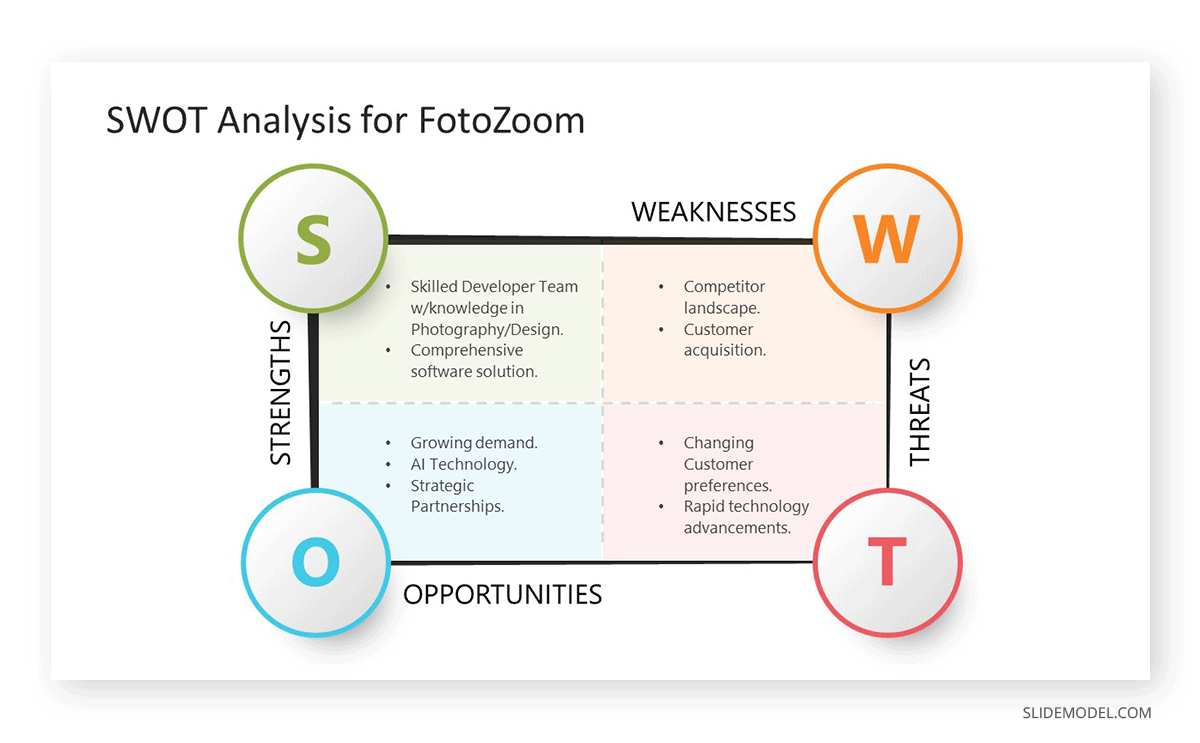
Make sure the SWOT diagram is legible. Work your way to meet the same aesthetic style despite speeding up the process with templates. Mention the tools used for gathering the information for this SWOT Analysis in the footnote and ensure the audience understands which information elements help you reach conclusions in each quadrant. Check our guide on how to create a SWOT analysis and see if your business plan requires a SWOT or SOAR analysis .
Every business plan is scoped under a niche or industry sector. With this slide, describe the sector in which the proposal is immersed. Communicate its value, list the actors involved, and describe their high-level relationships.
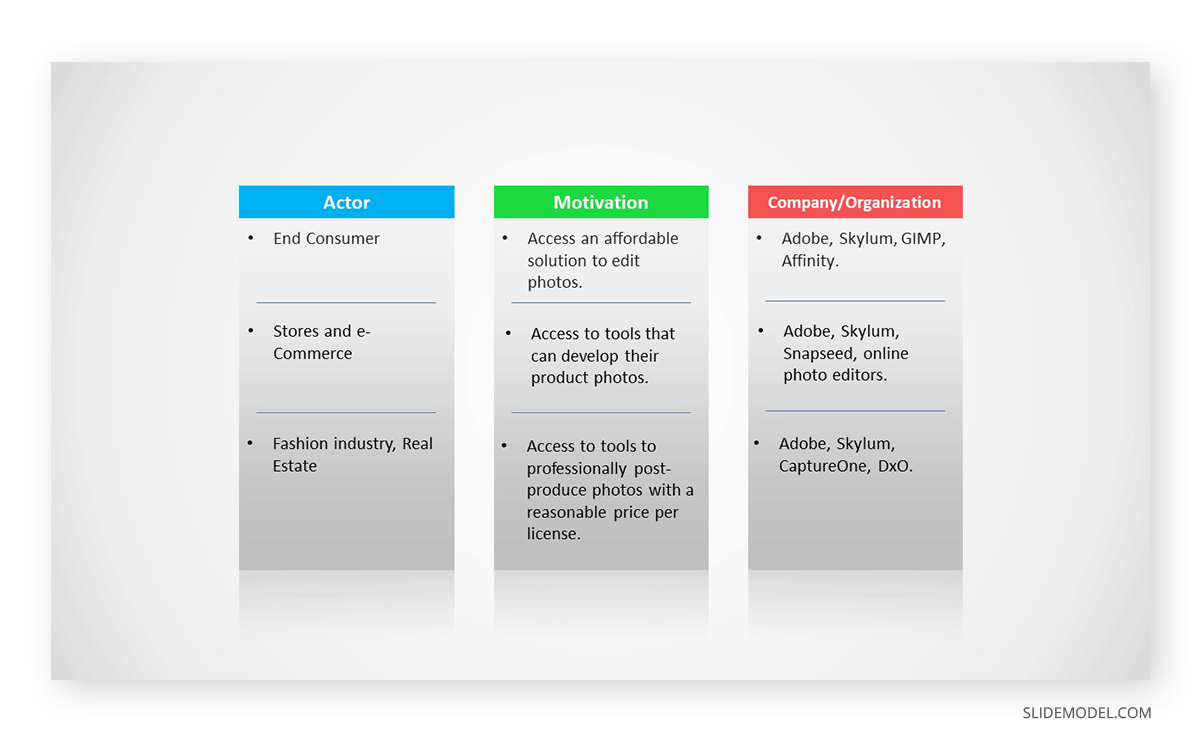
List the analyzed competitors. Communicate their attributes. The competitors’ comparison in business plan presentation can be visually explained using tools from the Blue Ocean Strategy framework, like the Strategy Canvas .
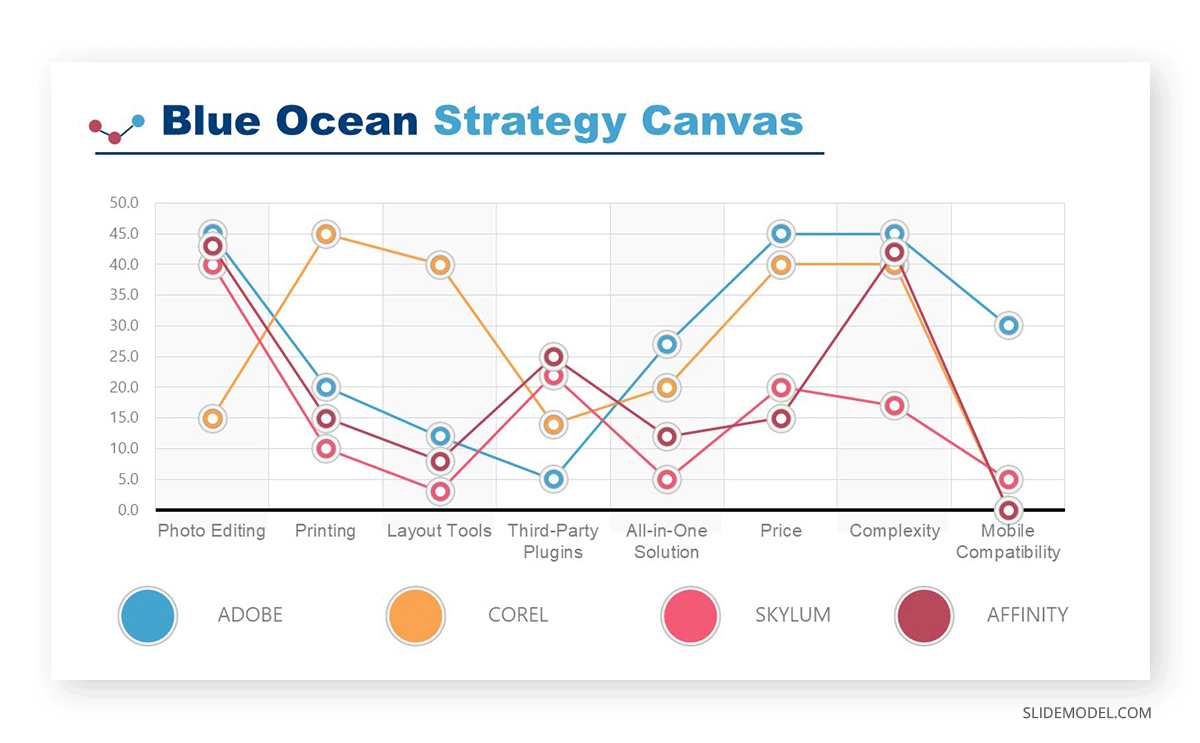
The competitive intensity of an industry sector is studied through the Porter’s 5 Forces model. This intensity expresses how attractive the industry is. Explain the conclusion in each force showcasing the model.
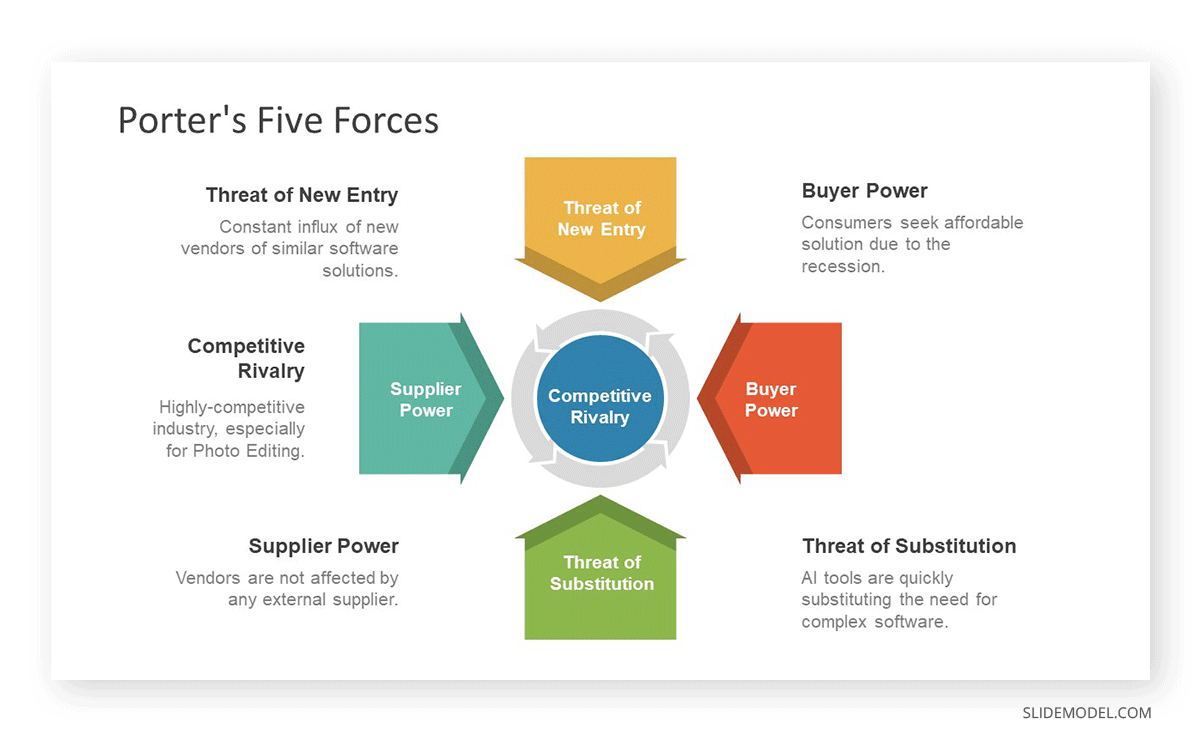
First, introduce the variables identified as important for the industry sector, citing the insight’s source. Secondly, drill down each variable and break down the different trend dimensions ( PESTEL )
- Use a highly visual slide, like a dashboard template , to introduce factual data regarding the trends over a specific time period. Growth rates must be represented in time frames of over 180 days to evaluate the trend accurately.
- List the critical variables (consumers, product, production capability, and financing) briefly.
- Disclose how each variable can affect pricing and your position within the niche for that trend. Presenters can refer to case studies from successful competitor stories on how they responded to trend changes in the niche.
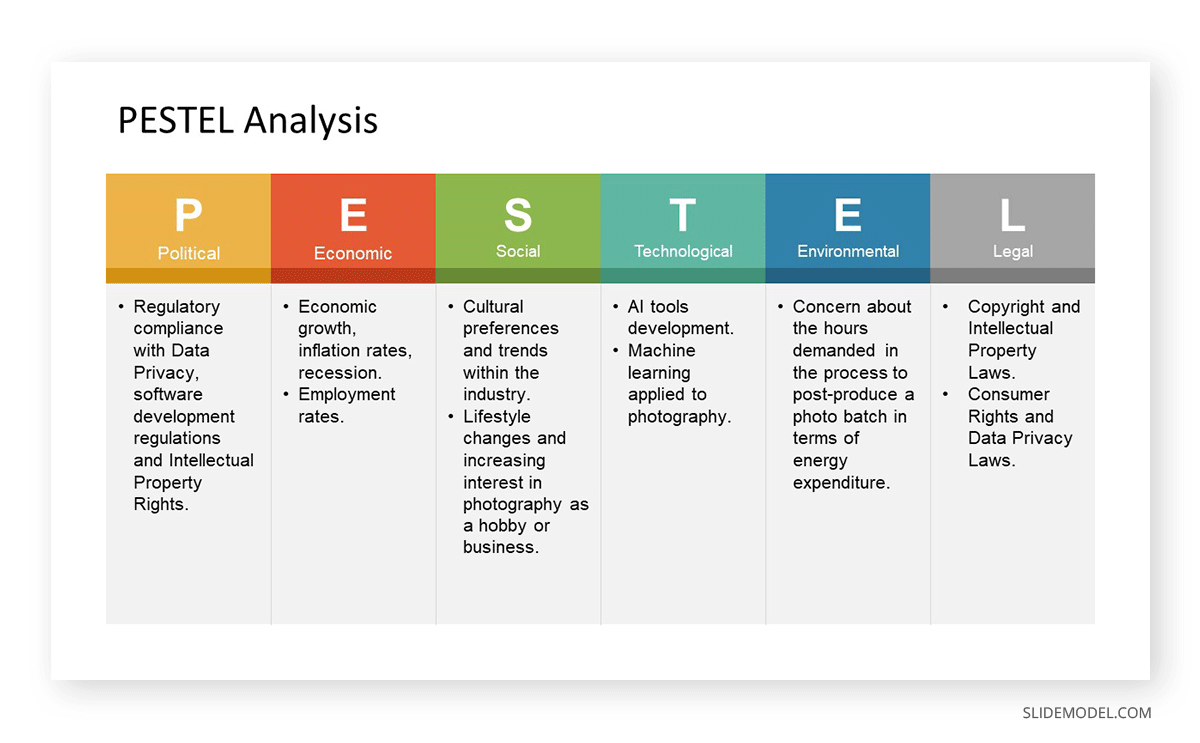
When presenting the value chain, we ought to articulate the sequence of activities the company handles to create value within the business plan. Start by breaking down the value chain into its key components, briefly explaining the stages from inbound logistics all the way through customer service. It is important to highlight the linking point between each stage and express the value of coordinating team activities to enhance overall efficiency.
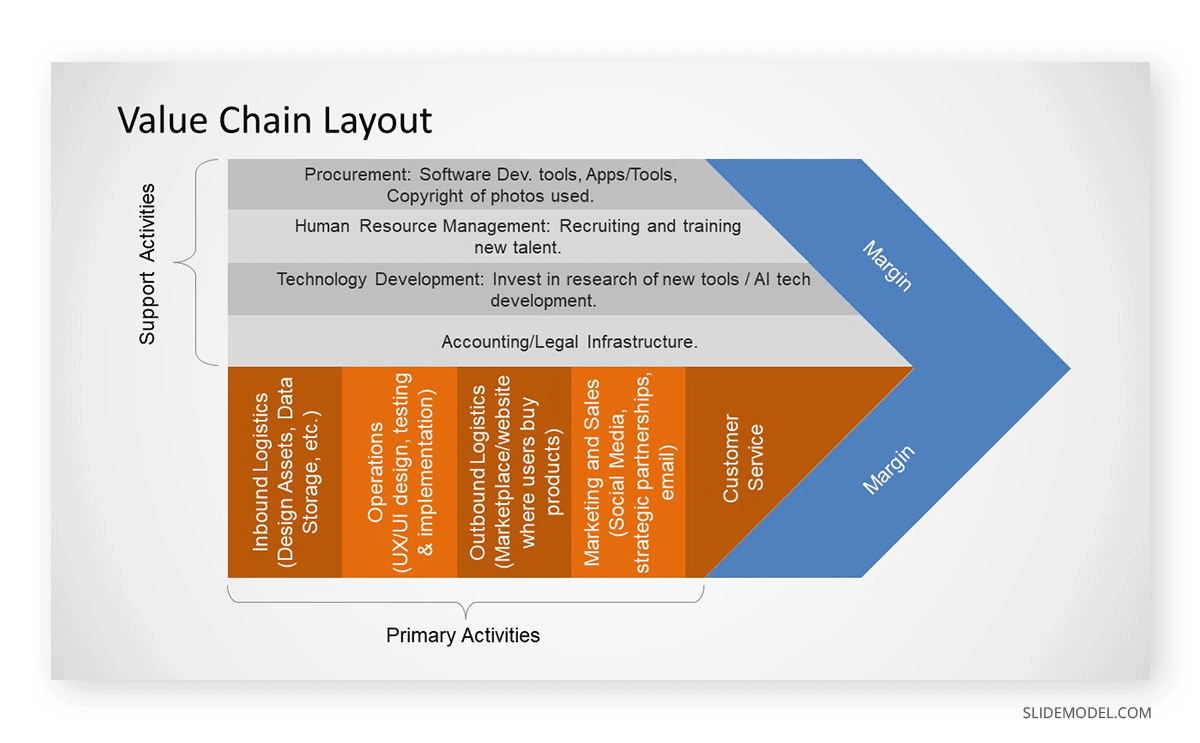
We can use flowchart diagram templates as visual aids for the audience so they can understand the process sequence. Check our guide on how to make a flowchart .
Present the identified Market and its Segments. Continue explaining how conclusions were driven through the analysis and sizing of the market.
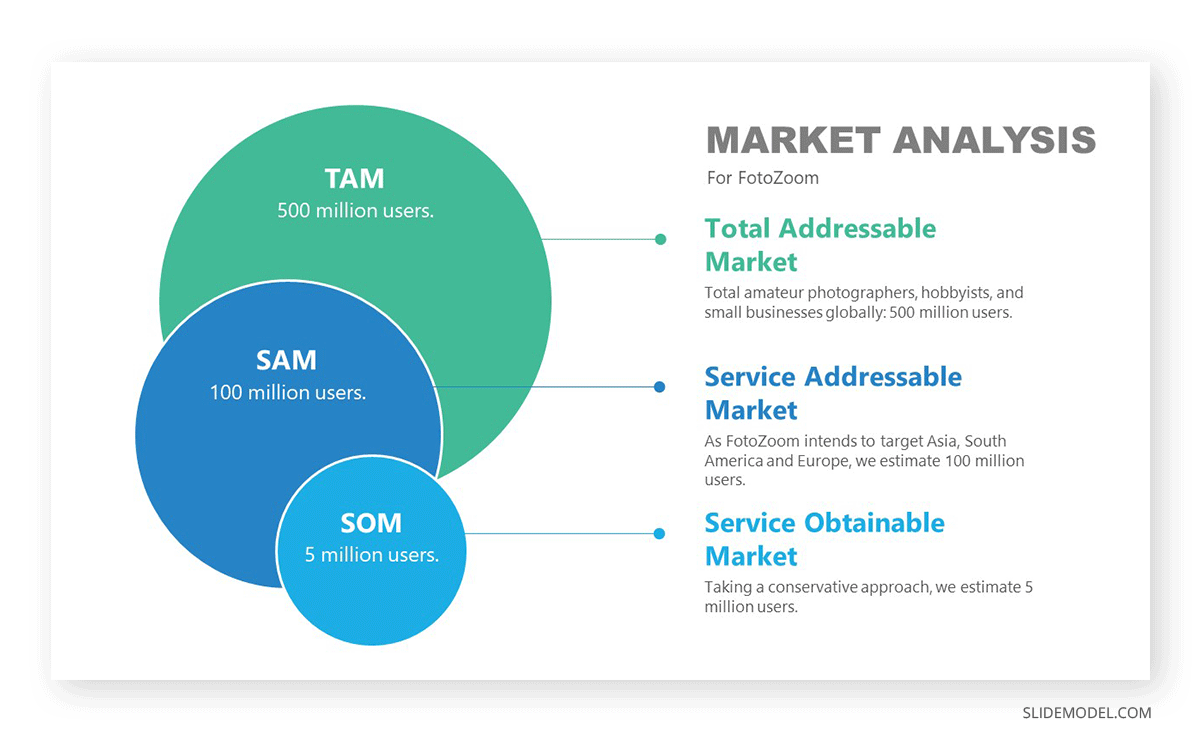
Presenters can use target market analysis templates , market segmentation templates , or TAM SAM SOM templates to compare their target market with the total available market.
We recommend you check our guide on market segmentation for this process.
Then drill down with a Persona definition.
This study can be made by creating ideal customers, describing their demographics and psychological factors that make them prospective candidates to purchase the product or service this business plan presentation refers to.
Here is our guide on creating buyer personas .
The Jobs-to-be-Done theory explains why certain customers are attracted to products and services and how those elements solve core problems in the consumers’ lives.
A Perceptual Map is a tool we can use to measure the consumer perception of different products/services in the same market. This can be particularly useful if our value proposal is to brand ourselves as cheaper alternatives to already existing solutions. Check our guide on perceptual maps for further information.
Check our guide on the Jobs-to-be-Done framework and add suggestions to the business plan presentation.
Stage 2 – Business Model
To describe the Business Model in your Business Plan Presentation, use the business model canvas analysis tool. Display your design in one slide.
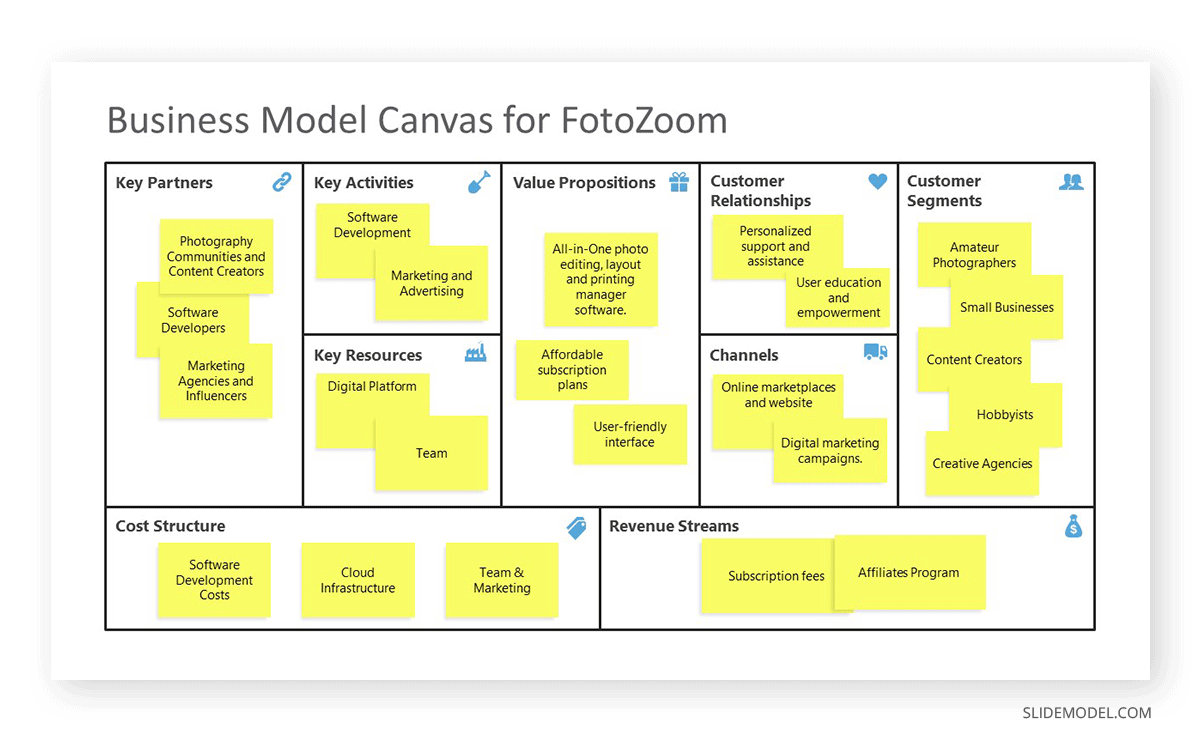
For specific sections of the BMC, you can add slides if you need to drill down for further details. In our experience, the following sections require a deeper level of explanation.
List the Segments targeted in your Business Model. You can include a slide with additional information and segment size. Reference the Market analysis explained earlier to justify the selection or which were the pivots applied.
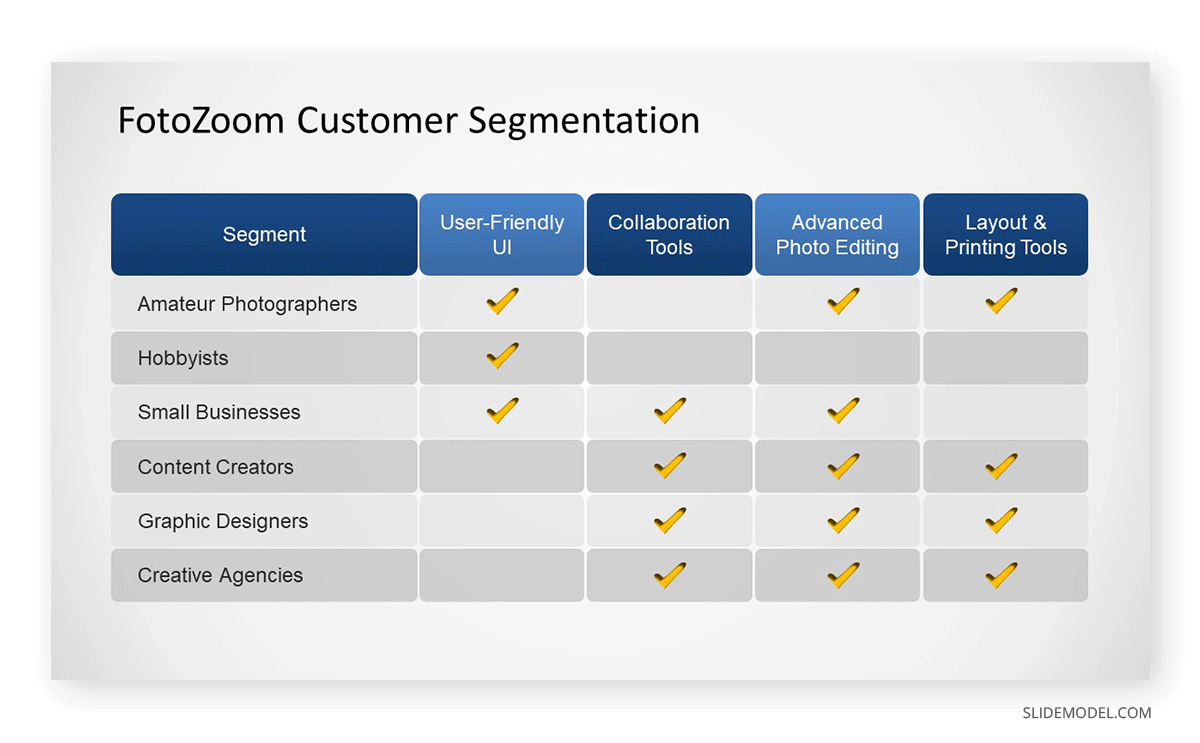
In order to explain the reasoning behind the Value Proposition and how it serves the segments selected, you can use the Value Proposition Canvas tool to explain the logic behind this selection.
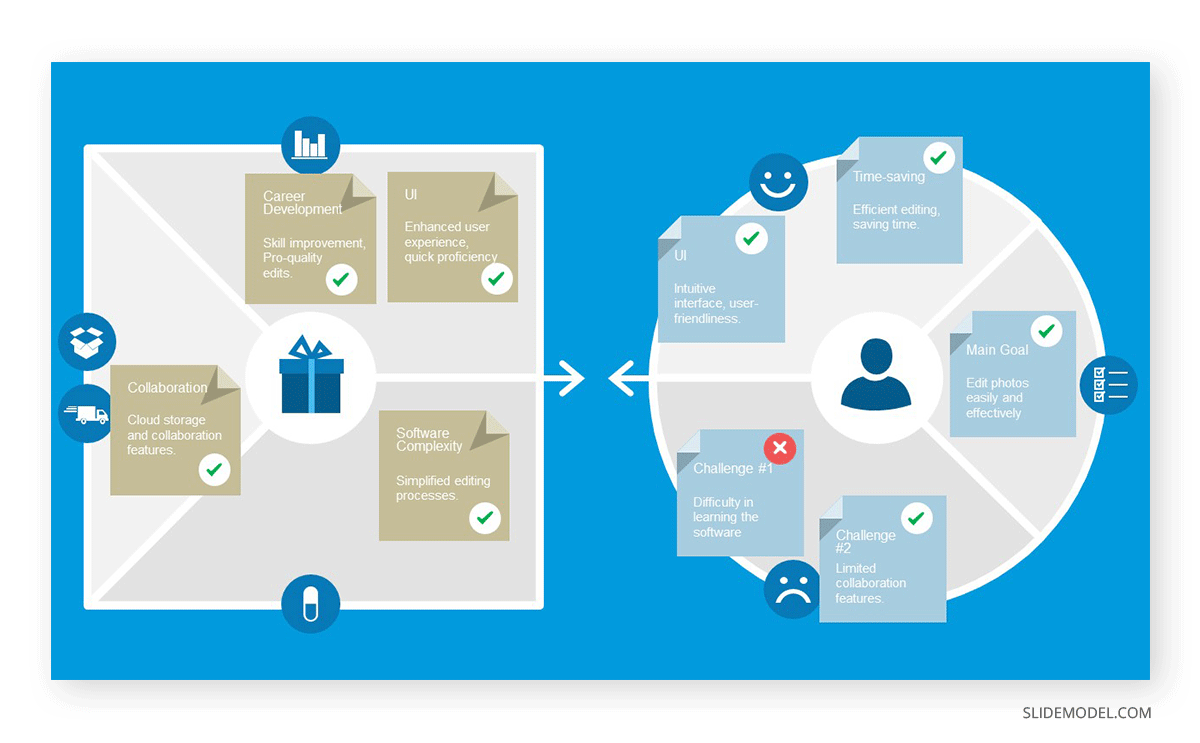
The Value Proposition outlines the unique benefit our product or service offers the market and why customers should choose our offer over potential alternatives. Since we have already analyzed the potential buyers and presented the market, it’s time to deliver that value proposition using our best assets: customer testimonials, report data, surveys, etc.
As testimonials often weigh the most in established brands, be sure to present this information through a narrative that showcases why your product or service had a positive impact on the life of that customer. You can use customer testimonial templates to give an extra boost through visual aids.
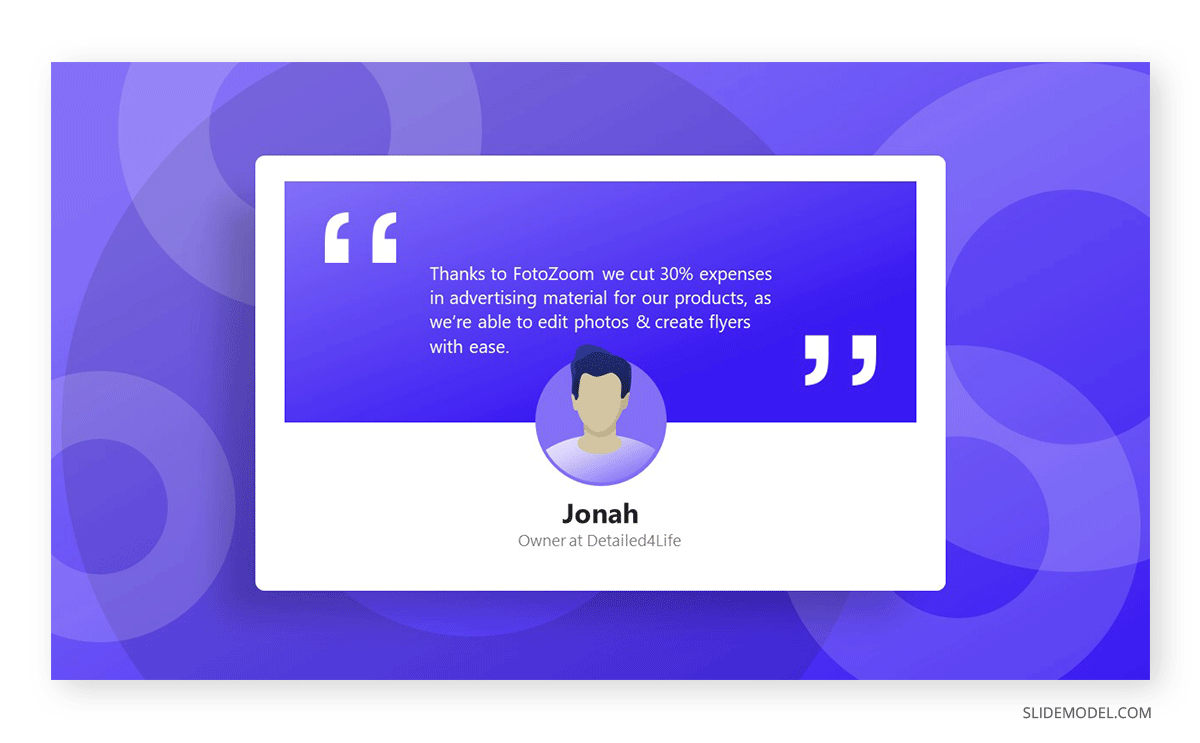
Explaining how much the customers will pay for the product/services is critical to understanding the viability and profitability of the business. Showcase for each segment the pricing model and the engagement terms.
The Income Model expresses the sources of revenue for our business plan. This has to be in relationship with the pricing strategy for established businesses. Lean startups can work concerning their minimum viable product (MVP) and then elaborate with projections for future releases or changes in their income stream structure.
At this point, companies need to present the sources of revenue depending on their origin:
- Product Sales
- Subscription Model
- Freemium Model
- Partnerships with other brands in different niches
- Advertising and Sponsorships
- Monetization
Check our guide on pricing strategy models for more information about how to present this point. You can use revenue stream templates to represent this data in style.
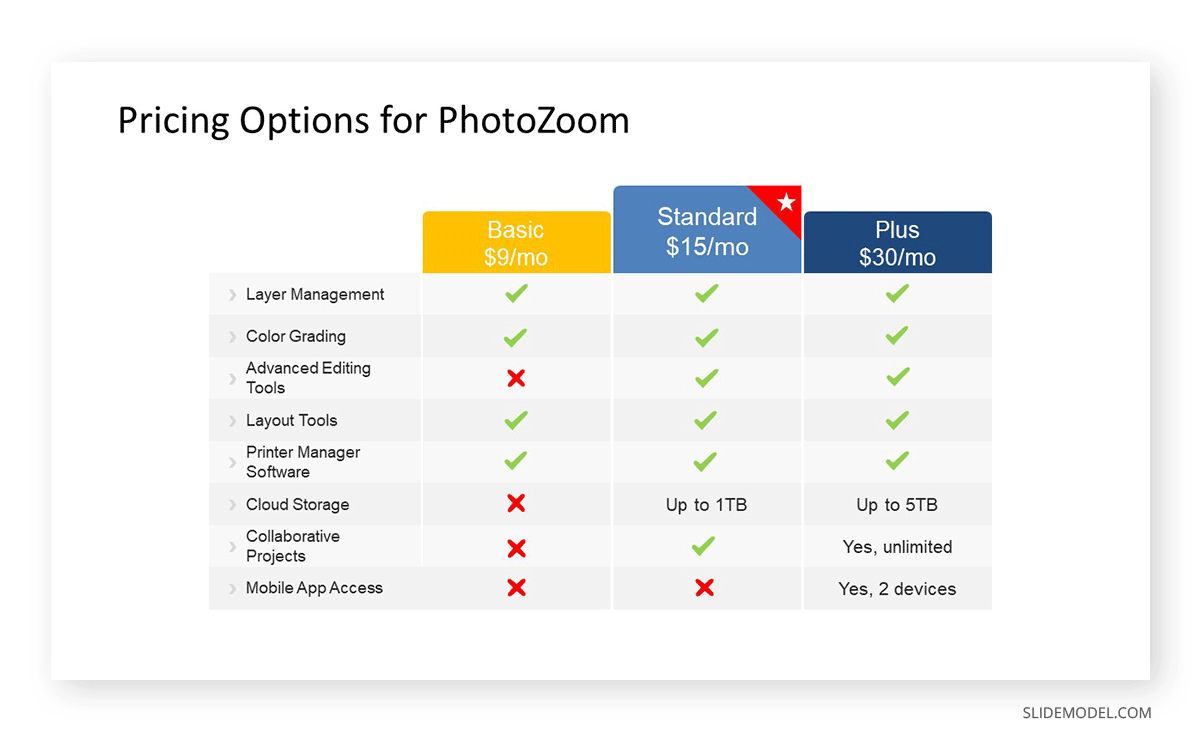
Drill down the cost structure categories and relate them to the Value Chain explained earlier. Show a cost breakdown chart to make it easier for the audience to understand their weight in the total costs.
As this step can be a bit complex to articulate, we recommend you check our guide on Cost Structure to see how you can resume all that information in one slide.
At the business model stage, distribution channels should be briefly introduced since they will be mentioned again in the Distribution Plan . In some industries, it is important to highlight which channels are chosen over others for the sake of revenue and faster operation.
Our Distribution Channels PowerPoint Template is a perfect resource for this.
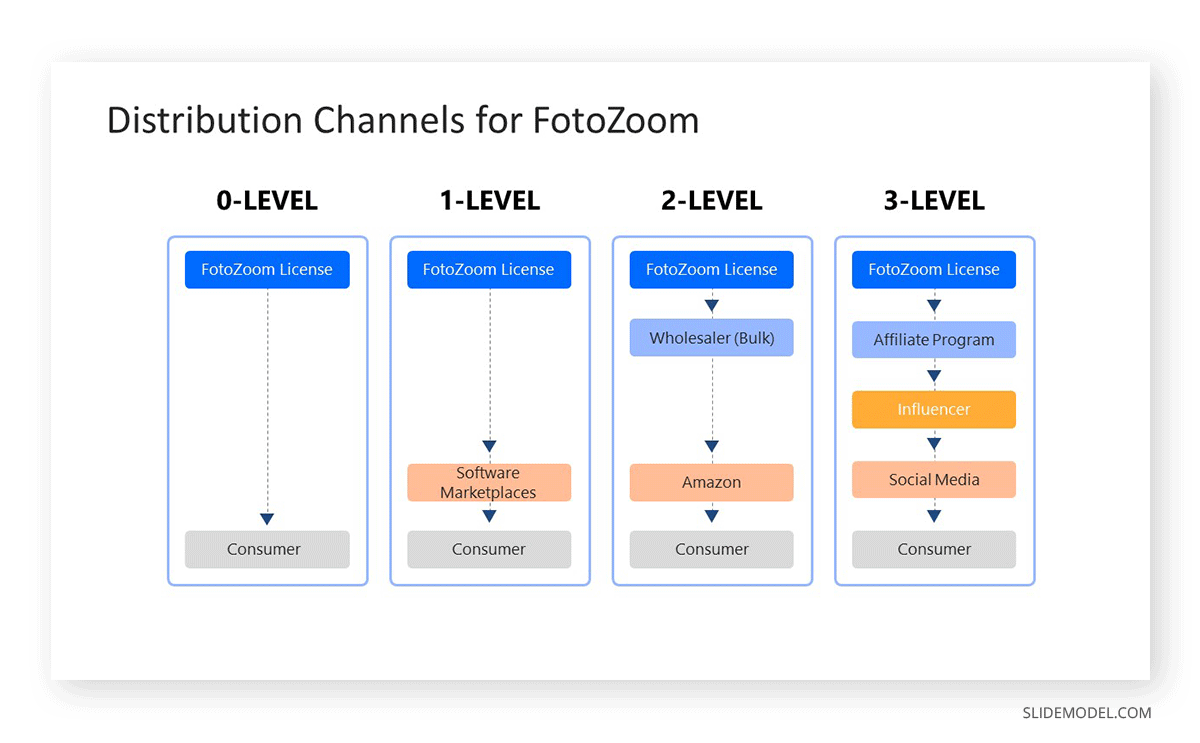
Presenting the strategic partnerships for the business plan is a way to prove the plan’s potential reach and success factor. On this behalf, companies must list which resources they are sharing with their business partners regarding expertise, technology, distribution channels, or capital, as these elements will impact the cost structure.
You can use the Business Partnership PowerPoint Template to present this information in a professional-looking format.
Stage 3 – Implementation
The business plan is designed to offer a product, deliver a service, or combine both. At this stage, the business plan presentation drills down on how the organization will build/deliver the product/service implementing the business model outlined earlier.
Describe how the company operates regarding human capital and its roles. Presenters must describe to the audience the hierarchical structure, responsibilities, and how they play a role within the value chain.
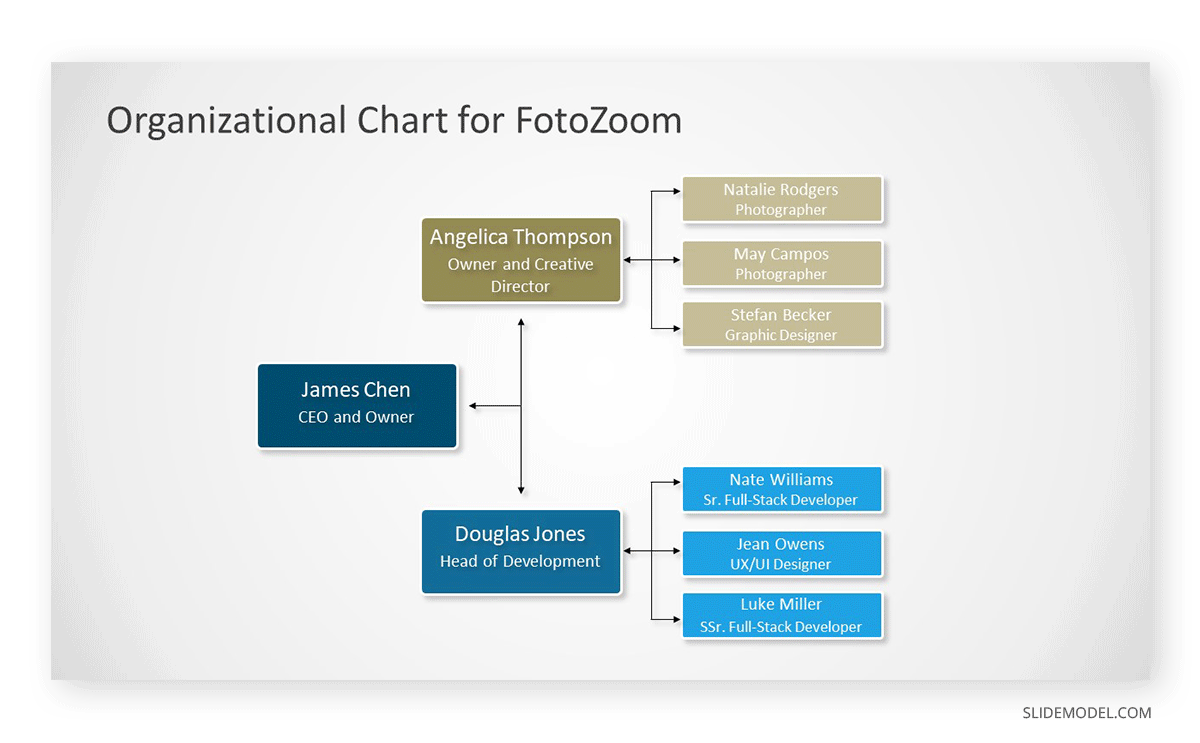
You can use Org Charts to represent the roles and responsibilities in the organization visually. It is also advisable to highlight the expertise and experience of the management team, as it helps to build trust.
The Human Resource Plan must refer to your planned recruitment, training, and employee onboarding. Which talent will be required, and how is it planned to build the different teams of the structure.
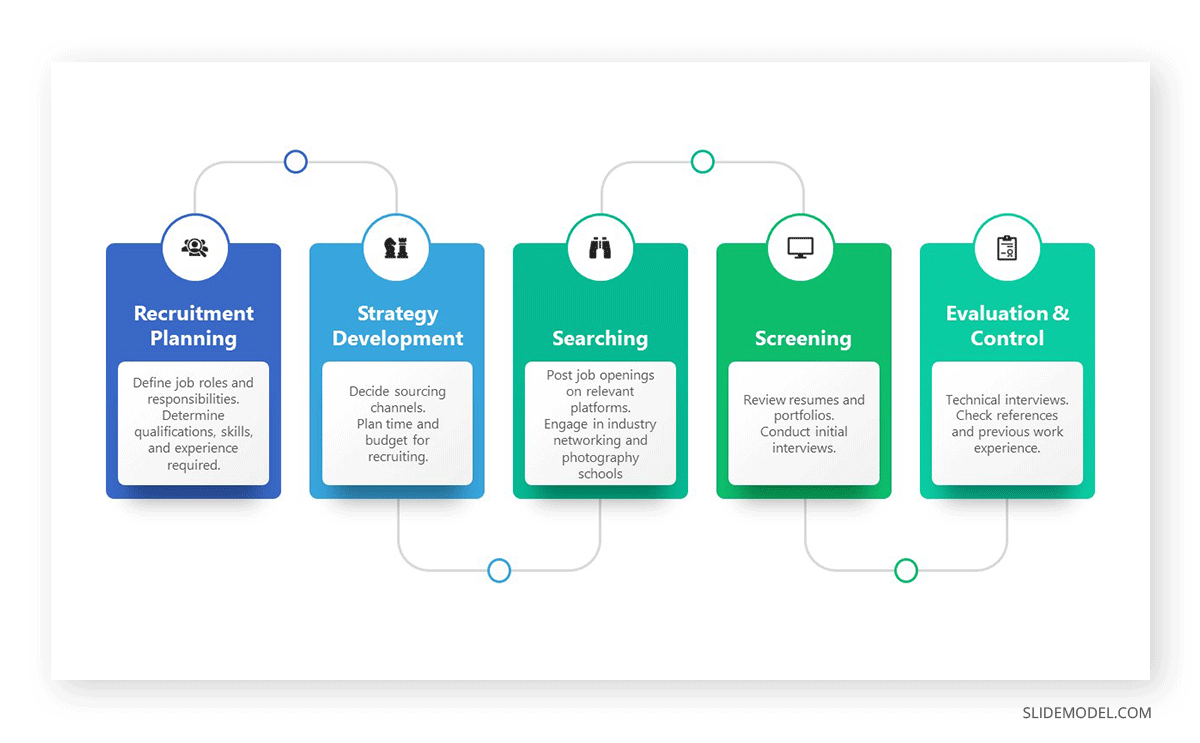
Check the Go To Market Strategy guide and describe how the Business Plan will enter the market and overcome the initial barriers. Continue with the Marketing Plan limited to 1-2 slides resuming the plan’s tactics to increase brand awareness and the selected channels for this strategy.
You can use the Marketing Plan Templates help to speed up the process by focusing on the content to fill rather than the design or creating complex charts from scratch.
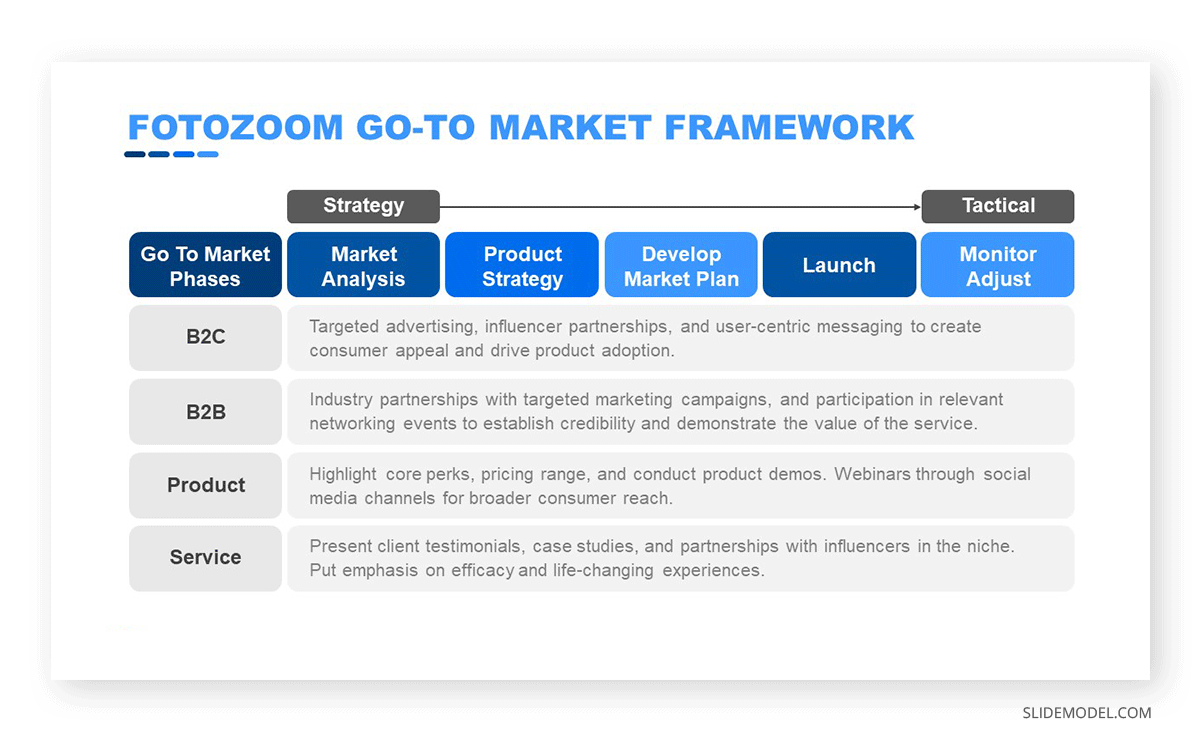
Present the sales plan describing the full sales process, lead generation, nurturing customers, and conversion strategies.
Use Sales PowerPoint Templates to visually illustrate your sales process, like the Sales Pipeline Slide Template for PowerPoint , which depicts the process from lead acquisition to a closed deal.
Check our guide on Sales Plan for further information on this topic.
This step refers to presenting the product/service development plan, the Quality Assurance processes behind its validation, and your company’s commitment to a continuous improvement process based on surveyed data or customer feedback.
We can refer to testimonials, user case experiences our team successfully troubleshot, or experiences we learned from competitors in the same niche.
Presenting the distribution plan involves addressing logistics topics, supply chain , and sharing fulfillment strategies. Although we already presented the potential distribution channels, this is the step in which you detail how each will interact and their impact on the estimated revenue.
Present one slide mentioning your company’s approach to these channels, if applicable:
- Direct Sales (either physical store or e-commerce)
- Retail Partnerships
- Wholesalers or Distributors
- E-Commerce marketplaces
This step involves two different approaches depending on the kind of industry we’re in. For traditional business, inventory management in a business plan presentation must highlight how the inventory will be handled to minimize transportation costs or overproduction. Projections must be shown per quarterly period and take into account seasonality if it has a significant impact on the required storage capacity.
On the other hand, e-commerce companies have to present their online infrastructure to secure the product’s availability 24/7, how customer tickets are handled when the customer cannot access the product, server costs, and how we prevent online leaks.
Stage 4 – ROI and Risk Evaluation
This section will outline the Financial Plan of your Business.
Showcase the financial structure, including equity, debt, and potential investors, at the moment of kick-starting this business. It is a good practice to consider the initial funding slide to be a brief summary of those points, with particular emphasis on the funding needs.
Cash Flow Diagrams , Comparison Chart templates , and Timeline templates to showcase when funds help to meet each of the plan’s milestones are good ideas to represent the elements on this slide.
Income and expense projections must be presented over a defined time period by using graphs or charts to clearly visualize the trends supporting each change.
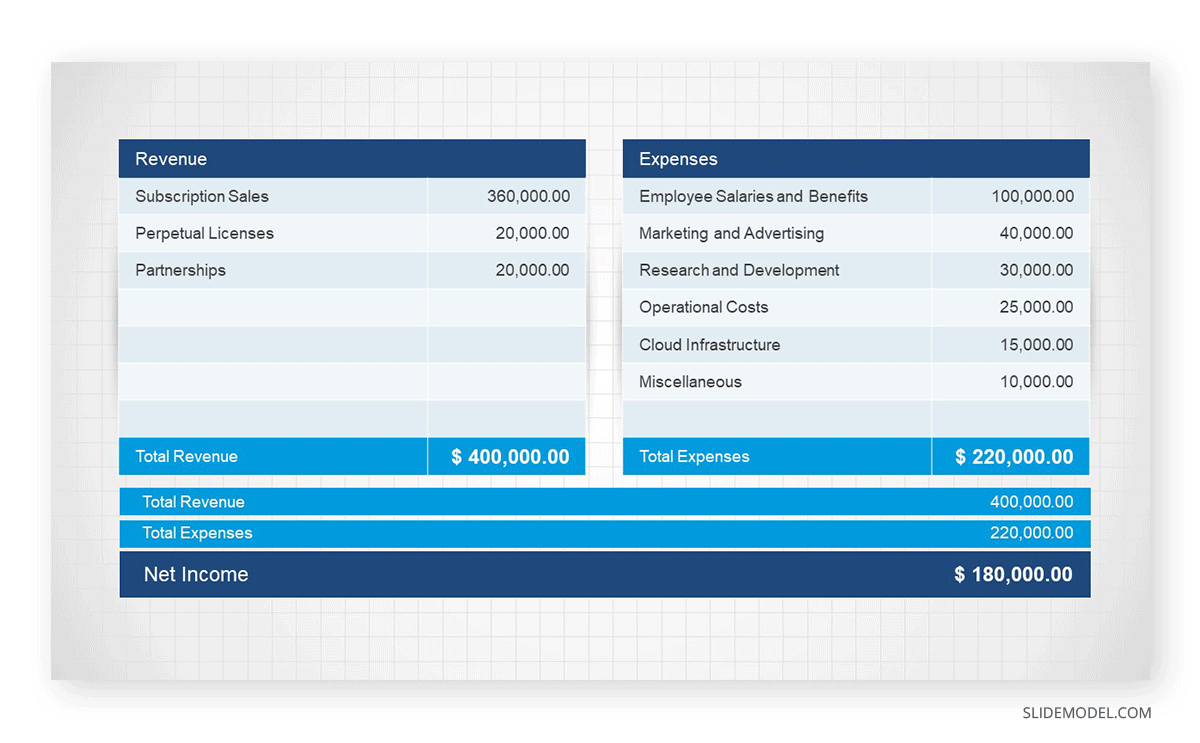
Break down the revenue sources with clear, identifiable icons to showcase: product sales, subscription fees, advertisement, affiliates, etc. Sales estimations have to be realistic and conservative, as they will be contrasted with the production, marketing, administrative, and personnel costs to leave a gross profit margin calculation.
Evaluation of Projected Return vs. Required
Demonstrate the feasibility of your business plan. Start by presenting the profit margins in relation to the projection of income and expenses, then introduce the break-even analysis .
Presenters can make their message more relevant by presenting an ROI calculation and contrasting it with industry benchmarks in the same niche. By following this approach, presenters prove how the ROI offered by this business plan aligns with the investment’s risk projection.
Presenting a risk evaluation analysis in a business plan presentation involves introducing both risks and their mitigation strategies.
Risk Management templates , like the ROAM framework, can help organize potential risk sources by their severity and impact on the organization. A pyramid diagram can be used to demonstrate how risk management can be delegated across the organization to completely eradicate the risk factor depending on its severity.
The elements you should consider presenting are mainly regulatory changes, market changes, competitors (new or existing), and financial crises.
The final point in our business plan presentation involves summarizing how key variables can influence the projected returns in our plan. Examples of these variables can be sudden increases in raw materials (affecting production costs and sales prices), a new pandemic (affecting workforce capacity and shortage of raw materials), geopolitical situations like war, etc.
We highly recommend presenting these critical variables using scenario analysis techniques according to measured data. Introduce best-case, worst-case, and most likely-case to give a full panorama of how your organization is prepared against any contingency.
An often overlooked point in a business plan presentation comes when listing the bibliographical information used to craft the business plan. Follow these steps to ensure a professional outcome for this slide or document.
- Use a title like: “Bibliography,” “Source Credits,” or “References.” If your business plan presentation cites examples from other companies, use a “Works Cited” section.
- References are usually shown in the APA style, but the MLE or Chicago style can be requested depending on your location or situation.
- Maintain a consistent style in terms of reference style used, font, text size, and formatting options across the entire slide deck. Footnotes or in-text citations can be used for important data.
- Verbally acknowledge your sources when required throughout the course of your presentation. This helps to establish credibility and respect for other people’s work rather than just dropping a slide with chunks of text.
This section will cover the most commonly asked questions on delivering a business plan presentation.
How many slides should my business plan presentation list?
This will depend entirely on your niche and the complexity of the business plan. Generally, work with at least 15 slides and no more than 30. It is best to use an extra slide rather than overcrowd an existing slide with tons of information.
What is the best format to present a business plan?
There are different options to present any business plan, so the selected option will mostly consist of the presenter’s preferred style and the audience’s age and interests.
- PowerPoint Presentation : You can start from a blank slide and go all the way through a professionally designed PPT template . PowerPoint documents allow you to present images, text, audio, videos, and any kind of graphic to help you convey the core ideas behind the business plan. They can work with any PC or Mac device, as well as mobile devices.
- PDF Documents: This can be a choice made in a hurry or by preference. Sharing a PDF document can work, but you must include the fonts used in the original document, as some compatibility issues can be present.
- Pitch Deck : Rather than doing a lengthy business plan presentation, a pitch deck consists of a maximum of 15 slides to deliver your proposal concisely. This is the typical approach we can see in TV shows like Shark Tank.
- Video Presentation : In some cases, using a video in a business plan presentation is relevant, especially if we are to introduce an innovative product in the market. You can use videos to showcase features, present services in a live format, introduce your team, and plenty of other options.
Are printables required in business plan presentations?
Although they are not required, using supplementary material in business plan presentations can be useful. You can prepare reference material for investors, especially involving complex data like graphs in an amplified format (and reference the slide in which they appear and vice versa).
Providing a printable to accompany your business plan presentation helps to give an image of professionalism and respect to your proposal.
What are the don’ts of writing a business plan?
The main purpose of this article is to craft and deliver a business plan presentation. Still, we would like to clarify some common errors seen in business plans that typically affect the performance of the presentation.
- Using overcomplicated language : Jargon or unnecessary acronyms may confuse spectators who are not in touch with all the details relevant to a particular industry.
- Ignoring the audience : Not considering the variety of interests among investors, partners, and team members can hinder your presentation.
- Neglecting/underestimating competitors : Any realistic business plan considers the existing competitors in their niche and perhaps potential newcomers. Not doing so will leave you unprepared to present a doable business plan.
- Ignoring Risk Assessment : Omitting the Risk Assessment analysis and mitigation strategies does not respect the value investors and your team have.
How long should the business plan presentation be?
As a general guideline, try to fit your business plan presentation between 20-30 minutes. Some complex plans may require additional time to be presented.
Does the presentation need to be tailored to different audiences?
Using this tactic can be a winning factor for both investors and your team, as you prioritize effective communication for the roles they are relevant. Take these items into consideration for tailoring the presentation for specific needs.
In-Company Presentation
The focus should be on goal accomplishment and the strategies targeted to the team’s roles. Emphasize how teamwork is the pathway to success and how each individual contributes to the bigger picture.
If new technologies or knowledge are required as part of the business plan implementation, then this is the moment to disclose that information and inform the process to coach the team into it.
Board Meeting
Whenever delivering the business plan presentation to a board of directors, focus on the strategic goals, financial projections, and KPIs.
Showcase how this business plan aligns with the company’s core values, mission, vision, and long-term strategy.
Potential Investors
Presenting your unique value proposition, potential ROI, and highlighting the market opportunity is extremely important. Focus on selling your business model and vision with accurate financial projections and growth strategy.
Dedicate some minutes to present your industry’s competitive landscape and answer why your product or service is a better offering than what competitors produce.
As we can see, creating a business plan presentation is a process that can be time-consuming if we lack the required business plan presentation tools to turn data into visually appealing formats.
Remember to work concisely without losing the big picture of what you intend to explain. Your presentation is the entry point into the heart of your business; therefore, by adopting a structured approach, you can deliver an experience that engages, inspires, and builds confidence.
Finally, let’s see some business plan PowerPoint presentation examples & business plan templates that you can use to speed up the presentation design process and save time.
1. Coffee Shop Illustration Business Plan Slides

Create your new business plan presentation with quality vector illustrations for Coffee Shops. Ideal for cafeterias, coffee bars, barista giftshop stores, bookshops and more.
Use This Template
2. Real Estate Business Plan PowerPoint Template

Realtors looking to start their own agencies should take a look at this attractive selection of slides with tailored real estate vector illustrations. These presentation plan slides show the different stages that a prospective buyer may incur, from hiring the services of a Real Estate agent, checking different properties, to finally buying a home. Graphs and charts are included in vivid colors that are fully editable to meet the required branding.
3. Restaurant Business Model PowerPoint Template
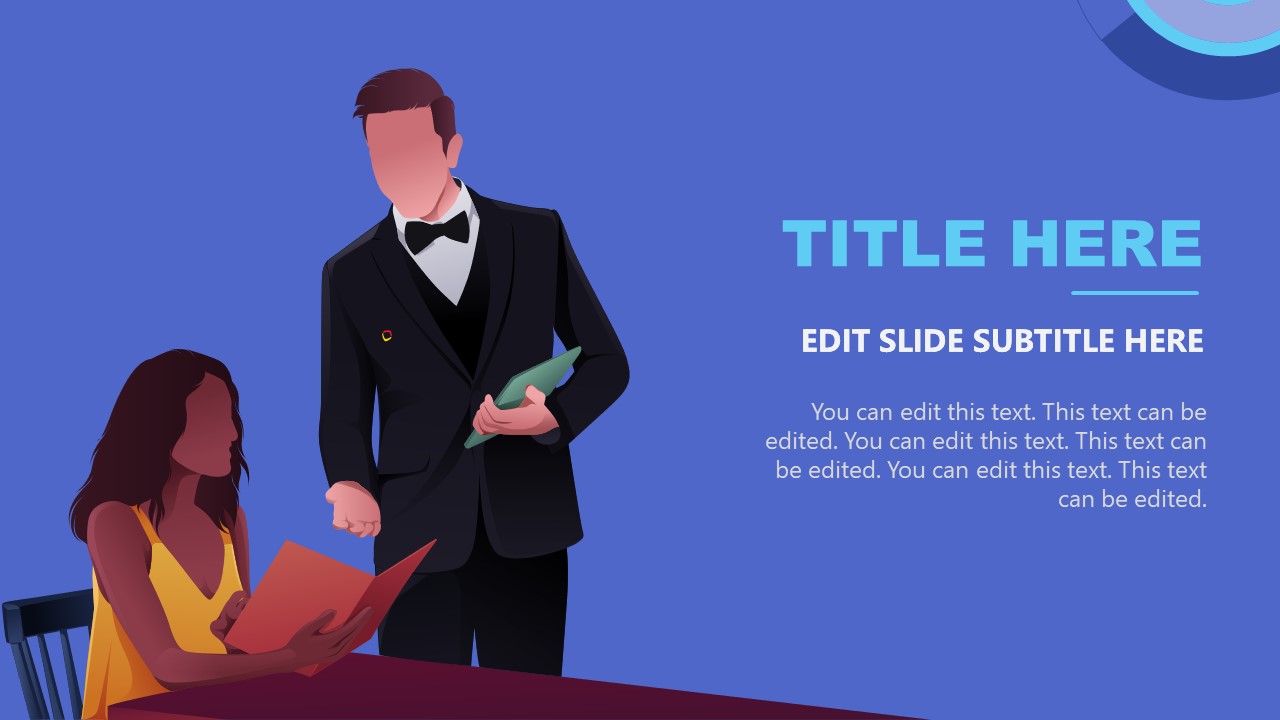
As we’ve seen with the previous cases, these vector images depicting typical restaurant activities can help us build a business plan presentation sample to discuss with our team prior to an important meeting. Save time and money by introducing these professional designs into your presentation.
4. One Pager Business Plan PowerPoint
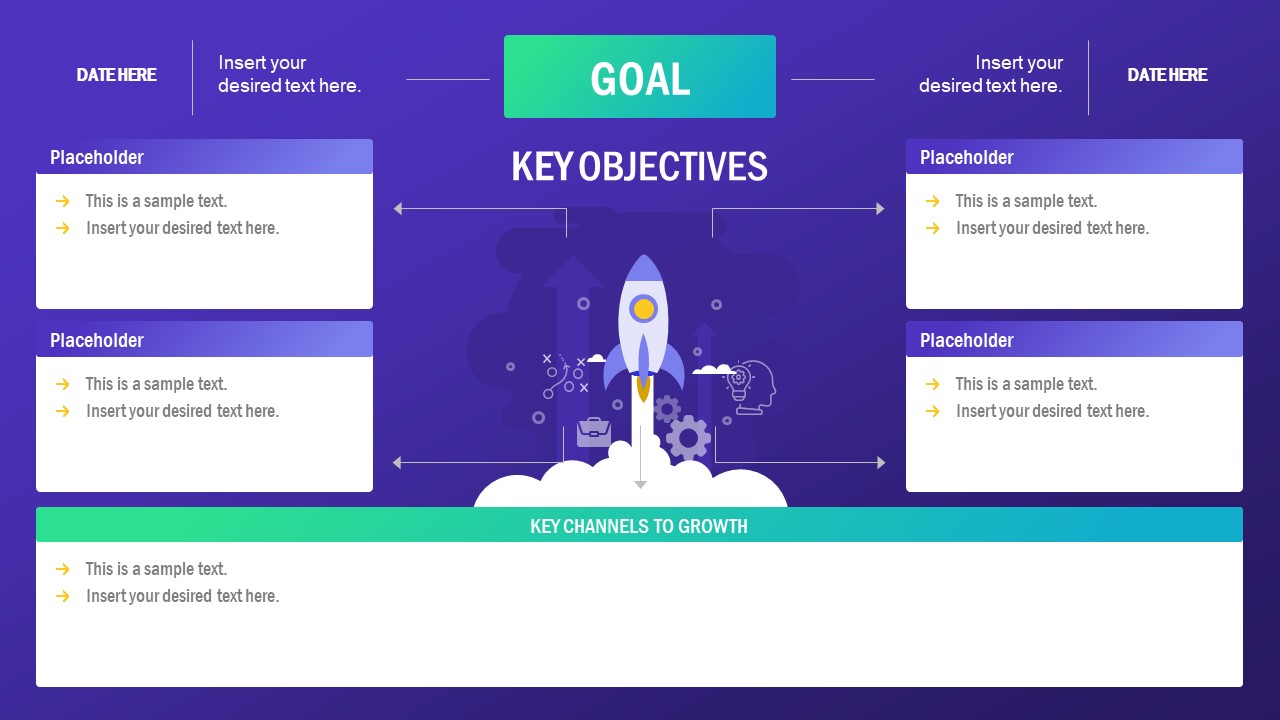
To briefly summarize the objectives of your business plan, work in-team with this one-pager business plan slide. Ideal to take notes, give a general picture of the current status of the business plan and key growth opportunities.
5. Business Plan PowerPoint Templates
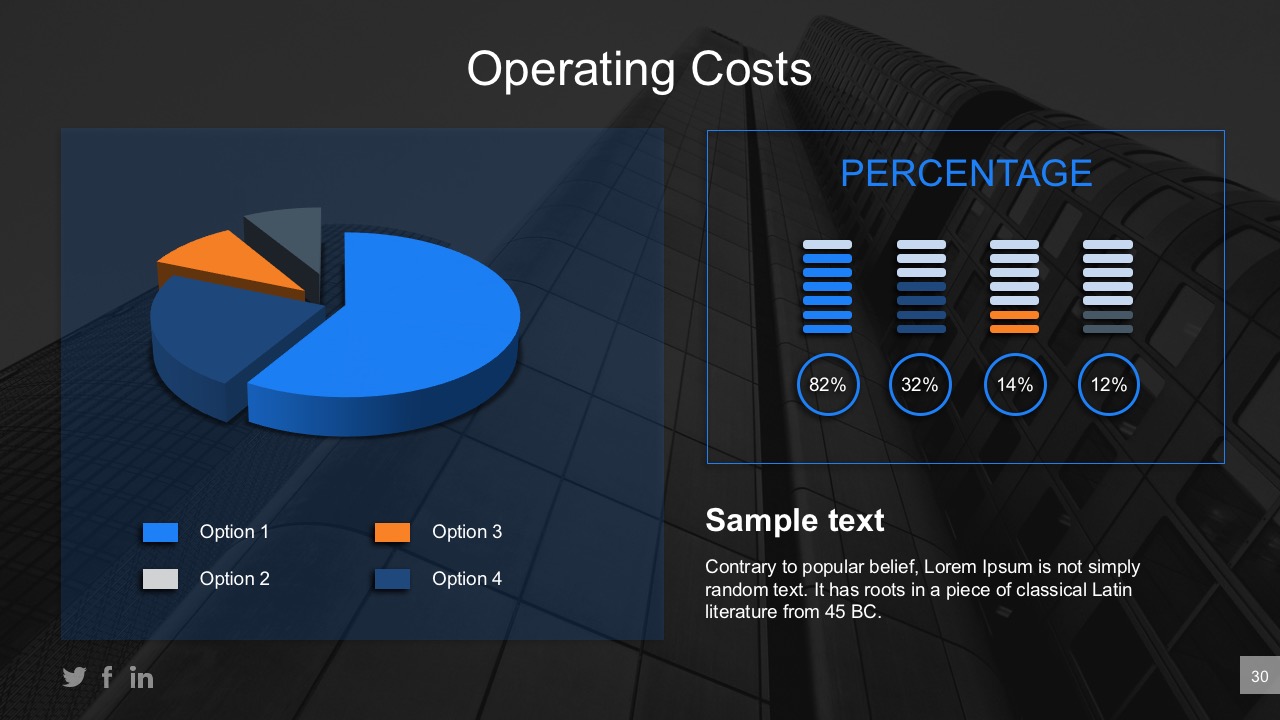
If you want to create the best business plan presentation, this slide deck can make that task 100% easier. Containing all the elements described in this guide, introduce your data and prepare to deliver a powerful speech.
6. Flat Bold Business Plan PowerPoint Template
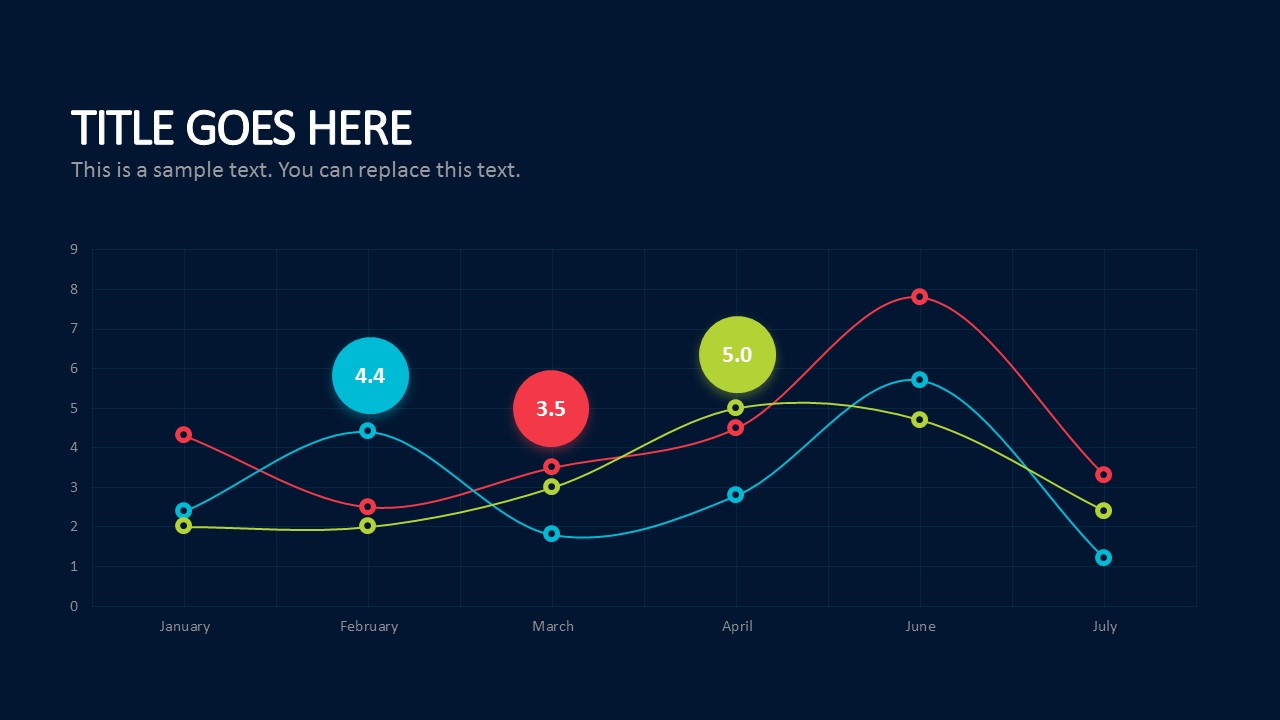
Another slide deck intended for those looking at how to make a business plan presentation that delivers a memorable experience. With a minimalistic design approach, it perfectly balances formal elements and impactful visual cues to help increase your audience’s retention rate.
7. Car Sharing Business Plan PowerPoint Template
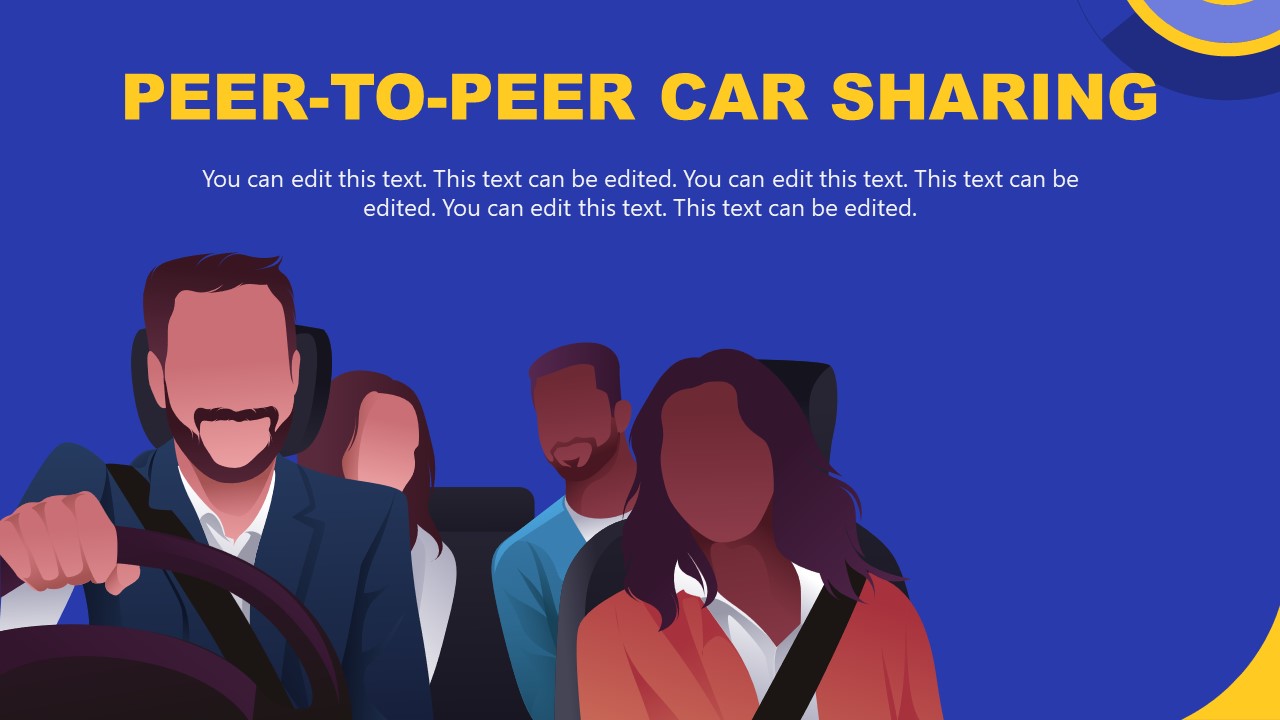
Create the next Uber-like car-sharing service with the help of these carpooling vector illustrations perfectly arranged in a cohesive business plan slide deck. Presenters can explain the ins and outs of their business model with highly detailed graphics that grab the attention of potential investors. Check it out now!
8. Beauty Salon Business Plan PowerPoint Template
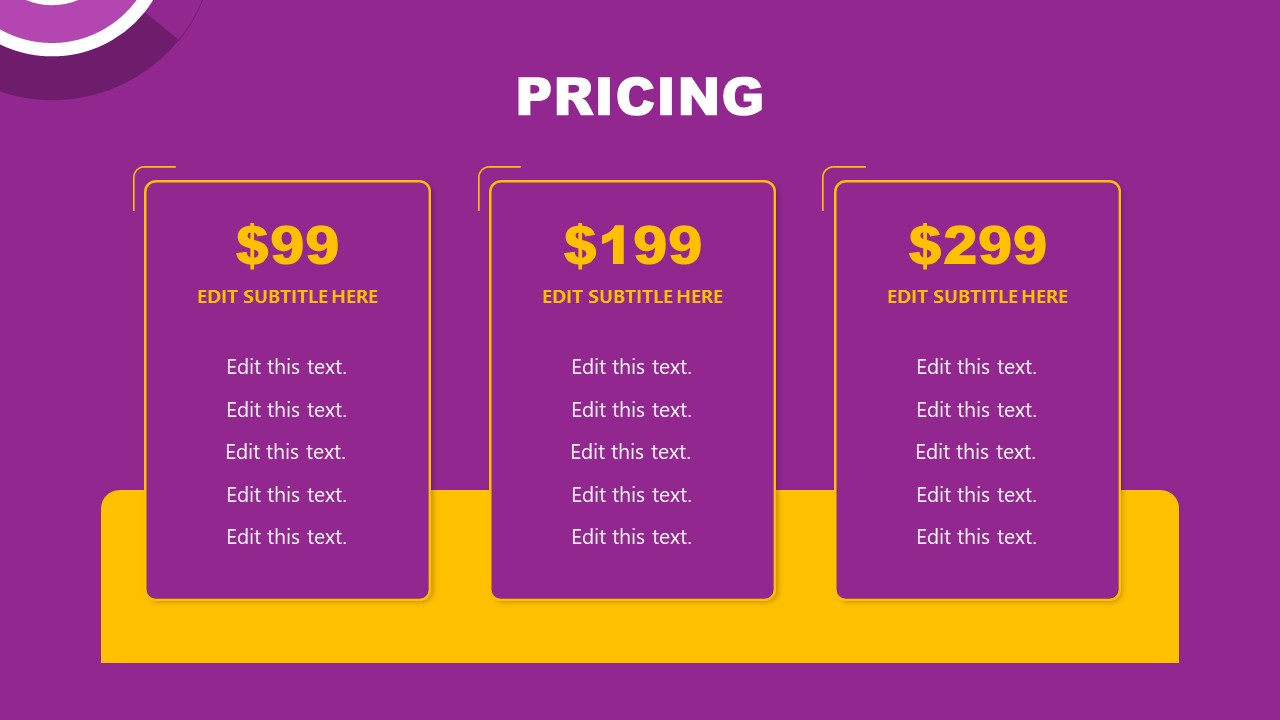
Business plan presentations don’t have to look formal or boring. This slide deck is geared towards beauty salon businesses, especially for those targeted to women. Chic design, bold color scheme, and extremely useful tools like a pricing list to present an idea like a subscription-based model where consumers see the total value of their investment.
9. CrossFit Business Plan PowerPoint Template
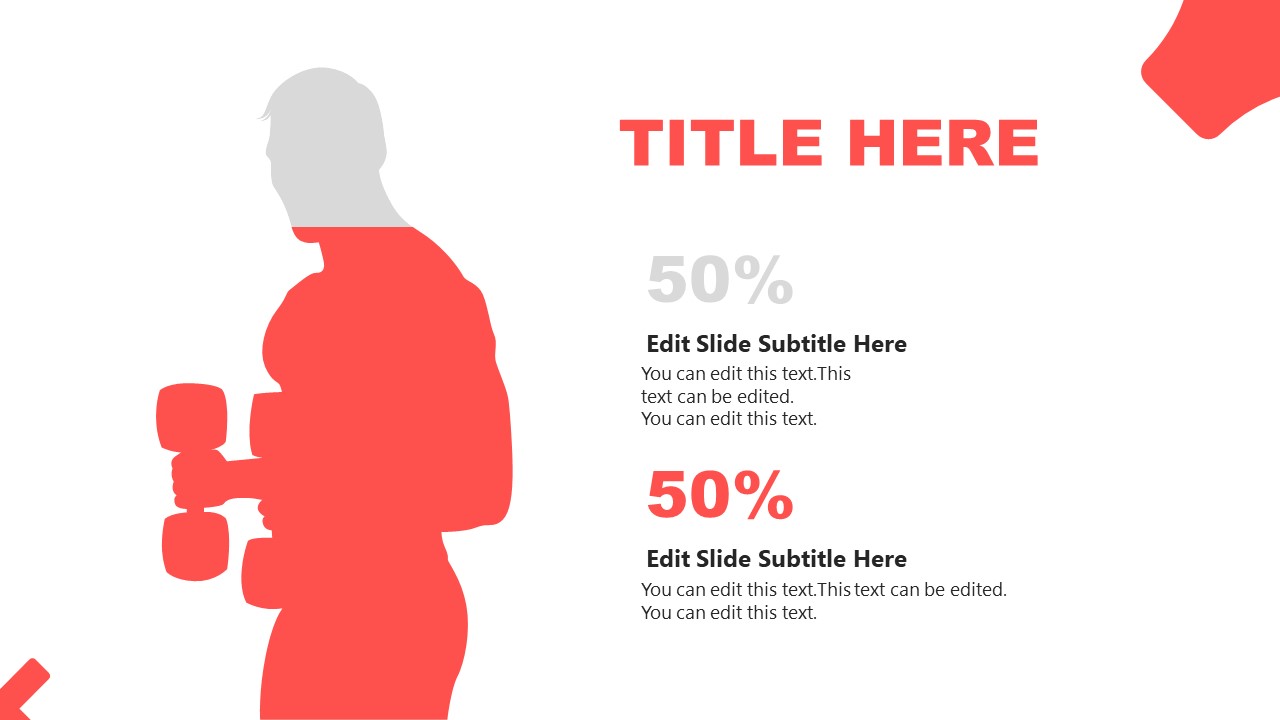
Finally, we list an option filled with tools and gym vector illustrations for those looking to start a gym business or CrossFit academy. These illustrations were crafted with care to express the core idea on every single slide, such as human-shaped graphs to present relevant KPIs.

Like this article? Please share
Business Planning, Business Presentations Filed under Business
Related Articles

Filed under Business • May 8th, 2024
Value Chain Analysis: A Guide for Presenters
Discover how to construct an actionable value chain analysis presentation to showcase to stakeholders with this detailed guide + templates.

Filed under Business • April 22nd, 2024
Setting SMART Goals – A Complete Guide (with Examples + Free Templates)
This guide on SMART goals introduces the concept, explains the definition and its meaning, along the main benefits of using the criteria for a business.

Filed under Business • February 7th, 2024
How to Create & Present a Competitive Landscape Slide for Your Pitch Deck
Get to know how to properly create a winning competitive landscape slide for your pitch deck. Boost your pitch performance now.
Leave a Reply
Got any suggestions?
We want to hear from you! Send us a message and help improve Slidesgo
Top searches
Trending searches

11 templates

20 templates

holy spirit
36 templates

9 templates

25 templates

memorial day
12 templates
Business Presentation templates
Engage your audience in your business presentations with our free customizable ppt templates and google slides themes. they’re perfect for business plans, office meetings, pitch decks or project proposals., related collections.

Company Profile
565 templates

598 templates
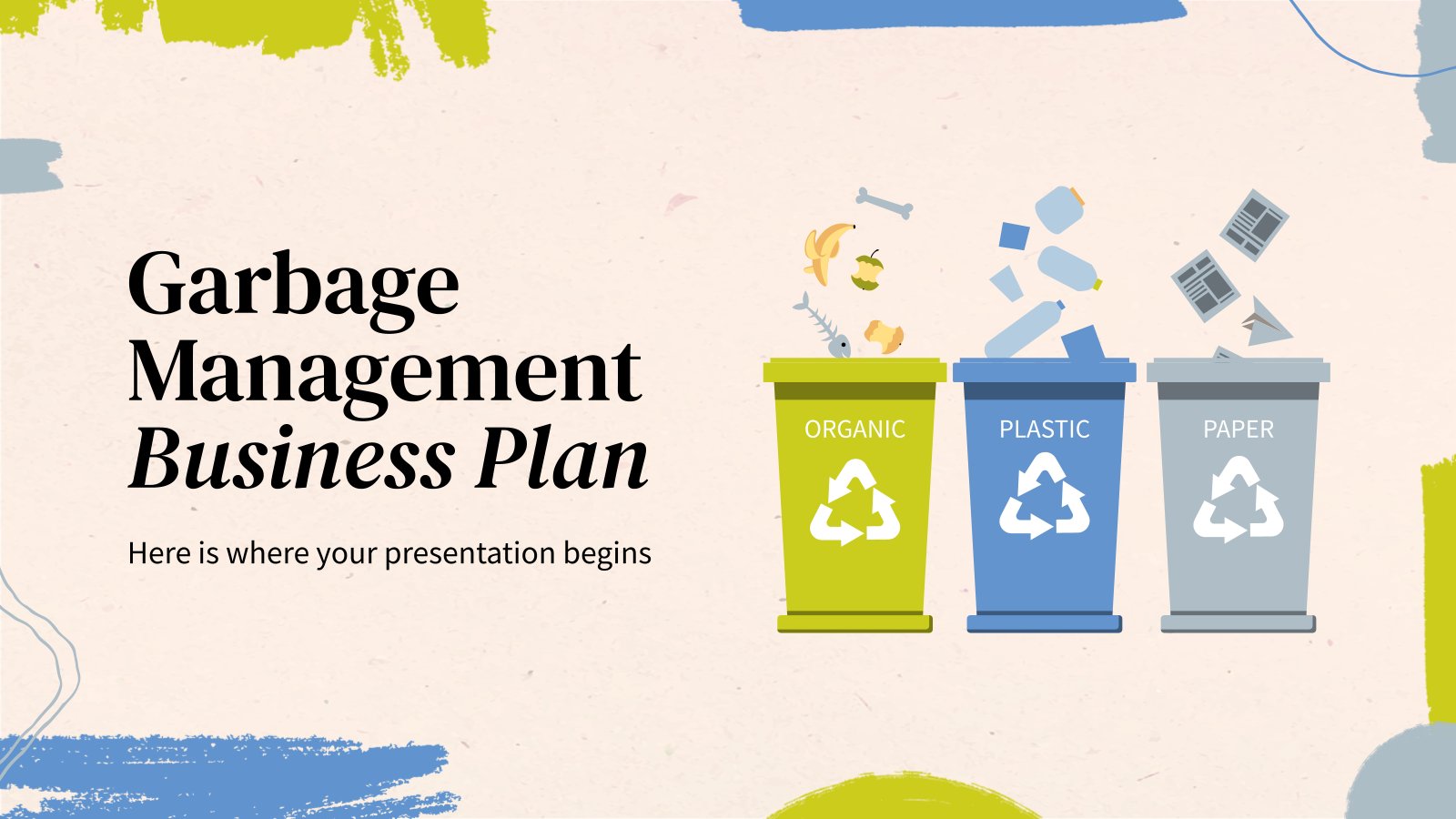
Business Plan
818 templates
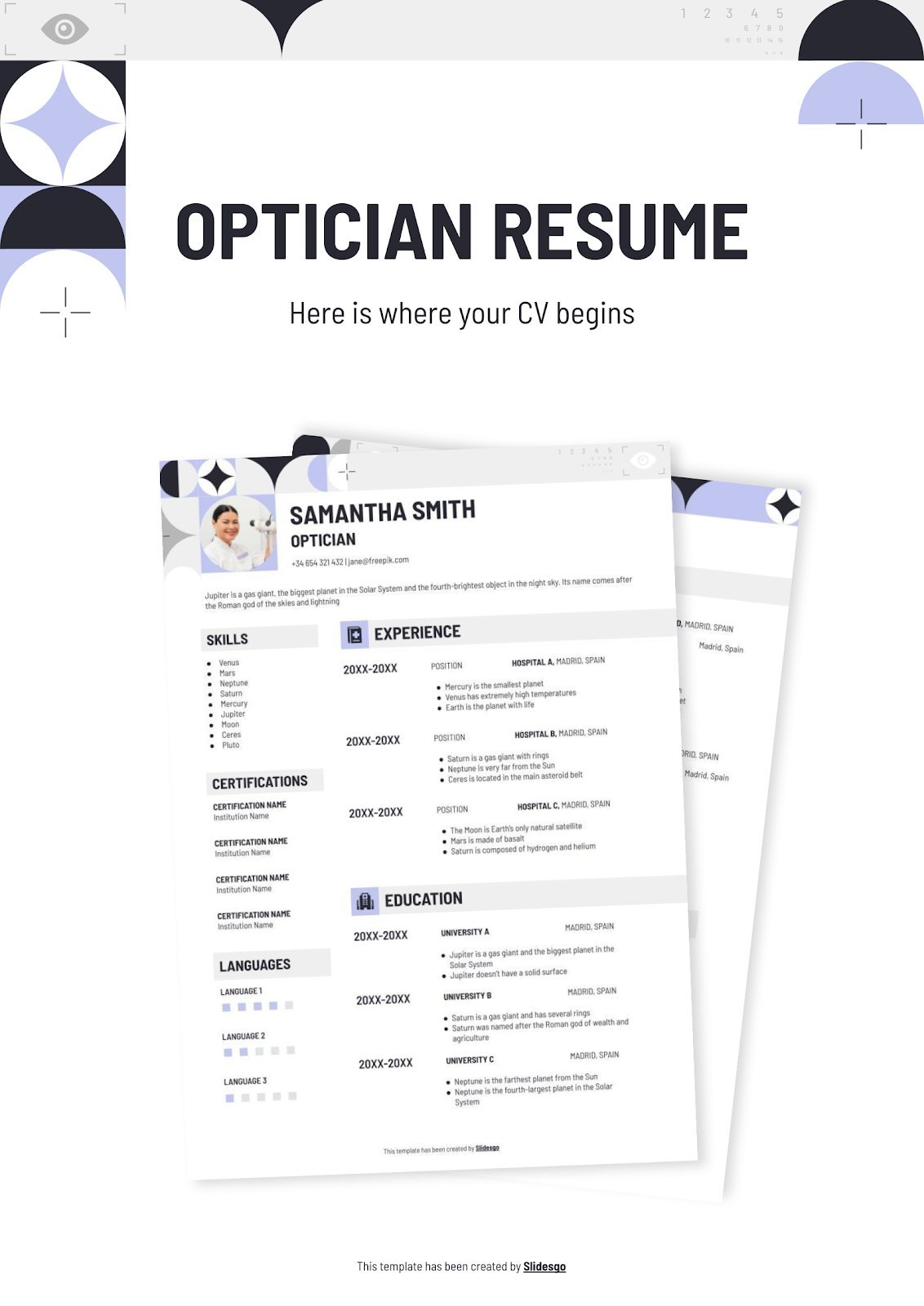
470 templates

495 templates

567 templates

369 templates

Project Proposal
614 templates

It seems that you like this template!
Product manufacturing project proposal.
Download the Product Manufacturing Project Proposal presentation for PowerPoint or Google Slides and start impressing your audience with a creative and original design. Slidesgo templates like this one here offer the possibility to convey a concept, idea or topic in a clear, concise and visual way, by using different graphic...

Automotive Technology Business Plan
Download the Automotive Technology Business Plan presentation for PowerPoint or Google Slides. Conveying your business plan accurately and effectively is the cornerstone of any successful venture. This template allows you to pinpoint essential elements of your operation while your audience will appreciate the clear and concise presentation, eliminating any potential...

Monthly Strategy Review Meeting
The results from last month were great for the company, now we must keep it up! If you'll be discussing the strategy to follow during your next meeting, prepare a presentation and have the agenda and the different points to be talked about ready. We didn't want something too serious,...

Investment Business Plan
Rewards come after a great investment, and this applies especially to companies. You’ll need to attract potential investors and other people to put their trust in your project. With this free presentation template, you can explain your business plan, your market research and everything you need to strike a new...

Sustainable Maize Producer Consulting
Download the Sustainable Maize Producer Consulting presentation for PowerPoint or Google Slides. Your business demands smart solutions, and this consulting toolkit template is just that! This versatile and ingenious toolkit will provide you with the essential tools you need to shape your strategies and make informed decisions. Whether you are...

Premium template
Unlock this template and gain unlimited access
Simple Business Plan
Boosting sales, attracting new customers, expanding the market... All of these are goals that businesses want to achieve. Aim high in your next presentation for your business plan, especially if you put your trust in this free template by Slidesgo.
.jpg)
Public Consulting
Consulting services are essential for many businesses and organizations. Promote yours by showing your audience a presentation created out of this dynamic template. The illustrations are isometric, which is always a good innovation. All the layouts, graphs and infographics included are very helpful when it comes to defining your potential...

Macari Company Profile
Making your business known in all areas is not easy, but not impossible either. Clear, concise, direct and minimalist: this is the aesthetics of this presentation with which you can create your company profile department by department, down to the smallest detail. With only three colors (white, black and red)...

Colorful Candy Shop Company Profile
Do you like candies? It’s time to sweeten your presentation with a very fun template! The pastel colors and wavy abstract shapes will make your information stand out and frame your data into a cool candy-land. Present your candy shop to potential investors, clients or at an industry level and...
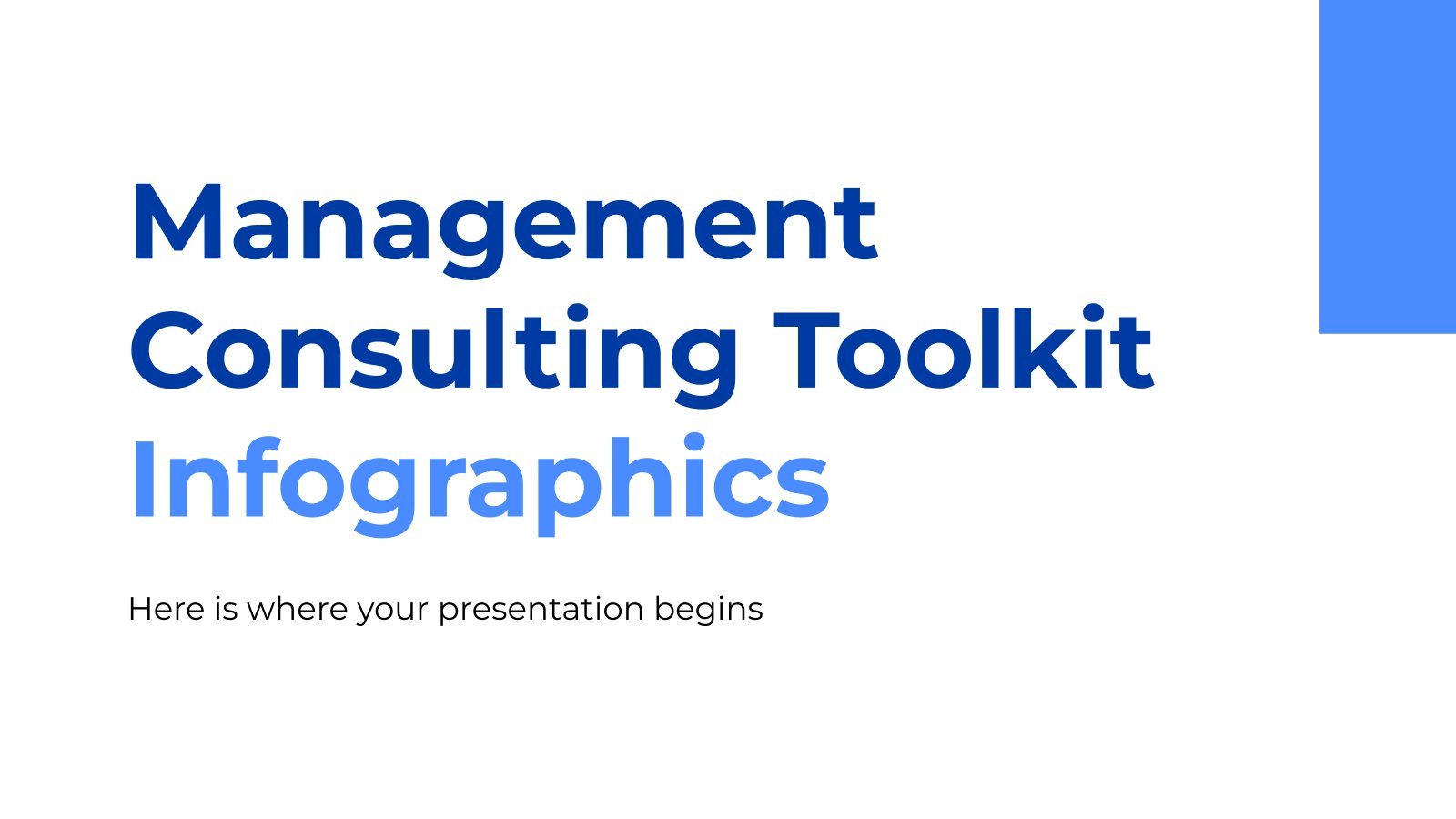
Management Consulting Toolkit Infographics
Download the Management Consulting Toolkit Infographics template for PowerPoint or Google Slides and discover the power of infographics. An infographic resource gives you the ability to showcase your content in a more visual way, which will make it easier for your audience to understand your topic. Slidesgo infographics like this...

Artistic Serif Fonts Business Basic Template
Download the Artistic Serif Fonts Business Basic Template presentation for PowerPoint or Google Slides. The world of business encompasses a lot of things! From reports to customer profiles, from brainstorming sessions to sales—there's always something to do or something to analyze. This customizable design, available for Google Slides and PowerPoint,...

Law Consulting Sales Pitch
To ensure that people act according to what they’re allowed to do, law consulting firms offer their helpful legal services. When it comes to demonstrating your strong points and attracting new clients, there’s nothing like a sales pitch, and this new free business template is cut out for that job.

Technology Consulting
If you want to attract new clients to your technology company and to keep them satisfied, design your own consulting sales pitch with these minimalistic slides.

Internship Report
Download the "Internship Report" presentation for PowerPoint or Google Slides. The world of business encompasses a lot of things! From reports to customer profiles, from brainstorming sessions to sales—there's always something to do or something to analyze. This customizable design, available for Google Slides and PowerPoint, is what you were...

KPI Measurement Tool Pitch Deck
Download the KPI Measurement Tool Pitch Deck presentation for PowerPoint or Google Slides. Whether you're an entrepreneur looking for funding or a sales professional trying to close a deal, a great pitch deck can be the difference-maker that sets you apart from the competition. Let your talent shine out thanks...

Investment Company Business Plan
A business plan sets the strategy, resources, goals and plans for your company. If you focus on using money to fund new projects, get huge returns, make ideas possible and getting new forms of income, this template for investment companies is the one that best will reflect your ideals! With...
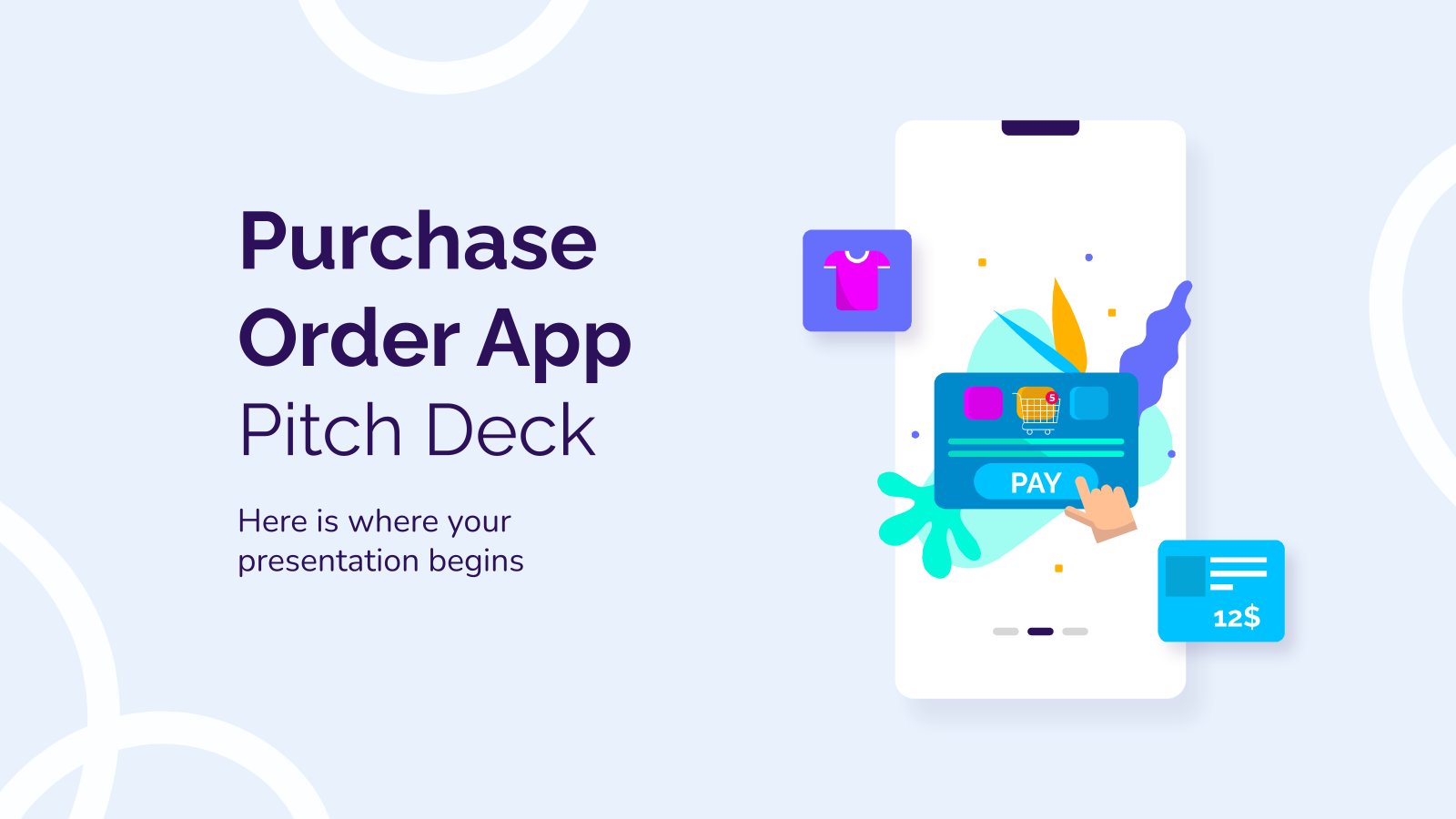
Purchase Order App Pitch Deck
Download the Purchase Order App Pitch Deck presentation for PowerPoint or Google Slides. Whether you're an entrepreneur looking for funding or a sales professional trying to close a deal, a great pitch deck can be the difference-maker that sets you apart from the competition. Let your talent shine out thanks...
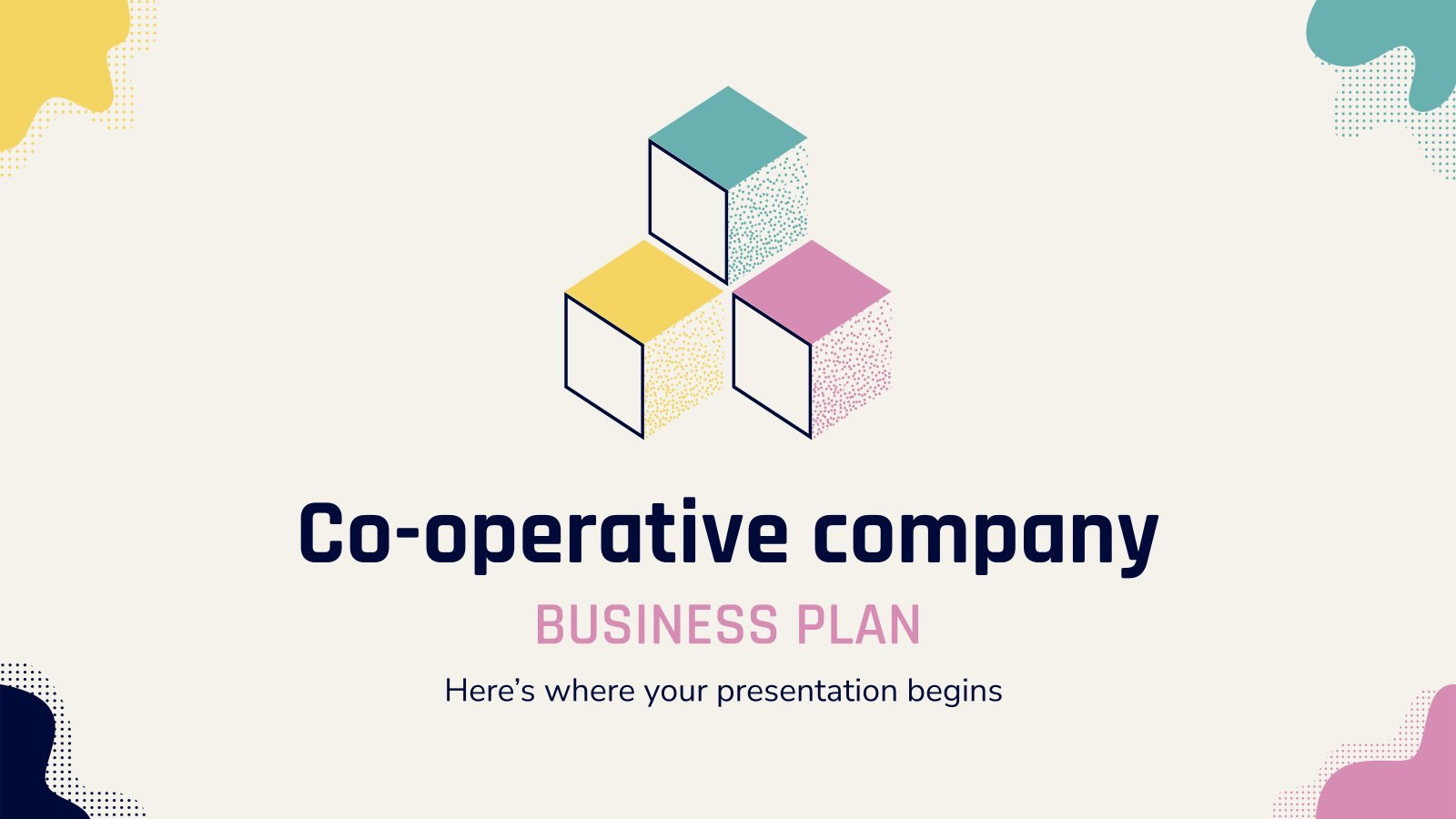
Co-operative Company Business Plan
Having a good business plan can open many doors. At Slidesgo we know that, and that’s why we have created this co-operative company business plan, to help you structure your information. Start with an overview of market trends and competitors. Then edit the graphs to talk about your potential clients...
- Page 1 of 326
Great presentations, faster
Slidesgo for Google Slides :
The easy way to wow

Register for free and start editing online

English (USA)
English (UK)
English (Canada)
English (India)
Deutsch (Deutschland)
Deutsch (Österreich)
Deutsch (Schweiz)
Français (France)
Français (Suisse)
Nederlands (Nederland)
Nederlands (België)
- Top Capitalization
- United States
- North America
- Middle East
- Sector Research
- Earnings Calendar
- Equities Analysis
- Most popular
- AMD (ADVANCED MICRO DEVICES)
- NIPPON ACTIVE VALUE FUND PLC
- TESLA, INC.
- DEUTSCHE TELEKOM AG
- TAIWAN SEMICONDUCTOR MANUFACTURING COMPANY LIMITED
- META PLATFORMS, INC.
- Index Analysis
- Indexes News
- EURO STOXX 50
- Currency Cross Rate
- Currency Converter
- Forex Analysis
- Currencies News
- Precious metals
- Agriculture
- Industrial Metals
- Livestock and Cattle
- CRUDE OIL (WTI)
- CRUDE OIL (BRENT)
- Developed Nations
- Emerging Countries
- South America
- Analyst Reco.
- Capital Markets Transactions
- New Contracts
- Profit Warnings
- Appointments
- Press Releases
- Security Transactions
- Earnings reports
- New markets
- New products
- Corporate strategies
- Legal risks
- Share buybacks
- Mergers and acquisitions
- Call Transcripts
- Currency / Forex
- Commodities
- Cryptocurrencies
- Interest Rates
- Asset Management
- Climate and ESG
- Cybersecurity
- Geopolitics
- Central Banks
- Private Equity
- Business Leaders
- All our articles
- Most Read News
- All Analysis
- Satirical Cartoon
- Today's Editorial
- Crypto Recap
- Behind the numbers
- All our investments
- Asia, Pacific
- Virtual Portfolios
- USA Portfolio
- European Portfolio
- Asian Portfolio
- My previous session
- My most visited
- Multibaggers
- Growth stocks
- Undervalued stocks
- Yield stocks
- Dividend Aristocrats
- Strategic Metals
- Cannibal companies
- Israeli innovation
- Let's all cycle!
- Unusual volumes
- New Historical Highs
- New Historical Lows
- Top Fundamentals
- Sales growth
- Earnings Growth
- Profitability
- Rankings Valuation
- Enterprise value
- Top Consensus
- Analyst Opinion
- Target price
- Estimates Revisions
- Top ranking ESG
- Environment
- Visibility Ranking
- Stock Screener Home
- Powerful brands
- Space Exploration
- Gold and Silver
- Oversold stocks
- Overbought stocks
- Close to resistance
- Close to support
- Accumulation Phases
- Most volatile stocks
- Top Investor Rating
- Top Trading Rating
- Top Dividends
- Low valuations
- All my stocks
- Stock Screener
- Stock Screener PRO
- Portfolio Creator
- Event Screener
- Dynamic Chart
- Economic Calendar
- Our subscriptions
- Our Stock Picks
- Thematic Investment Lists
Nihon Kohden Corporation
Jp3706800004, advanced medical equipment & technology.
- Nihon Kohden : Three-year Business Plan (Presentation) (May 13, 2024)
Three-year Business Plan
May 15, 2024
- Long-term Vision
Review of Previous Three-year Business Plan
- BEACON 2030 Phase II
- Business Environment and Key Measures
- Capital Efficiency
- Sustainability
- Management Targets
- Capital Allocation
Long-term Vision and Three-year Business Plan
We contribute to the world by fighting disease and improving health with advanced technology, and create a fulfilling life for our employees.
Create a better future for people and healthcare by
Management solving global medical issues
Business Plan
Core Values
Apr. 2027 - Mar. 2030 Phase Ⅲ : Realize BEACON 2030
Apr. 2024 - Mar. 2027 Phase Ⅱ : Invest for growth
Apr. 2021 - Mar. 2024 Phase Ⅰ : Strengthen foundation
Core values are shared by Nihon Kohden staff worldwide, helping to connect them and contributing to the promotion of our Management Philosophy, Long-term Vision, and Three-year Business Plan.
Integrity / Humbleness / Diversity / Initiative / Customer Centric / Goal Oriented / Creativity
Three Transformation for BEACON 2030
- Promote overseas business strategies emphasizing high growth and improved profitability
- Develop sophisticated value propositions and cultivate new businesses areas in domestic business
- Create new business models by utilizing our global business foundation
- Create a business model that helps solve medical issues
- Realize a value creation model that creates value from data, by utilizing our core strength in Human Machine Interface * technology
- Establish an organizational and governance system in line with our corporate strategy
- Establish a development, production and sales system based on Global Supply Chain Management
- Strengthen global business deployment capabilities by establishing a Center of Excellence
- Human machine interface is the user interface that connects human and machine. For Nihon Kohden, this refers to sensor technology, signal processing technology, and data analysis technology.
Three Phase of BEACON 2030
- Improve the profitability of existing businesses by increasing productivity through optimization of globally expanded resources
- Cultivate new business areas and business models
Changes after setting the Long-term Vision
- Inventories of finished goods and parts increased due to supply chain disruptions.
- COGS and SG&A expenses increased due to inflation.
- R&D of new products delayed due to compliance with laws and regulations related to medical equipment.
- Implement the reform of the profit structure and make investments in growth areas
- Establish new business models and collaborate with existing businesses to strengthen our comprehensive capabilities in problem-solving
- Achieve profitability of new business models and realize a business platform that can create sustainable value
- Establish a position as a solution provider that helps solve global medical issues
Management Index for BEACON 2030
Domestic Sales
Overseas Sales
(Overseas Sales Ratio)
Consumables and
Services Sales Ratio
Gross Profit Margin
Operating Income
(Operating Income Margin)
Income Attributable to
Owners of Parent
FY2023 Targets
¥102 to the U.S. dollar, ¥124 to the euro
48% or more
50% or more
FY2023 Revised Forecast
¥139 to the U.S. dollar, ¥151 to the euro
¥142.0 bil ¥79.5 bil
FY2023 Results
¥143.9 to the U.S. dollar, ¥156.8 to the euro
¥142.3 bil ¥79.6 bil
[Difference in domestic sales]
- Expansion of consumables and services business
- Price optimization
- Creation of customer value propositions
[Difference in overseas sales]
[Americas] In North America, a large order of patient monitors was postponed to FY2024 and the cycle from order to delivery and installation has become longer. [Europe] Impact of export restrictions to Russia.
[Asia & Other] Move to prefer domestically produced products in China and Indonesia. Impact of the anti-corruption campaign in China.
Actual increase in sales, favorable product mix, price optimization
Attachments
- Original Link
- Original Document
Nihon Kohden Corporation published this content on 13 May 2024 and is solely responsible for the information contained therein. Distributed by Public , unedited and unaltered, on 13 May 2024 10:11:39 UTC .
Latest news about Nihon Kohden Corporation
Chart nihon kohden corporation.
Company Profile
Income statement evolution, ratings for nihon kohden corporation, analysts' consensus, eps revisions, quarterly earnings - rate of surprise, sector other advanced medical equipment & technology.
- Stock Market
- News Nihon Kohden Corporation
- Share full article
Advertisement
Supported by
Comcast Plans Streaming Bundle With Netflix and Apple TV+
The bundle, called StreamSaver, is the latest joint effort from entertainment companies looking to woo price-weary customers.

By Benjamin Mullin
Comcast, the parent company of NBCUniversal, is planning to offer its streaming service Peacock in a bundle with Netflix and Apple TV+, Brian Roberts, the company’s chief executive, said at an investor conference on Tuesday.
Called StreamSaver, the bundle will be sold at a deep discount compared with subscribing to all three services separately, Mr. Roberts said. He didn’t specify a price for the service, which is expected to debut this month.
“We’ve been bundling video successfully and creatively for 60 years,” Mr. Roberts said. “This is the latest iteration of that. And I think this will be a pretty compelling package.”
Over the past year, several entertainment companies have joined forces to entice customers who are weary of signing up and paying for numerous individual streaming services.
Warner Bros. Discovery, Fox and Disney announced this year that they were teaming up to offer a streaming service with games from the National Basketball Association and the National Football League. Last week, Disney and Warner Bros. Discovery said they would bundle their streaming services, selling users a package that included Disney+, Hulu and Max.
Comcast has long offered its users a menu of streaming services on Xfinity, its package of services that includes cable television and broadband internet. For years, the company has offered services like Netflix and Apple TV+ as add-ons to its existing television bundle, acting as a vendor for those companies. This is the first time that Comcast will offer both services as part of a discounted bundle.
Comcast, which has millions of broadband and cable television customers across the United States, has different incentives to bundle streaming services than many of its competitors have. If Comcast can give its customers additional reasons to stick with the company, or persuade them to pay for more features through Xfinity, the effort to bundle services will have been worth it.
Many other internet providers have sold bundles that include streaming services. When Disney+ launched, Verizon offered a promotional bundle with that service. When the short-lived, short-form streaming service Quibi launched, T-Mobile offered to bundle its wireless offering with that service.
Comcast has been willing to spend big to gain a foothold in the competitive video streaming business. Peacock, which launched in 2020, lost $2.7 billion last year, Comcast said in a filing, but paying subscribers increased to 31 million. The company has said Peacock’s losses were narrowing as the service matured.
Benjamin Mullin reports on the major companies behind news and entertainment. Contact Ben securely on Signal at +1 530-961-3223 or email at [email protected] . More about Benjamin Mullin

IMAGES
VIDEO
COMMENTS
Apple Market Cap as of June 2023 - source Apple's Product Strategies After the Launch of the iPhone. After the launch of the first-generation iPhone, the company's product strategy was very clear, i.e., ' Design a high-end smartphone in which the user experience is more important than making a slew of features available.'. The iPhone was not the first smartphone to have a mobile Web ...
Apple's Strengths. Pricing Strategy: Apple's high prices makes it possible for the company to sell a small number of products and still rake in a large amount of revenue;; Subscription Services: The company's subscription services and the principles of the subscription business model enables Apple to have a predictable chunk of revenue;; Performance: Apple's insistence on rolling out ...
Apple is well-known for its innovations in hardware, software, and services. Thanks to them, it grew from some 8,000 employees and $7 billion in revenue in 1997, the year Steve Jobs returned, to ...
Download This 100% Editable Apple Pitch Deck Presentation. Slide 6: An Effectively Designed Slide That Will Determine the Profitable Business Model for Your Company. Apple is an entirely customer-centric brand & their business model emphasize two elements: "Every innovation should come from the customer.
Apple has a business model that is divided into products and services. Apple generated over $394 billion in revenues in 2022, of which $205.5 came from iPhone sales, $40 billion came from Mac sales, over $41 billion came from accessories and wearables (AirPods, Apple TV, Apple Watch, Beats products, HomePod, iPod touch, and accessories), $29.3 billion came from iPad sales, and $78.13 billion ...
The billions of people who use Facebook are affected by Apple's strategy to squeeze more cash from apps. Companies have also said that they felt forced to charge people money in their iPhone ...
Apple's corporate strategy - one of creativity, innovation, and the pursuit of excellence - can be summarised in its mission and vision statements: Apple is dedicated to the empowerment of man—to making personal computing accessible to each and every individual so as to help change the way we think, work, learn, and communicate. Man is ...
An agile strategy is a wait-and-see approach that involves monitoring consumer demand and market trends before developing and launching a particular product. The lean supply chain strategy of Apple has been demonstrated in several of its product launches. These include the introduction of the iMac and the Mac OS in 1998, the launching of the ...
Business Model Canvas. Business Models. Technology. Margin Masters. In 2007, apple launches the iPhone and combines an internet browser, a music player, and a mobile phone in one high-end, multitouch device without a keyboard. It ushers in the era of the smartphone. In 2007, Apple founder Steve Jobs famously introduced the iPhone at the ...
Apple's business model is hugely cash generative. It makes more profits and has a stronger cash flow than Amazon, Google and Facebook combined. Apple's $60B of TTM operating income was nearly 50% more than the combined operating income of Alphabet ($24B), Facebook ($15), and Amazon ($3B). Above Avalon. (C) Statista.
Apple at Work Work as one. Or one thousand. Apple hardware, software, and services work together to give you and your employees the power and flexibility to do whatever needs doing — whether you're a small business or an enterprise.
Apple
Apple Inc Business Strategy. Mar 25, 2016 • Download as PPTX, PDF •. 8 likes • 5,404 views. AI-enhanced description. Abirami V Veeramani. Steve Jobs and Steve Wozniak started Apple Computer in Jobs' garage in 1976. They built one of the first personal computers, the Apple I, and later introduced the Apple II in 1977, which became very ...
Download this amazing free Apple template and create a lasting impression on your audience. Unlock the world of creativity with these captivating "Apple Elegance" themes - a tribute to the innovative spirit of Apple Inc. This free Apple presentation template is a perfect blend of sleek design and intuitive functionality, embodying the ...
Original apple business plan. Feb 12, 2012 • Download as PPT, PDF •. 154 likes • 104,596 views. A. akdiamond. The original business plan from Apple. Education. 1 of 7.
Running head: MARKETING PLAN FOR AP PLE 1. Marketing Plan for Apple Incorporation. Rommy Odaymat. W alsh University. MARKETING PLAN FOR A PPLE 2. Apple Inc. 1.0 Executive Summary. Apple Inc. is an ...
The slide includes approaches followed by apple and Huawei to accomplish success. Present the topic in a bit more detail with this Market Penetration Strategy How Apple And Huawei Successfully Accomplished Goals Strategy SS V. Use it as a tool for discussion and navigation on Company, Ensure Product, Business Models.
Business Essentials. One complete subscription that seamlessly brings together device management, 24/7 support, and cloud storage. With Apple Business Essentials, your small business can easily manage every iPhone, iPad, Mac, and Apple TV — every step of the way. Try it free Watch the film. Try it free.
Jobs, who had been ousted from the company in 1985, returned to become Apple's CEO in 1996 after his company NeXT was bought by Apple Inc. Today, Apple is the largest technology firm in the world, with annual revenues of more than $60 billion. The company headquarters is in Cupertino, California, CEO and co-founder is Steve Jobs and the company ...
Apple iPad Business Plan. Apr 14, 2012 • Download as PPTX, PDF •. 43 likes • 22,562 views. AI-enhanced description. Stathis Simeonidis. Apple is launching the iPad tablet to capitalize on the growing tablet market. The iPad will leverage Apple's strong brand perception and reputation for quality and innovation.
It's time to create your new business presentation, and it's easier than you may think with Renderforest. Follow the below quick steps to create the actual presentation of a business plan to your potential investors to secure funding. Step 1. Choose a Business Plan Presentation Template.
Business • February 2nd, 2024. A vital element in today's highly competitive business landscape is the ability to craft and deliver a business plan presentation. This applies to both entrepreneurs and corporate leaders. This guide describes essential aspects required to build a business plan presentation and deliver it to stakeholders.
Pick and choose any and all of the slides you need to use in your business plan presentation. You can also bring in slides that you've previously saved to your slide library to help customize your presentation even further. 3. Customize the Template. Lastly, customize your template's font and color.
Engage your audience in your business presentations with our free customizable PPT templates and Google Slides themes. They're perfect for business plans, office meetings, pitch decks or project proposals. ... A business plan sets the strategy, resources, goals and plans for your company. If you focus on using money to fund new projects, get ...
Strengthen global business deployment capabilities by establishing a Center of Excellence. Human machine interface is the user interface that connects human and machine. For Nihon Kohden, this refers to sensor technology, signal processing technology, and data analysis technology. Three‐year Business Plan. 2024‐2026.
The strategic framework template simplifies the process by allowing you to define precise objectives and track the progress of three key results associated with each objective. Using this strategic plan template, you can streamline goal management and enhance productivity. 6. General Strategic Plan Template.
May 14, 2024 Pre-RFP Meeting: TPP Division Border Transportation Master Plan (BTMP) Development & Support Solicitation No. 601CT0000005788 RFP 50- 4RFP5100
When the compressor rises, it reveals Apple's latest commodity: the updated iPad Pro. Tim Cook, Apple's chief executive, posted the advertisement, called "Crush," on Tuesday after the ...
15 May 2024. Global United States. Link copied to clipboard. At Netflix's second Upfront presentation to advertisers, the message was clear: When you advertise with Netflix, you can reach the most engaged audience in the world. Advertising Growth. Amy Reinhard, Netflix's President of Advertising, walked advertisers through the continued ...
May 14, 2024. Comcast, the parent company of NBCUniversal, is planning to offer its streaming service Peacock in a bundle with Netflix and Apple TV+, Brian Roberts, the company's chief executive ...